INTRODUCTION BY GEOFF BURCH
Since writing about my experiences on the footplate at Guildford shed (70C) the question I am constantly being asked is...when am I'm going write some more? This got me thinking. Although I retired from the railway a couple of years ago I have always remained good friends with dozens of ex-work colleagues, all of whom have their own story to tell.
So when I started on this first webpage of 'BR Southern Region Railwaymens' Memories' I'm delighted to  say that several volunteers stepped forward to contribute their own experiences on the footplate. Each and every one is a repository of stories, and I'm not talking here about the shallow celebrity-status culture that seems to pervade today's society; even the most humble, retiring railwaymen have a unique tale to tell. The problem is who do they tell their story to? If no one is prepared to record their lifetime memories it is more than likely that their railway stories will be lost forever to future generations. But then can you imagine what it must be like to reveal treasured memories to someone they can trust to tell it as it was? Railwaymen love to talk about the old days, particulary amongst themselves, exchanging idle chat about a moment in their careers, such as Pat Kinsella's story of the Snodland cement train (the first of his stories below).
say that several volunteers stepped forward to contribute their own experiences on the footplate. Each and every one is a repository of stories, and I'm not talking here about the shallow celebrity-status culture that seems to pervade today's society; even the most humble, retiring railwaymen have a unique tale to tell. The problem is who do they tell their story to? If no one is prepared to record their lifetime memories it is more than likely that their railway stories will be lost forever to future generations. But then can you imagine what it must be like to reveal treasured memories to someone they can trust to tell it as it was? Railwaymen love to talk about the old days, particulary amongst themselves, exchanging idle chat about a moment in their careers, such as Pat Kinsella's story of the Snodland cement train (the first of his stories below).
Within every railway community across the length and breadth of Britain there must be many memories similar to Pat's - as well as so many more left unspoken, often because they're so preposterous that you couldn't make it up! Pat Kinsella's fox hunting story further down the page is a classic example...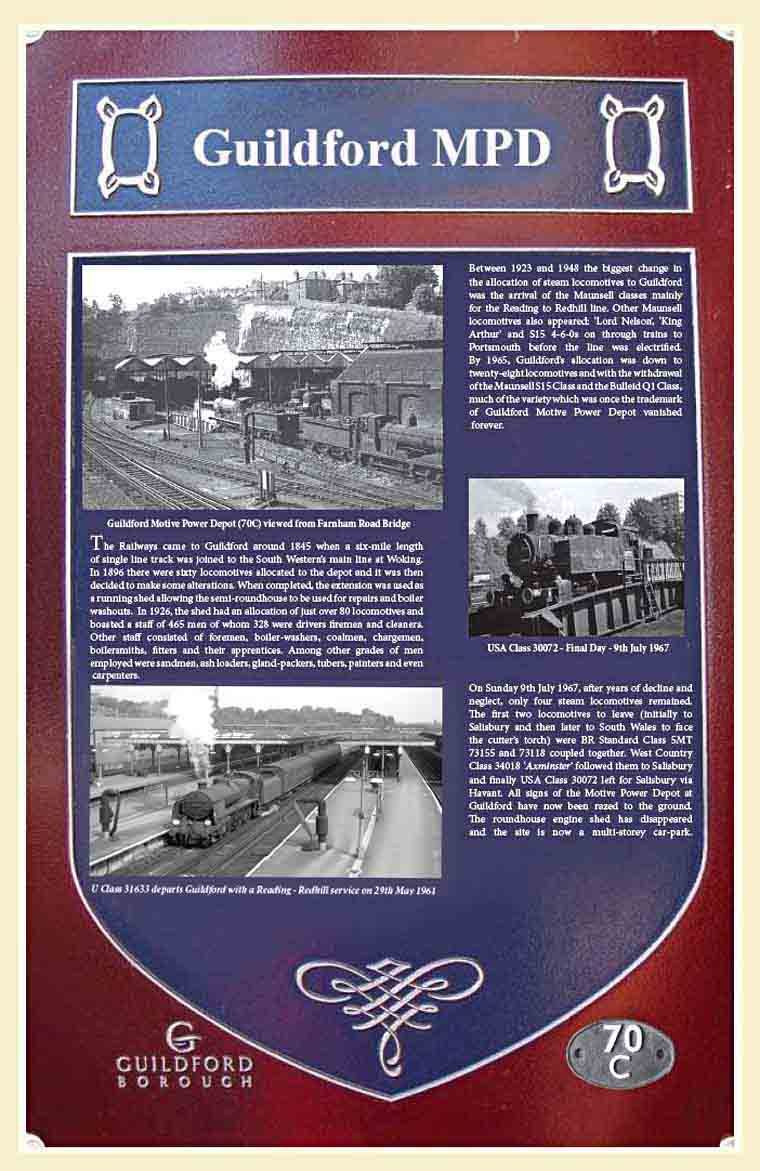
(Above) The 50th Anniversary of the closure of Guildford Motive Power Depot and the end of steam on the Southern Region. Retired railwaymen and steam fans gathered on Farnham Road bridge on Sunday morning, July 9 2017, for the unveiling of a plaque by Richard Greenwood MBE to commemorate Guildford engine shed which closed exactly 50 years ago. Further details can be found on page 32. 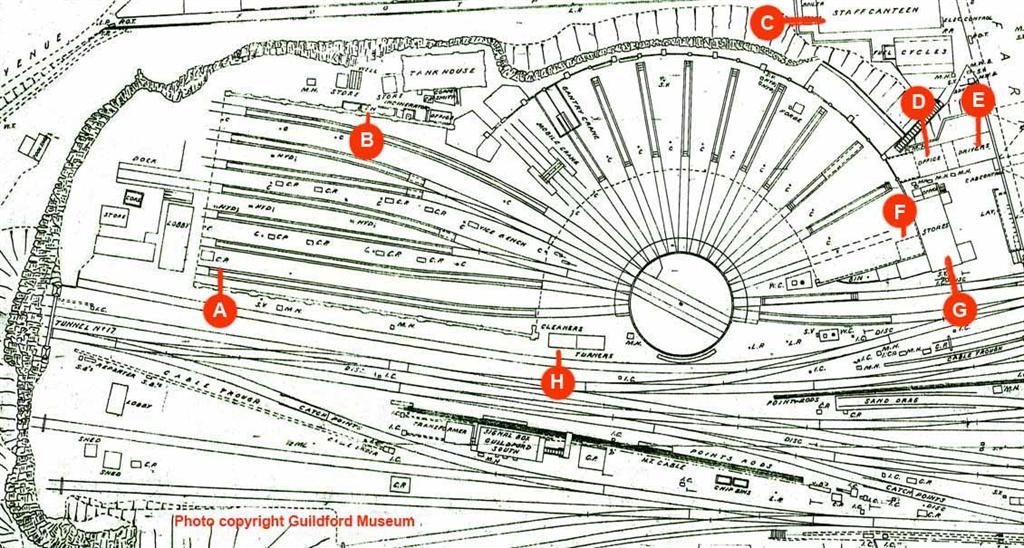
(Above) Map of Guilford Loco 70C courtesy of Guilford Museum. The pointers on the map (clockwise) show 'A' Siding for the Breakdown Crane and Coaches - quite often called out for any 'off the road' mishaps. The 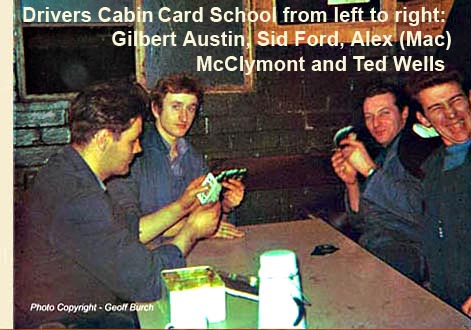 breakdown crew was made up of shed staff and fitters, and the Shedmaster would nearly always accompany the breakdown crew to the incident - 'B' is the location of the Weaver Shed (between Number 1 & 2 Road of the New Shed) as described in Pat Kinsella's witty account of the Weaver Operator - 'C' is where the sand furnace was situated - the sand had to be thoroughly dried before being emptied into the locomotives sandboxes otherwise it wouldn't be able to trickle out onto the rails when operated by the fireman - 'D' The staff canteen was situated here - many a railway yarn was exchanged here over a cup of tea! - 'E' Locker Room - 'F' The Running Foreman's office where I spent many an hour as an office boy before I became a fireman. It was here that Running Foremen such as Fred Price, Harry Harvey and Jack Clements and acting Running Foreman Frank Chudley. Roy Brewer and Cyril Tillman were to follow along with other Acting Running Foremen - Derek Hayter, Ted Maynard, Berni Gray, Reg Beer, Ray Beeson, John
breakdown crew was made up of shed staff and fitters, and the Shedmaster would nearly always accompany the breakdown crew to the incident - 'B' is the location of the Weaver Shed (between Number 1 & 2 Road of the New Shed) as described in Pat Kinsella's witty account of the Weaver Operator - 'C' is where the sand furnace was situated - the sand had to be thoroughly dried before being emptied into the locomotives sandboxes otherwise it wouldn't be able to trickle out onto the rails when operated by the fireman - 'D' The staff canteen was situated here - many a railway yarn was exchanged here over a cup of tea! - 'E' Locker Room - 'F' The Running Foreman's office where I spent many an hour as an office boy before I became a fireman. It was here that Running Foremen such as Fred Price, Harry Harvey and Jack Clements and acting Running Foreman Frank Chudley. Roy Brewer and Cyril Tillman were to follow along with other Acting Running Foremen - Derek Hayter, Ted Maynard, Berni Gray, Reg Beer, Ray Beeson, John 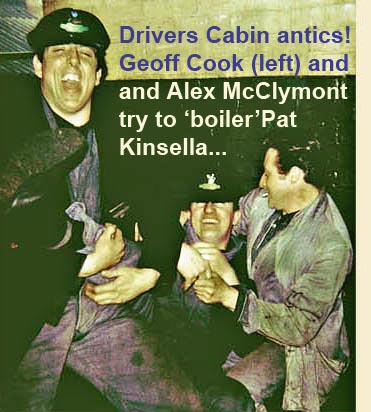 Carter, Vic Pratt, John Berriman, Arthur Streatfield and Peter Bunce to name just a few! - 'G' Ambulance Room - minor incidents such as burns and scalds etc were dealt with here; anything of a more serious nature was dealt with by the Royal Surrey County Hospital in the Farnham Road, only a couple of hundred yards away - 'H' The Driver's Cabin; it was tiny considering the amount of men at the depot. The room contained one belfast sink and an old coke fired boiler that heated the water for washing purposes and for the Running Foreman's office radiators. The hot water cylinder above the boiler had asbestos insulation that had worn away to expose the white asbestos. Playful larking about would often occur and the object of the exercise was to place your opponent against the white area of asbestos which would adhere to their black serge jacket - hence the term being boilered! There were two small tables and two bench seats either side which wasn't exactly what
Carter, Vic Pratt, John Berriman, Arthur Streatfield and Peter Bunce to name just a few! - 'G' Ambulance Room - minor incidents such as burns and scalds etc were dealt with here; anything of a more serious nature was dealt with by the Royal Surrey County Hospital in the Farnham Road, only a couple of hundred yards away - 'H' The Driver's Cabin; it was tiny considering the amount of men at the depot. The room contained one belfast sink and an old coke fired boiler that heated the water for washing purposes and for the Running Foreman's office radiators. The hot water cylinder above the boiler had asbestos insulation that had worn away to expose the white asbestos. Playful larking about would often occur and the object of the exercise was to place your opponent against the white area of asbestos which would adhere to their black serge jacket - hence the term being boilered! There were two small tables and two bench seats either side which wasn't exactly what 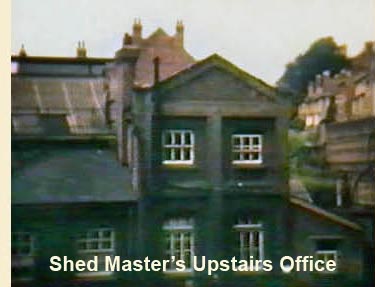 you'd call luxury! Plus there would always be a card school playing either 'Beenies', Solo or at worst Three Card Brag. I've seen men bid £5 blind and that was a lot of money to win (or lose) in the 1960s! - 'I' shows the viewing point of the Stores hatch (as seen in David Salmon's photo gallery below) where you could obtain anything from cleaning cloths and oil to gentlemen's toiletries if you know what I mean - 'Anything for the weekend, Sir?' - 'J' The Shedmaster's office (above the stores on the first floor). Mr George Stovold was the Shedmaster when I joined in 1961 and when he retired in 1962, the position was filled by Mr John Butt. He was superseded by Mr Arthur Coe who moved to Woking to become the Depot Master there when Guildford depot closed in July 1967 - and finally 'K' is the Cleaner's Cabin where I first started work in April 1961. The adjoining building was occupied by the Turning Gang and the Steamraisers.
you'd call luxury! Plus there would always be a card school playing either 'Beenies', Solo or at worst Three Card Brag. I've seen men bid £5 blind and that was a lot of money to win (or lose) in the 1960s! - 'I' shows the viewing point of the Stores hatch (as seen in David Salmon's photo gallery below) where you could obtain anything from cleaning cloths and oil to gentlemen's toiletries if you know what I mean - 'Anything for the weekend, Sir?' - 'J' The Shedmaster's office (above the stores on the first floor). Mr George Stovold was the Shedmaster when I joined in 1961 and when he retired in 1962, the position was filled by Mr John Butt. He was superseded by Mr Arthur Coe who moved to Woking to become the Depot Master there when Guildford depot closed in July 1967 - and finally 'K' is the Cleaner's Cabin where I first started work in April 1961. The adjoining building was occupied by the Turning Gang and the Steamraisers.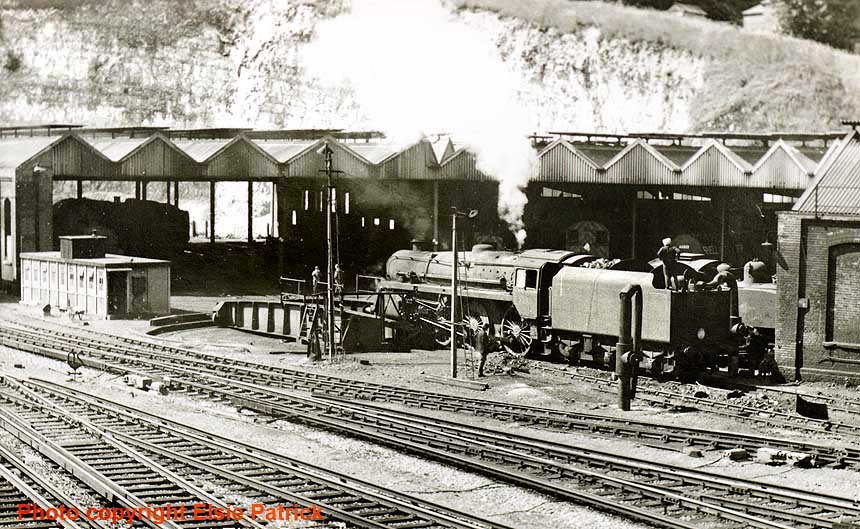
Following the success of Geoff Burch's first book 'The Ramblings of a Railwayman' published in 2011 - the 1,000 copies sold out very quickly! Geoff has decided to self-publish a fully revised 2nd edition, lavishly 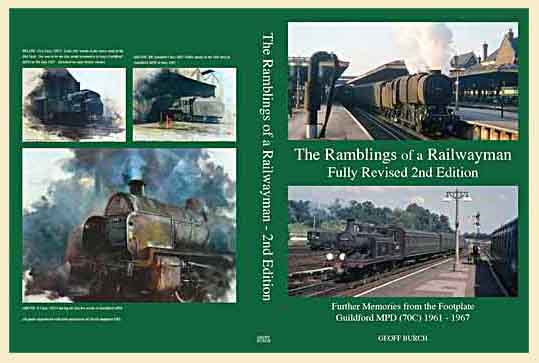 illustrated with many previously unpublished photographs kindly supplied by Peter Trinder, the late Dave Salmon and Richard S Greenwood MBE. Even though the production costs of a revised 2nd Edition have increased, Geoff has decided to keep to the original price of £20 a copy. However, only a limited number of books will be printed and each one will have a hand-embossed 'Rambling Railwayman Books 70C' crest on the inner cover (with the Author's signature if required) which will make each one especially unique. The book will become available in early April 2016, however demand is expected to be high, so it is advisable to pre-order your copy to avoid disappointment.
illustrated with many previously unpublished photographs kindly supplied by Peter Trinder, the late Dave Salmon and Richard S Greenwood MBE. Even though the production costs of a revised 2nd Edition have increased, Geoff has decided to keep to the original price of £20 a copy. However, only a limited number of books will be printed and each one will have a hand-embossed 'Rambling Railwayman Books 70C' crest on the inner cover (with the Author's signature if required) which will make each one especially unique. The book will become available in early April 2016, however demand is expected to be high, so it is advisable to pre-order your copy to avoid disappointment.
Please contact Geoff via his email address: ramblingrailwayman@gmail.com for further details.
(Below) Geoff's old 'mucker' Pat Kinsella on the footplate of BR Standard Pacific 70000 Britannia.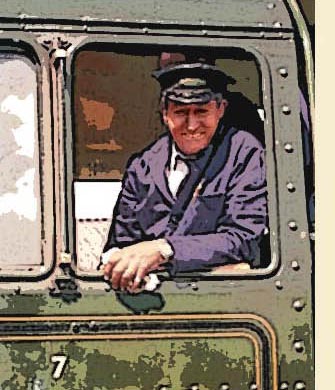 As I remember it, the generation of railwaymen I encountered in steam days didn't moan, or complain that they were owed anything, they simply got on with the job, yet the reminiscences of working class people are seldom considered to be part of important history. What rubbish! Having set about the task of recording several railwaymen's experiences for posterity, it turns out that their everyday lives were far from ordinary - and let me be perfectly honest about this, when the time comes to leave us, as they must; as we all must at the end of the day - the memories they leave behind are beyond price. The result is 'More Memories of Guildford Shed'...I hope this page gives you as much enjoyment as we have had compiling it.
As I remember it, the generation of railwaymen I encountered in steam days didn't moan, or complain that they were owed anything, they simply got on with the job, yet the reminiscences of working class people are seldom considered to be part of important history. What rubbish! Having set about the task of recording several railwaymen's experiences for posterity, it turns out that their everyday lives were far from ordinary - and let me be perfectly honest about this, when the time comes to leave us, as they must; as we all must at the end of the day - the memories they leave behind are beyond price. The result is 'More Memories of Guildford Shed'...I hope this page gives you as much enjoyment as we have had compiling it.
So, having got the introduction out of the way, we start and finish this page with some wonderful stories of steam days at Guildford Loco by ex-driver, Pat Kinsella. I first met Pat in 1961 when I started work as a 15 year-old engine cleaner at 70C. It was the start of a great friendship that lasted throughout our railway careers and still continues today - here is the first of Pat's memories of his days at Guildford MPD....
(Above-Below) HELP! I have recently been contact by Nic Greene, a volunteer at the Watercress Line, who is in the process of making a short video to promote awareness of, and hopefully raise funds towards, the overhaul of Merchant Navy No 35005 Canadian Pacific and he is desperately trying to find 30-plus seconds of mainline footage of Merchant Navy locos, in particular 35005, from the 1950-60 period. If anyone has any footage or ideas for sources he would be very pleased to receive them. If you can help Nic (who goes by the name of 'geralldus' on YouTube) he can be contacted at n.greene@blueyonder.co.uk Please note this is not a clickable link via Outlook Express; you will have to email manually. Many thanks in anticipation… 
The Snodland Cement
by Pat Kinsella
There was a time when Guildford men worked a heavy overnight freight from Redhill to Reading; this train originated at Snodland near Maidstone in Kent. The diagrams involved one pair of Guildford men finishing 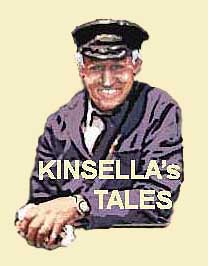 their duty by working the train as far as Guildford, where the men were relieved by another Guildford crew who worked the train forward to Reading. It then continued up country with another locomotive.
their duty by working the train as far as Guildford, where the men were relieved by another Guildford crew who worked the train forward to Reading. It then continued up country with another locomotive.
The Reading to Redhill section was usually worked by an 'N' Class locomotive, the maximum load for the road being equal to sixty wagons. The cement train consisted largely of box wagons that were loaded with one hundred-weight bags of cement. The mantra was - 'If you can get them up Reigate bank then you can get them up Pinks Hill Guildford...'
But not always so!
Guildford crews often complained that the train was seriously overloaded but their protests fell on deaf ears. After stopping at Guildford to change crews and take water it was a dead start from the platform. In the normal way the departure from Guildford was accompanied by the roar of the locomotive's exhaust beat which could be heard clearly for a radius of several miles in the early hours. Alas, there were times when the load was too much for the 'N' Class and she would come to a stand on the gradient, usually at a point just past the Guildford bypass bridge (the A3 road as it is today).The procedure then was for the train to set back into Guildford Up Yard and uncouple some wagons.
As the maximum load permitted for an 'N' Class from Guildford Yard was equal to forty eight wagons, some of the wagons had to be left behind. It was therefore decided to alter the crew diagrams from changing 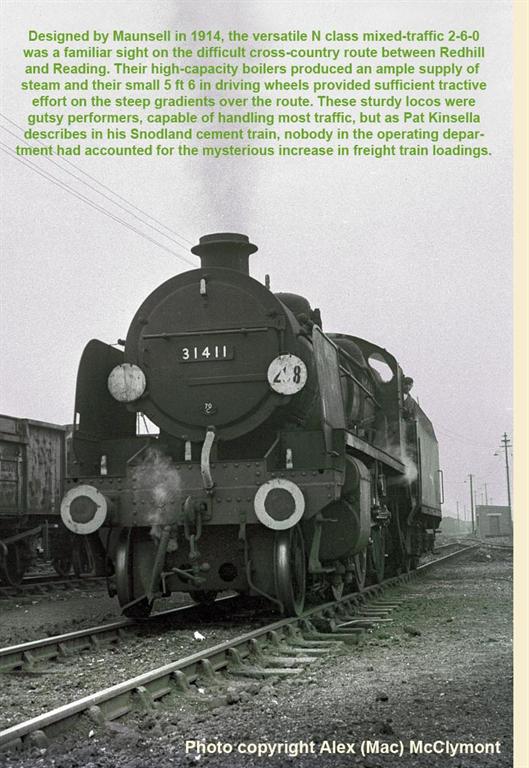 crews at Guildford to the changeover taking place at Shalford, some two miles east of Guildford - the idea being to run through Guildford without stopping and take a run at Pinks Hill bank. An experimental run was arranged on which a Footplate Inspector accompanied the crew to Reading, but on the first morning's run the Inspector failed to show up because he had overslept; and the train still got stuck up the bank!
crews at Guildford to the changeover taking place at Shalford, some two miles east of Guildford - the idea being to run through Guildford without stopping and take a run at Pinks Hill bank. An experimental run was arranged on which a Footplate Inspector accompanied the crew to Reading, but on the first morning's run the Inspector failed to show up because he had overslept; and the train still got stuck up the bank!
The second morning at about 3am, everyone in Guildford loco gathered to witness another attempt. With water having been taken at Shalford, a 'positive' Driver on the 'regulator, a good fireman on the shovel and an Inspector in jubilant mood, the locomotive moved forward; slowly at first as she passed under the war-damaged Shalford bridge, then the 'N' Class was soon into her stride with first regulator and the lever in the 'corner'.
Meanwhile a group of Guildford loco staff, myself included, had assembled by the turntable with great expectations to witness the 'Dover' passing through. Soon we could hear the distinct sound of the two cylinder beat echoing through the tunnel as the 'N' Class crossed over Shalford Junction, then having cleared the 20mph crossovers we could sense the regulator being put into the second valve, the cut off being about 65%. Through clear early morning air, it was exciting to hear the beautiful beat of this two cylinder engine as she entered the south portal of St. Catherine's tunnel, then again the roar of the exhaust in between tunnels before plunging into the longer Chalk tunnel.
What would this driver do? A permanent speed restriction of 20 miles per hour from the London end of Chalk tunnel was in force, but needs must and the Driver was a game bird, and since there was no speedometer fitted on this class of locomotive, a little 'drivers licence' could be indulged. Sure enough, the 'N' Class made a grand sight bursting forth from the North Portal like a demon, with steam and smoke issuing from the 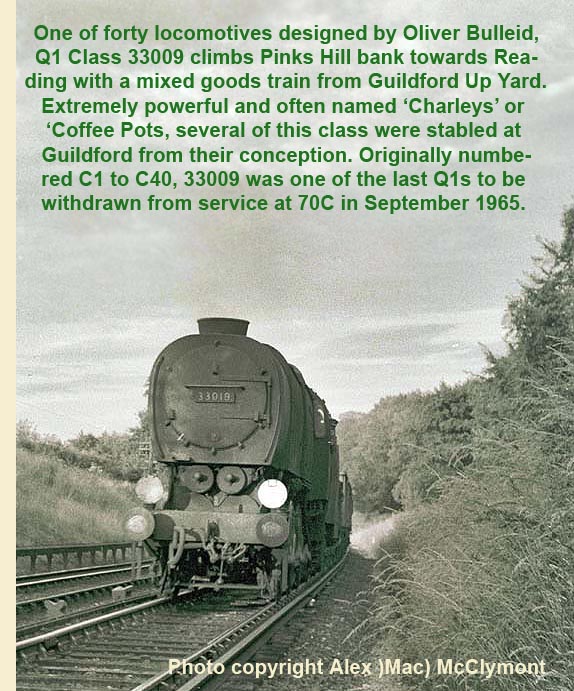 chimney. Signalled through number eight platform via a short curve, the men at Guildford loco were agog at the sight and sound of the mogul taking the bend with all wheel flanges squealing as she led her charge of box wagons through the station. Not to be left out of this drama, the guard van's coal fired stove was shaking in response to the rough ride emitting a stream of sparks from the chimney as though in response to the locomotive's 'rockets'. The very sound of the exhaust coupled with the noise of the short wheel based wagons clattering over the points as the train gathered speed, the partly open fire hole door allowing the glare of the fire to reflect from the exhaust steam was a memorable sight.
chimney. Signalled through number eight platform via a short curve, the men at Guildford loco were agog at the sight and sound of the mogul taking the bend with all wheel flanges squealing as she led her charge of box wagons through the station. Not to be left out of this drama, the guard van's coal fired stove was shaking in response to the rough ride emitting a stream of sparks from the chimney as though in response to the locomotive's 'rockets'. The very sound of the exhaust coupled with the noise of the short wheel based wagons clattering over the points as the train gathered speed, the partly open fire hole door allowing the glare of the fire to reflect from the exhaust steam was a memorable sight.
Onwards they went, still gathering speed as they passed 'Blanchard's Block' and swept under 'Yorkies' bridge then around the sharp left hand bend before starting the climb for the summit of Pinks Hill. Although our hero had a full head of steam, the combination of a heavy load, a stiff 1-in-80 gradient and the sharp left hand bend was beginning to take its toll, and we could hear the speed reducing as she approached Dennis's factory.
Our willing horse was starting to struggle, the exhaust beats gradually becoming slower and slower. Down to a walking pace now, the regulator in second valve and the lever in 75% cut off, she strained every muscle to keep going. The audience at the loco shed listened to the distant muffled beat from the chimney as it passed under the bypass bridge, then shortly after there was an audible sigh of despair as the train came to a standstill without a single hint of wheel spin. The safety valves could be heard to lift almost immediately.
What a disappointment for all concerned...there was nothing for it but to get permission to set back into Guildford Up Yard and reduce the load by a considerable amount. It was no good; something had to be done and so after the second attempt failed, it was decided to take some of the discarded wagons over to the weigh table in the Down Yard to be checked for loading.
As stated earlier, the cement was loaded into the wagons in one hundred-weight bags, and therefore you can imagine our shocked surprise to discover the cement company had actually loaded far more bags into the wagons than were permitted. The upshot was that each wagon had been overloaded by several tons, making the train heavier by as much as two hundred tons! At least Guildford crews had been vindicated, until then their suspicions of overloading had been ignored.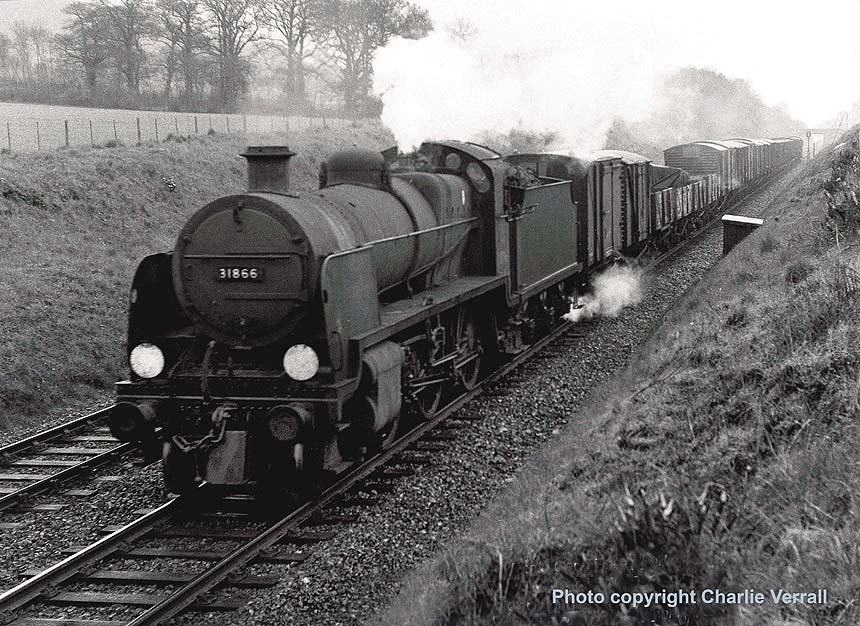
(Above-Below) N Class 31866 - with 'feather' flying - descends towards Gomshall after turning the top of Dorking Bank with a full load on the 9.34am freight from Hoo Junction to Reading on 5th May 1962. (Below) N Class 31843 runs down Pinks Hill bank with an evening freight from Reading to Guildford Yard in June 1962.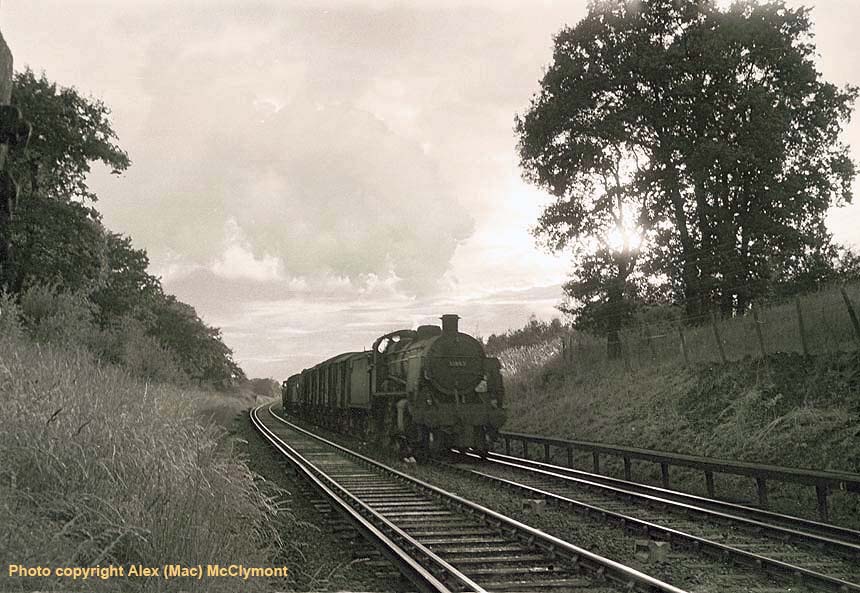
Confessions of a Weaver Plant Operator
by Pat Kinsella
Due to the nature of their work, steam locomotives were susceptible to an accumulation of coal, ash dust and other foreign matter adhering to the wheels and motions, all of which was created by sprayed oil from  various component parts and oiling points of the engine. Cleaning below the locomotive and tender framings was a difficult and dirty job, especially after the loco had been in service for several weeks. To assist cleaners in this task, a machine called 'The Weaver' was employed. It consisted of a small petrol engine, water and paraffin reservoirs, a large heating coil, a burner, blower, pump, chimney and double reinforced hosepipes each about twenty feet in length. At the business end was a large lance about five feet long in length with timber handles of about thirty inches in length. Large quantities of caustic soda were tipped into the water reservoir that was then heated via the coil and burners before being pumped to the hosepipes where it emitted as caustic steam under pressure. These components were mounted on a three-wheeled chassis with a steering arm, which was housed in a small, 16-gauge sheet metal,
various component parts and oiling points of the engine. Cleaning below the locomotive and tender framings was a difficult and dirty job, especially after the loco had been in service for several weeks. To assist cleaners in this task, a machine called 'The Weaver' was employed. It consisted of a small petrol engine, water and paraffin reservoirs, a large heating coil, a burner, blower, pump, chimney and double reinforced hosepipes each about twenty feet in length. At the business end was a large lance about five feet long in length with timber handles of about thirty inches in length. Large quantities of caustic soda were tipped into the water reservoir that was then heated via the coil and burners before being pumped to the hosepipes where it emitted as caustic steam under pressure. These components were mounted on a three-wheeled chassis with a steering arm, which was housed in a small, 16-gauge sheet metal, 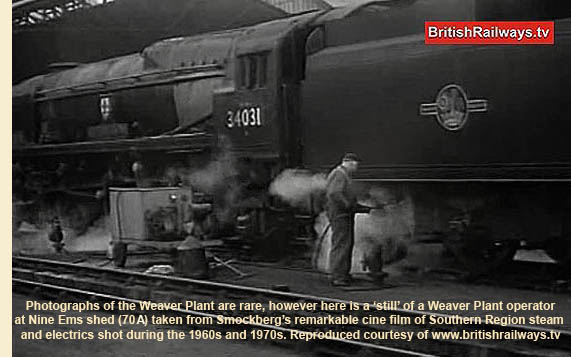 free-standing shed just big enough for it to squeeze into via a short ramp. However, because of the hazardous nature of the job the minimum age for operating the lances was fifteen by which time it was considered that boys of such 'maturity' had reached the 'age of reason'.
free-standing shed just big enough for it to squeeze into via a short ramp. However, because of the hazardous nature of the job the minimum age for operating the lances was fifteen by which time it was considered that boys of such 'maturity' had reached the 'age of reason'.
Wrong!
Imagine the scene...St. Josephs Church, Chertsey Street, Guildford - a scruffy youngster sits gingerly in the confessional box fidgeting nervously with his collar...
'I've come to confess, Father.'
'Tell me about it, my son.'
'It's a bit embarrassing, Father.'
'It can't be that bad, I'm sure. Have you had carnal thoughts, perhaps?'
'No Father...that was last week!'
'Yes I forgot. Perhaps you stole something then, cursed or used bad language?'
'No Father.' 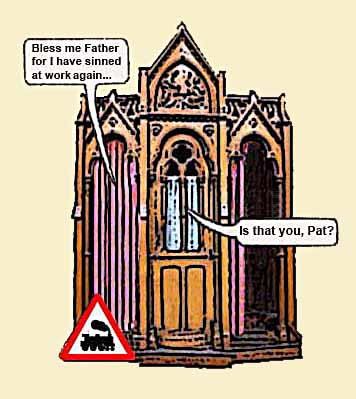 'Then tell me what you have done, my son. Your confession is safe with me.'
'Then tell me what you have done, my son. Your confession is safe with me.'
'Well Father, starting on Monday I was detailed to assist with operating the weaver cleaning machine at work all this week with another cleaner boy under the supervision of an adult who we played up something rotten.'
'What exactly did you do?'
'Well, on Monday our machine was parked between one and two roads and we had to steam clean the motions on Charlie 9 in number three road. In order to reach it we pushed our lances between the wheels of 31639 which stood beside us in number two road. While we were blasting the wheels of Charley 9, our supervisor was rolling a cigarette with his back to us and another cleaner said he was going to play a trick on him, to which I agreed...'
'Do go on, my son.'
'Well, since the U Class was in steam it meant that she could be moved very quietly by using just the steam brake. So this cleaner secretly climbed up onto the footplate and released the hand brake, and with the engine in reverse, moved the engine back a couple of feet, stopping her with the steam brake.'
'Perhaps he shouldn't have done that, my son, but I don't see how much damage could be done.'
'Oh, it did Father! When the wheels turned, they ran over our hosepipes and chopped two lengths precisely 4ft 8½ inches inches out of the middle!'  'And you were party to this?'
'And you were party to this?'
'Yes, Father, a terrible sin!'
'Say three Hail Mary's and one Our Father.'
'I haven't finished yet, Father...on Tuesday, after the hoses had been replaced, we hauled the Weaver over to the old shed to work on a couple of locos, one of which was Schools Class 30903 'Charterhouse'. The day went well without any silly interruptions - that is until we started to haul the Weaver back to its shed for the night. My colleague was on the steering handle and as we approached the turntable, my pal indicated for me to push harder, which I did. Our supervisor was pushing on my right-hand side and didn't realise how close we were getting to the turntable pit. All of a sudden, the left hand wheel slipped into the pit and the Weaver lurched to one side at an alarming thirty degrees over the edge! Our supervisor jumped into the pit and tried to push the one ton machine back out. But while he was trying to lever the machine up, my colleague and I were trying to push it back in on top of him. Eventually some fitters came to his rescue and helped him to get the apparatus back up...a terrible sin, Father.'
'Say another three Hail Mary's and one Our Father.'
'I haven't finished yet, Father!'
'There is more?'
'Yes father...you see on Wednesday, when we got the Weaver out for another day's cleaning, our supervisor went to the stores to collect some caustic soda and while he was away, another colleague, with my blessing, removed the spark-plug from the engine and dropped a small nut into  the cylinder, then replaced the plug. On his return from the stores, our supervisor added the caustic soda to the water, and then gave a great pull on the starting cord. Unfortunately, and rather unusually, the engine fired first time, followed by a muffled sound then a clanging noise before the engine stopped stone dead. Our intrepid supervisor scratched his head then wiped his nose before looking for, and finding, the problem. After doing a lap of honour from two road round to the sand hole and back, he calmed down enough to proceed with replacing the engine...we did a terrible sin, Father.'
the cylinder, then replaced the plug. On his return from the stores, our supervisor added the caustic soda to the water, and then gave a great pull on the starting cord. Unfortunately, and rather unusually, the engine fired first time, followed by a muffled sound then a clanging noise before the engine stopped stone dead. Our intrepid supervisor scratched his head then wiped his nose before looking for, and finding, the problem. After doing a lap of honour from two road round to the sand hole and back, he calmed down enough to proceed with replacing the engine...we did a terrible sin, Father.'
'Say three Hail Mary's and one Our Father.'
'I haven't finished yet, Father!'
'There's more, my son?'
'Yes Father...on Thursday, after steam cleaning all day, there was the ritual putting away the Weaver for the night. Some of my cleaner colleagues used to play up during this process, so it was deemed necessary for Mr Stovold, the Depot Master, to oversee the revelries. The spectacle was usually enjoyed by some dozen or more cleaners who congregated in the cabs and on the tenders of locomotives to get a grandstand view.'
'Go on, my son.'
'Well, when the metal doors of the Weaver shed were opened, some little exertion was required to push our charge up the short ramp. This was applied by my colleague and the 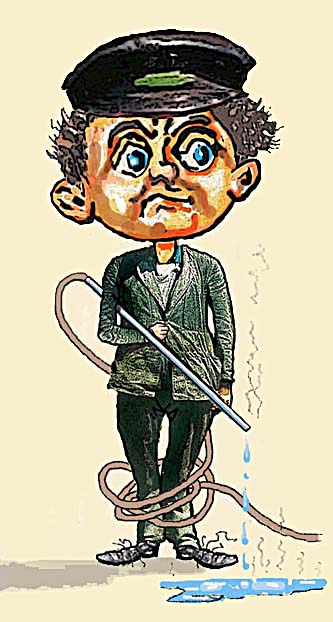 supervisor whilst I was on the steering arm. After several attempts, we stalled on the ramp, so we drew back a couple of yards to have a run at it. However my colleague's enthusiasm got the better of him and, head down - clearly showing off in front of all his cheering peers - he continued to push so hard that we knocked the building clean off its base! Under Mr Stovold's direction, the shed had to be rocked back into place before another attempt could be made. By this time our audience was getting more excited awaiting a grand finale! I heard Mr Stovold calling out - 'A little less energy now boys....a shorter run this time!' And for just a second, it looked as if the Weaver would go in. The cheering immediately diminished to a murmur of disappointment until I quickly jerked the steering arm just a touch to the left, and with a crash, the machine hit a corner post and shoved the shed sideways at an angle of twenty degrees to the base. As I basked in grateful applause from the audience Mr Stovold threw me a pained look and ordered us to get the shed back in place. Eventually the Weaver was locked up for the night...a terrible sin Father.'
supervisor whilst I was on the steering arm. After several attempts, we stalled on the ramp, so we drew back a couple of yards to have a run at it. However my colleague's enthusiasm got the better of him and, head down - clearly showing off in front of all his cheering peers - he continued to push so hard that we knocked the building clean off its base! Under Mr Stovold's direction, the shed had to be rocked back into place before another attempt could be made. By this time our audience was getting more excited awaiting a grand finale! I heard Mr Stovold calling out - 'A little less energy now boys....a shorter run this time!' And for just a second, it looked as if the Weaver would go in. The cheering immediately diminished to a murmur of disappointment until I quickly jerked the steering arm just a touch to the left, and with a crash, the machine hit a corner post and shoved the shed sideways at an angle of twenty degrees to the base. As I basked in grateful applause from the audience Mr Stovold threw me a pained look and ordered us to get the shed back in place. Eventually the Weaver was locked up for the night...a terrible sin Father.'
'Say three Hail Mary's and one Our Father.'
'I haven't finished yet, Father. There is still one day left...'
'Good grief, then you must go on...'
'Well, on Friday, we pulled and pushed the Weaver over to the Old Shed and parked it between two locos. On our right was a Black Motor, a 700 Class. Unfortunately we parked it very close to the tender, so the chimney on the Weaver was almost level with the top of the tender, and unbeknown to me, whilst I softly hummed the tune of 'April Love' by Pat Boone, I was blasting the grease from the engine wheels, and turned just in time to see a couple of young reprobate cleaners dropping paraffin-soaked cleaning cloths down the Weaver chimney. A bit of a laugh, I thought. The cloths were followed by three or four Satsuma-sized lumps of good Welsh household coal, and with the Weaver thumping merrily away and our supervisor rolling his cigarette, everything appeared just fine. Unfortunately, deep inside the machine the forced draught had assisted the immediate combustion of the foreign matter. This should be a bit of fun, I thought, and so more oily cloths were dropped into the funnel, followed by another selection of hand-picked coal. I suppose one has to give credit to the perpetrators - 'little and often' they had been taught up the firing school, and 'little and often' it was...'
'You seem to think that this is something of a joking matter, my son?'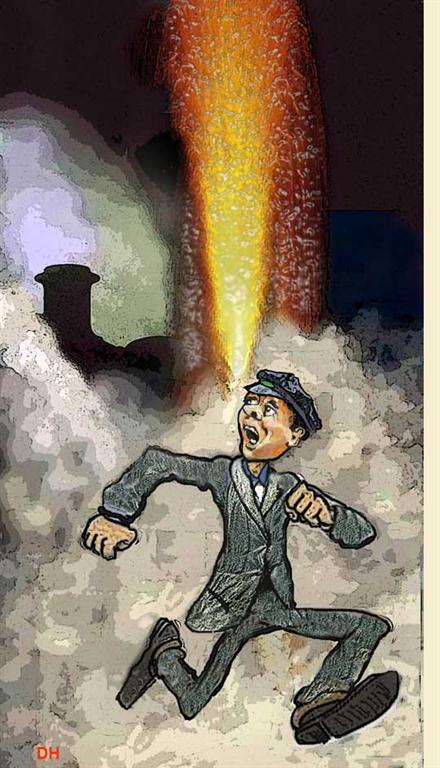 'Sorry Father...you're quite right, of course it isn't. You see, when complete combustion was observed, (it only took minutes) more fuel was added. Our supervisor, comforted by the rhythm of his machine, had drifted away to the lavatory. By now, flames issued from the funnel to a height of several feet and my colleague and I enjoyed the spectacle immensely. Those responsible were standing by the table hole admiring their handiwork. Returning from the lavatory, our supervisor was confronted by his two assistants standing with their lances, spewing caustic soda-laced steam in all directions. He saw his beloved machine vibrating alarmingly, its chimney glowing cherry-red while throwing flames into the air; it put me in mind of a mini-volcano...'
'Sorry Father...you're quite right, of course it isn't. You see, when complete combustion was observed, (it only took minutes) more fuel was added. Our supervisor, comforted by the rhythm of his machine, had drifted away to the lavatory. By now, flames issued from the funnel to a height of several feet and my colleague and I enjoyed the spectacle immensely. Those responsible were standing by the table hole admiring their handiwork. Returning from the lavatory, our supervisor was confronted by his two assistants standing with their lances, spewing caustic soda-laced steam in all directions. He saw his beloved machine vibrating alarmingly, its chimney glowing cherry-red while throwing flames into the air; it put me in mind of a mini-volcano...'
'I see...and what did the supervisor do?'
'He did no more than run to the Foreman's office and reported it to Mr Price who then arrived on the scene and instructed our supervisor to shut the Weaver down. The supervisor steadfastly refused; the paraffin reservoir supplying fuel to the burners attached to the machine was about to blow up at any second!'
'Oh my goodness!'
'Yes Father...it was extremely dangerous, and so a fitter was called; he approached cautiously and short-circuited the sparking plug and calmed everything down...a terrible sin, Father.'
'Is that the end of your confession, my son?'  'Yes, Father.'
'Yes, Father.'
'Well, thank the Lord for that! I make that fifteen Hail Mary's and five Our Father's altogether...and don't forget to put something in the box on your way out.'
'Thank you, Father. See you next week.'
Postscript: At the end of steam on the 9th July 1967, our Weaver supervisor transferred to platform duties at Guildford for a short while, but he didn't like dealing with the public and ended his career happily engaged in carriage-cleaning in the Up Yard electric siding.
(Right) This is our Shed Master, Mr G.A.V. Stovold. I have often wondered why he was so tolerant of us cleaner boys over the years. After all, he had ample opportunity to dismiss several, if not most of us during the years 1957-1958. We knew that 'theft' was not tolerated and an employee was subject to instant dismissal for so indulging, but other than that, we were given a lot of rope. In later years, I learnt that his only son was killed on the 27th June 1944, whilst serving in the Royal Tank Regiment - aged just 20. Perhaps Mr Stovold looked on us as siblings? Whatever the reason, after his retirement, I can remember seeing him striding into Guildford from his home in Onslow Village, head held high and with a military bearing, trilby hat in place, his long coat flapping in the breeze. Bless him...he was a gentleman of the old school, who started me in a life-long career in the most interesting and enjoyable employment that I could have wished for.
Dave (Sam) Salmon's Photo Gallery
I recently reacquainted myself with Dave (Sam) Salmon, who was a fireman at Guildford Loco (70C) before I joined the railway. Sam has been kind enough to give me permission to publish some of his excellent colour photographs taken during steam days. Sam joined the railway as an engine cleaner in 19**, quite often  using the Weaver Plant under Jack (Cock) Robin's supervision (see Pat's anecdote above). Once Sam reached 16 years of age, he attended the Firing School at Guildford and Feltham MPDs with other cleaners of his age; his Instructor being Mr George Bolland. After passing out for firing duties, Dave's first firing turn was on the shunting loco at Woking Yard. At a later date, a link will be provided to Dave (Sam) Salmon's 'Rail Cameraman' page of steam and diesels around the BR Regions (still under construction). Meanwhile here is a selection of his photos taken at Guildford Loco 70C...
using the Weaver Plant under Jack (Cock) Robin's supervision (see Pat's anecdote above). Once Sam reached 16 years of age, he attended the Firing School at Guildford and Feltham MPDs with other cleaners of his age; his Instructor being Mr George Bolland. After passing out for firing duties, Dave's first firing turn was on the shunting loco at Woking Yard. At a later date, a link will be provided to Dave (Sam) Salmon's 'Rail Cameraman' page of steam and diesels around the BR Regions (still under construction). Meanwhile here is a selection of his photos taken at Guildford Loco 70C...
(Below) It seems appropriate to start Dave (Sam) Salmon's photo gallery with his wintry shot of USA Class 30072 moving towards the Back Road at Guildford MPD on the morning of 21st January 1966. This interesting locomotive was one of fourteen locos designed and built by the United States Army Transportation Corps in 1942 and purchased by the Southern Railway in 1946 for use at Southampton Docks. Before entering traffic the class was fitted with modified cab, bunker and other detail alterations such as steam heating, vacuum ejectors, sliding cab windows, additional lamp irons and new cylinder drain cocks plus other modifications became necessary, including three rectangular cab-front lookout windows, and the coal bunkers were extended to increase capacity from 26cwt to 30cwt. On closure of Guildford shed on Sunday 9th July 1967, No 30072 had the dubious distinction of being the final loco to be coaled there (see last photo in this gallery). The loco was among four members of the class that found their way into preservation, the others being: 30064, 30065, and 30070. In the right background can be see alterations taking place to platform 6 as 2BIL EMU awaits departure with an Ascot train on platform 8.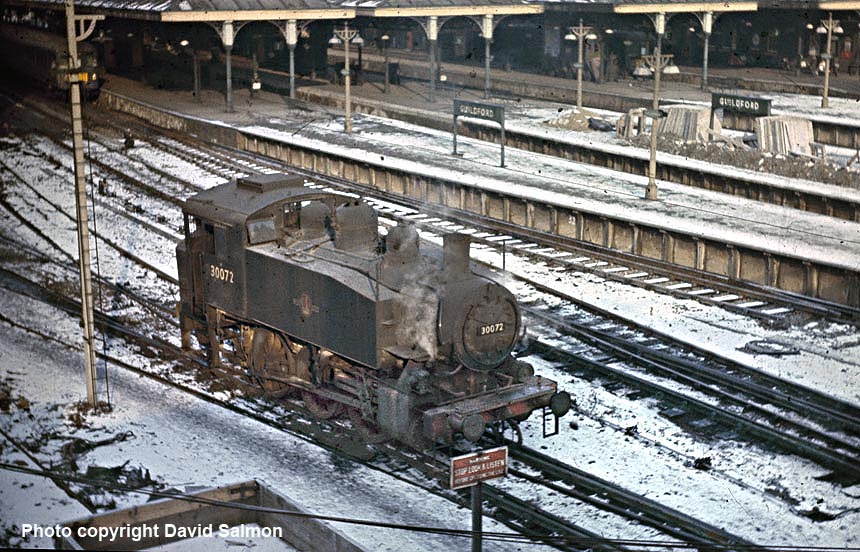
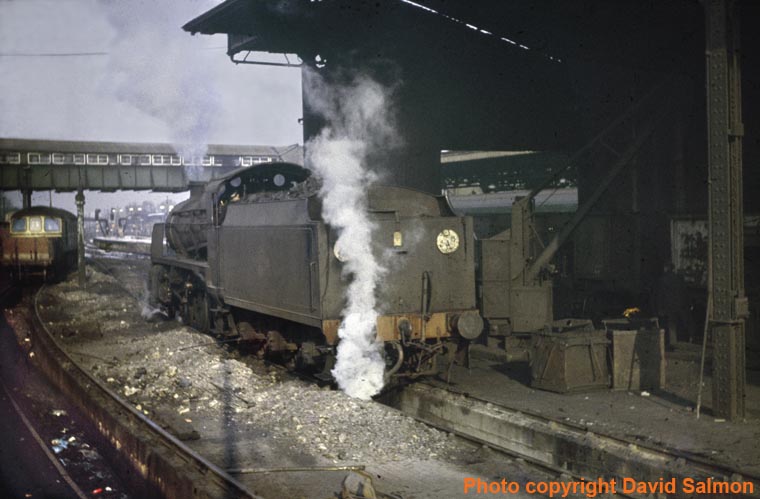
Above-Below) Maunsell Design N Class 31411 is being positioned to be coaled at Guildford MPD on the 22nd January 1966. The valve that allows steam to the steam heating connections seems to be at fault hence the steam being emitted. A Type 3 1550hp Crompton is berthed in the Back Road next to the ash wagon that's waiting to be loaded by Frank Mitchell the resident Shedman. (Below) Rebuilt Battle of Britain Class 34056 'Croydon' stands on the Coal Road waiting her next turn of duty which will probably be the 14.02 Stone Train Empties from Woking to Salisbury. Before this could happen though, the locomotive would have to be turned via the triangle at Addlestone Junction and Weybridge as the turntable at Guildford MPD wasn't big enough to accommodate this class of locomotive.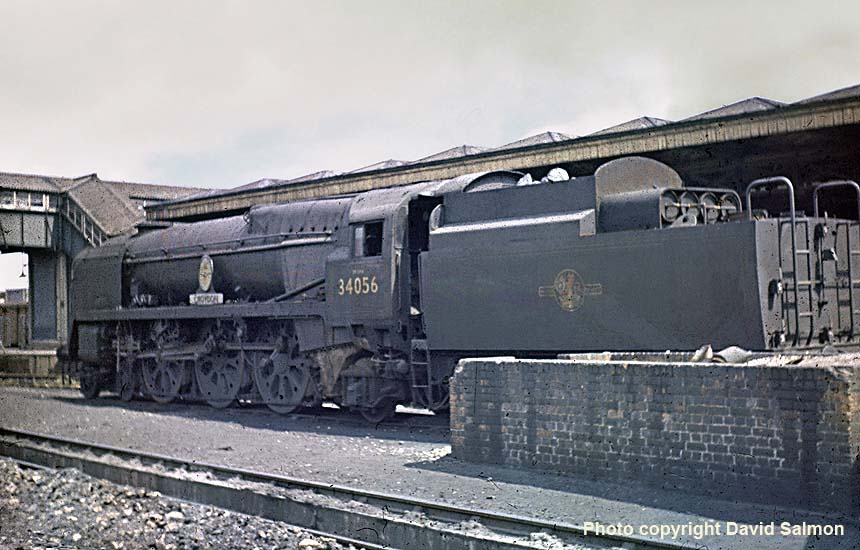

(Above-Below) BR Standard Class 5MT 73093 waits her turn to be coaled at Guildford MPD on 21st May 1965. There is plenty of evidence of disposal duties in the area looking at the amount of ash and clinker in the foreground. Certainly plenty of work for Frank Mitchell to contend with! (Below) BR Standard Class 4MT 76031 simmers in the Back Road in July 1966. Other BR Standards are in evidence, 77014 and 73093. A train made up of 2BIL EMU stock is berthed in the Up Yard Carriage Road.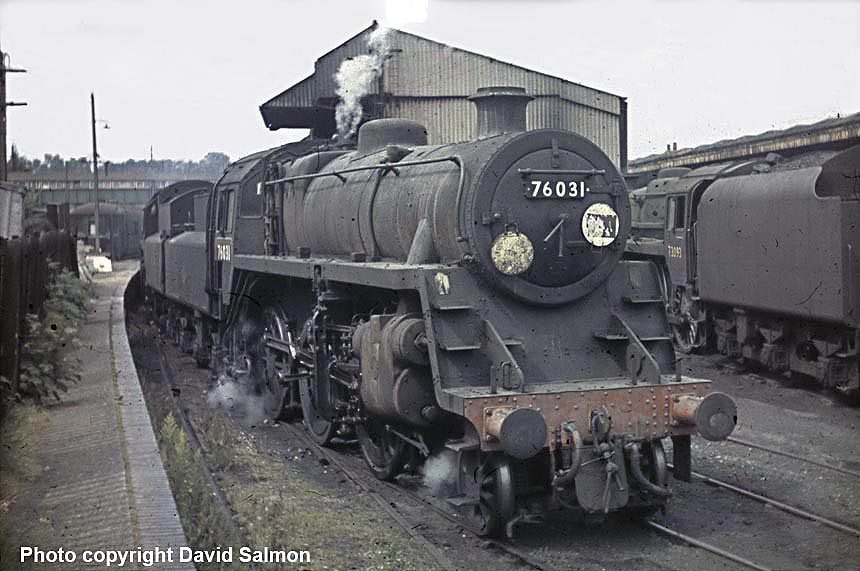
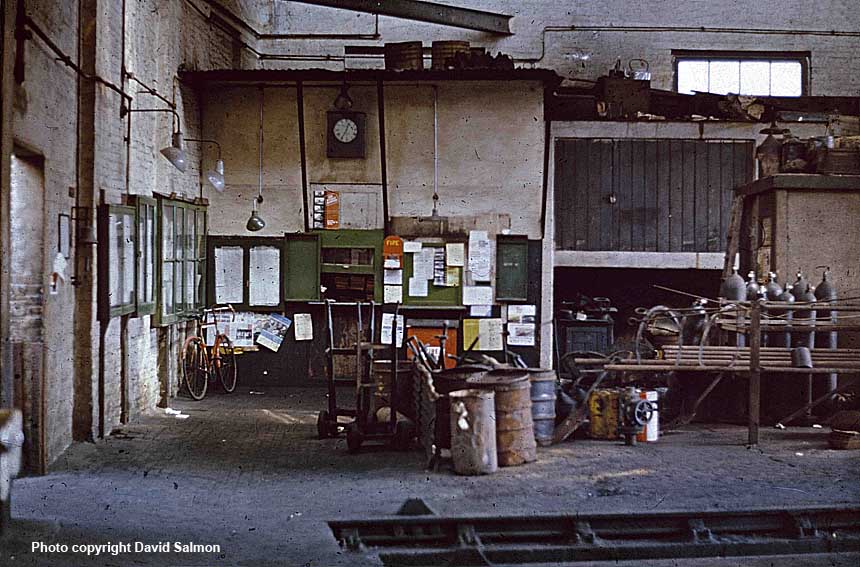
(Above) The Store's Clock says 12:35 and all the locomotives have departed from Guildford MPD on Sunday 9th July 1967. The Stores hatch remains open but nothing will be served through this hatch again. A racing bike is propped against The Factories Act Notice Cases but sadly this is the end of the road for what was once a bustling workplace. I'd certainly like a £1 for every time that I'd been served by the Storemen at this hatch - anything from Engine Oil, Paraffin and Locomotive tools to an exchange of cloths - a white one, a brown 'un! - 'Where's your dirty one?' the Storeman would ask!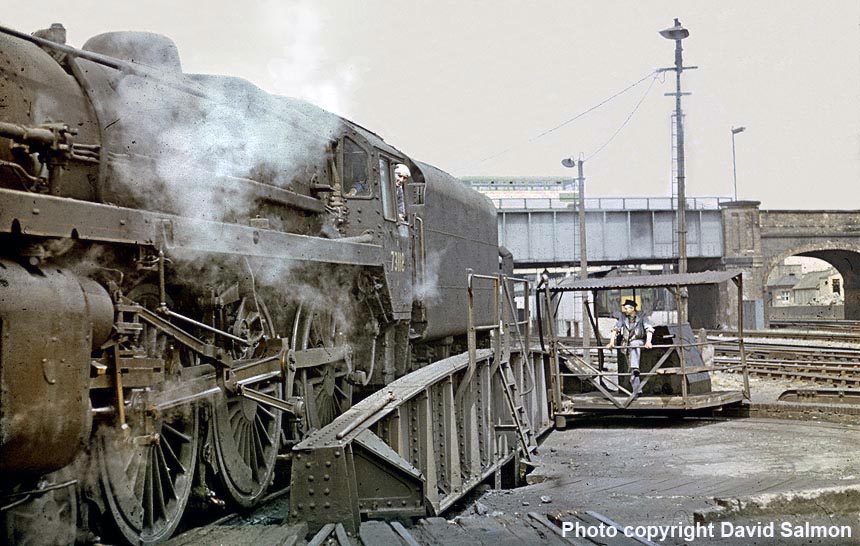
(Above-Below) Driver Peter (Jack) Ward moves BR Standard 5MT 73118 (once named King Leodegrance) onto the table from the Old Shed on 17th June 1967, whilst Shedman Claude Johns looks on to perform the turning task. In the background, a train made up of 4COR EMU (Nelson) Stock waits to leave from platform 3 for Waterloo. (Below) A truly evocative shot of USA Class 30072 shown being coaled at Guildford Coal stage for the very last time for her journey to Salisbury via Havant on the Sunday 9th July 1967. She was the last steam locomotive to leave the depot that day and was crewed by Fratton men. Previous locomotives that left that day were Rebuilt West Country Class 34018 'Axminster' and two BR Standard Class 5MTs 73118 and 73155.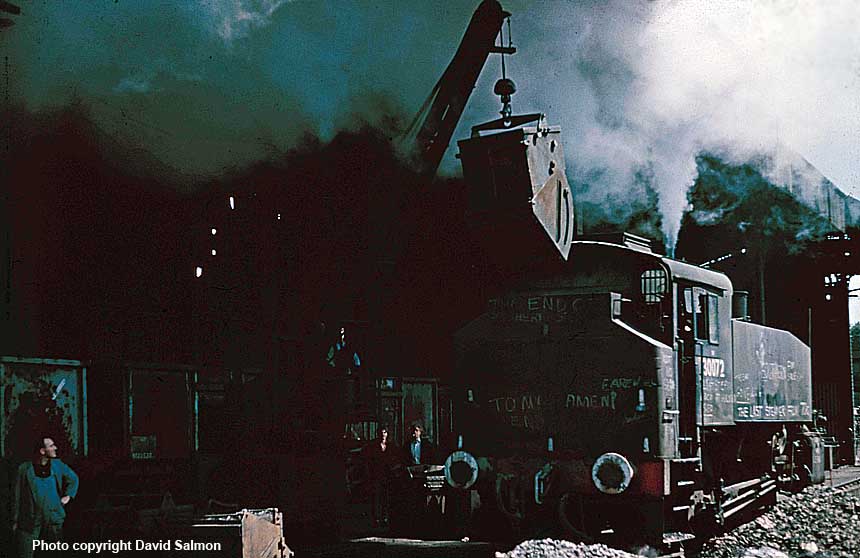
Special Workings
by Pat Kinsella Part of the enjoyment of talking to older drivers is listening to their tales and experiences. I recall one driver regaling me with his reminiscences of steam days at Guilford shed, who said - 'You know Pat, if there's one thing for sure, these things are never going to happen again...'
Part of the enjoyment of talking to older drivers is listening to their tales and experiences. I recall one driver regaling me with his reminiscences of steam days at Guilford shed, who said - 'You know Pat, if there's one thing for sure, these things are never going to happen again...'
He was absolutely right. I remember chatting with Brian Davey, who was Bill Hedgecock's regular fireman for a considerable period of time during the early 1950s. Brian was telling me about the occasion when the turntable at Reading was out of action; it meant that tender engines could not be turned. Consequently, this type of loco was deemed unsuitable to work passenger trains between Reading and Redhill due to the amount of mileage running tender first, and until repairs on the table were implemented M7 class 0-4-4 tank locomotives (pictured left) were diagrammed instead.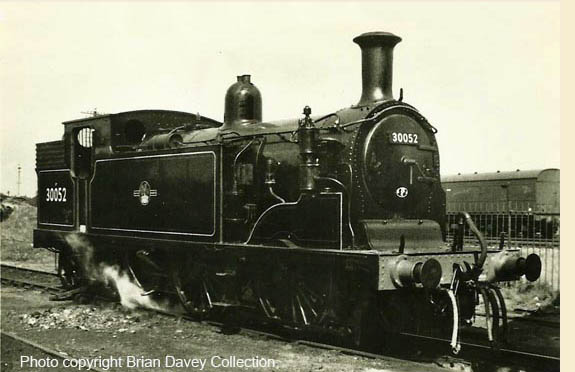 Brian remembered the day they were returning from Redhill with an M7 loco which wasn't steaming well at all due to a number of stays leaking down the front of the firebox - 'The escaping steam and water was doing its level best to put the fire out!' he mused.
Brian remembered the day they were returning from Redhill with an M7 loco which wasn't steaming well at all due to a number of stays leaking down the front of the firebox - 'The escaping steam and water was doing its level best to put the fire out!' he mused.
Being as there was a long stretch downhill for the first part of the trip they were doing quite well, but when they came to depart Deepdene the engine began to struggle. Up the gradient to Dorking things were getting serious, yet Bill (featured right) decided to press on and see if the loco could be coaxed up the long drag of Dorking bank.
Alas, they came to a stand short of steam about half way up, and as Brian tried to get some steam back Bill suddenly called out to him - 'Take a look out on the down side!'
Brian looked, and there passing close to the railway fence was the local hunt in full cry, a riot of colour and  noise sprinting across the field in the same direction as their train. As the cries of 'tally-ho' disappeared into the distance, it took a while longer before enough steam was raised to enable them to reach Guildford where the locomotive was taken to the depot for examination.
noise sprinting across the field in the same direction as their train. As the cries of 'tally-ho' disappeared into the distance, it took a while longer before enough steam was raised to enable them to reach Guildford where the locomotive was taken to the depot for examination.
The following day when our intrepid crew booked on for duty they were told to report to the shed master's office. Expecting the need to explain why time was lost the previous day, they entered Mr Stovold's office only to be told by him that the Master of the Hunt had called in and presented Mr Stovold with a one pound note, adding that he wanted it to be shared between the engine crew of the train who had so thoughtfully stopped up Dorking bank the previous day to protect his hounds from being run over!
For the benefit of younger readers, a half of £1 is ten shillings (50p), which may not sound a lot in today's money, but it was a considerable tip when you consider that a fireman's pay at that time was only about seven pounds a week. Indeed if you equate their tip to buying a round of beer, a pound would have bought you in the region of 15 pints of ale at that time! Convert that to today's prices and it would cost you at least £50... Crikey! I'll drink to that!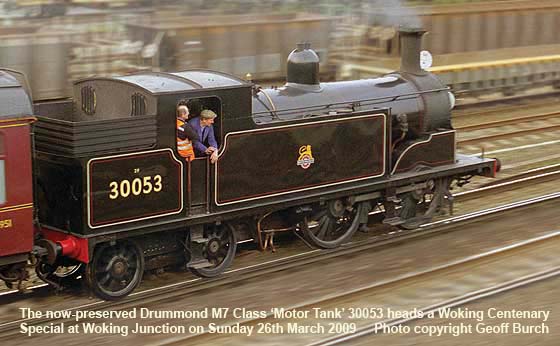
Alex (Mac) McClymont's Southern Region Gallery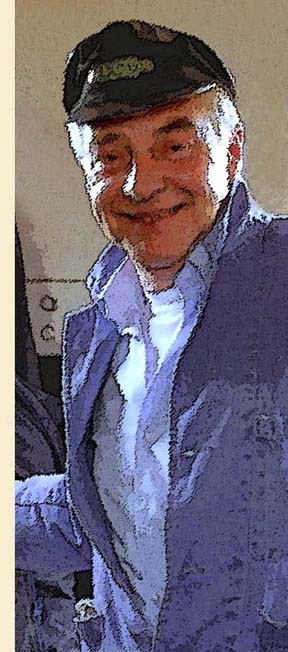 I have been fortunate in obtaining a large number of photographs taken by SR railwayman Alex (Mac) McClymont for inclusion on this page. I first met Mac when I was a young 16 year-old fireman and he made a big impression on me, as did a lot of other senior firemen at that time. Once Mac passed for driving duties, it was a pleasure to be booked as his fireman. Mac is very knowledgeable about railways - and, surprisingly (for a SR engineman) his favourite loco class is the Gresley A4s. I didn't know until recently that Mac had taken some wonderful photographs at Kings Cross station and at Top Shed during the early 1960s. These can be found on a coveted 'Rail Cameraman' page (still under construction) featuring Mac's photos during the transition from steam to diesels around the BR Regions - a link will be provided here when the page is up and running. Meanwhile, here's a taste of Mac's photos taken on the Southern Region...
I have been fortunate in obtaining a large number of photographs taken by SR railwayman Alex (Mac) McClymont for inclusion on this page. I first met Mac when I was a young 16 year-old fireman and he made a big impression on me, as did a lot of other senior firemen at that time. Once Mac passed for driving duties, it was a pleasure to be booked as his fireman. Mac is very knowledgeable about railways - and, surprisingly (for a SR engineman) his favourite loco class is the Gresley A4s. I didn't know until recently that Mac had taken some wonderful photographs at Kings Cross station and at Top Shed during the early 1960s. These can be found on a coveted 'Rail Cameraman' page (still under construction) featuring Mac's photos during the transition from steam to diesels around the BR Regions - a link will be provided here when the page is up and running. Meanwhile, here's a taste of Mac's photos taken on the Southern Region...
(Below) Class LN 'Lord Nelson' 30862 'Lord Collingwood' prepares to take coal at Basingstoke MPD. When showing this photograph to ex-Guildford Fireman/Passed Fireman, Charlie Hampshire, he remembered being in the adjacent shed one winter's night with his Driver Charlie Boskett waiting for their locomotive to come into the depot. Charlie Boskett always carried a transistor radio with him (quite a novelty in those days) and they were both drifting off to sleep when all of a sudden, the door opened and someone threw a couple of detonators into the stove and ran off! Charlie managed to rouse his Driver from his slumber and, grabbing his prized radio just managed to exit the hut before a huge explosion nearly lifted the tin roof off!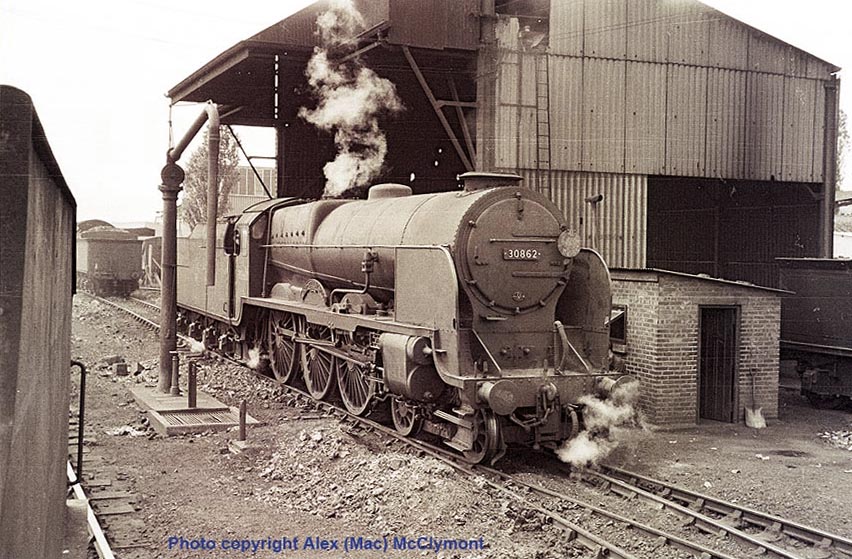
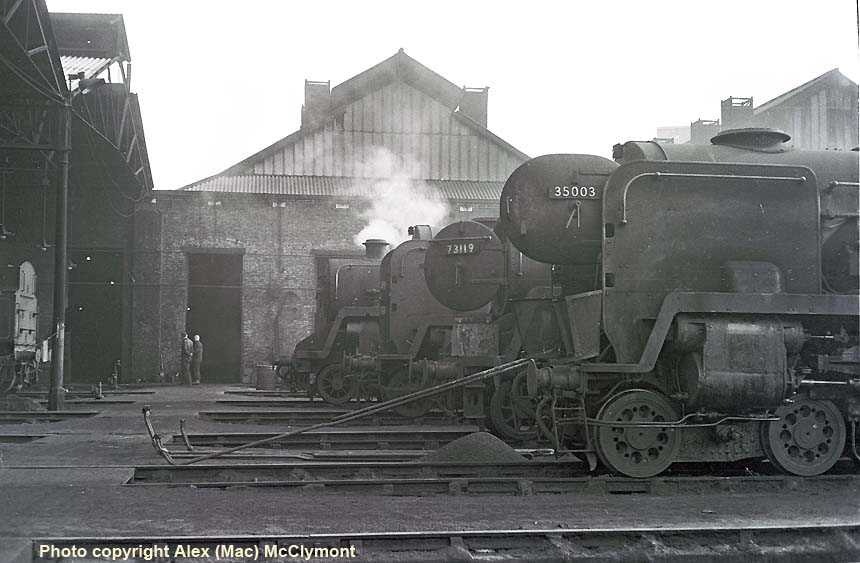
(Above-Below) A truly excellent photo line up of locomotives at Nine Elms MPD featuring Rebuilt Merchant Navy Class 35003 ' Royal Mail' (with smokebox door open and one of its Superheaters extracted for maintenance purposes). Superheater elements allowed (saturated) steam to be heated again which increased its thermal energy and therefore increased its efficiency. In the background is BR Standard Class 5MT 73119 with smokebox door open and other locomotives of the same class. (Below) Rebuilt West Country Class 34097 'Holsworthy' passes Woking on the down through line with an express passenger service for Exeter and a Diesel Mechanical Multiple Unit (DMMU) awaits departure from platform 5 with a stopping service for Sailsbury. The DMMU units were introduced on this service in 1966 during the Bournemouth electrification scheme and the Top Link Drivers at Guildford had to learn these units as several turns were booked to Guildford depot.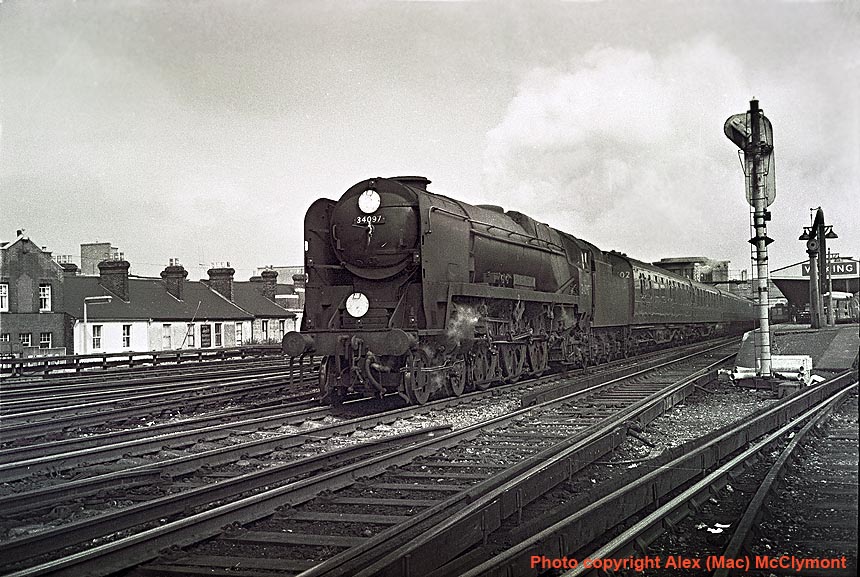
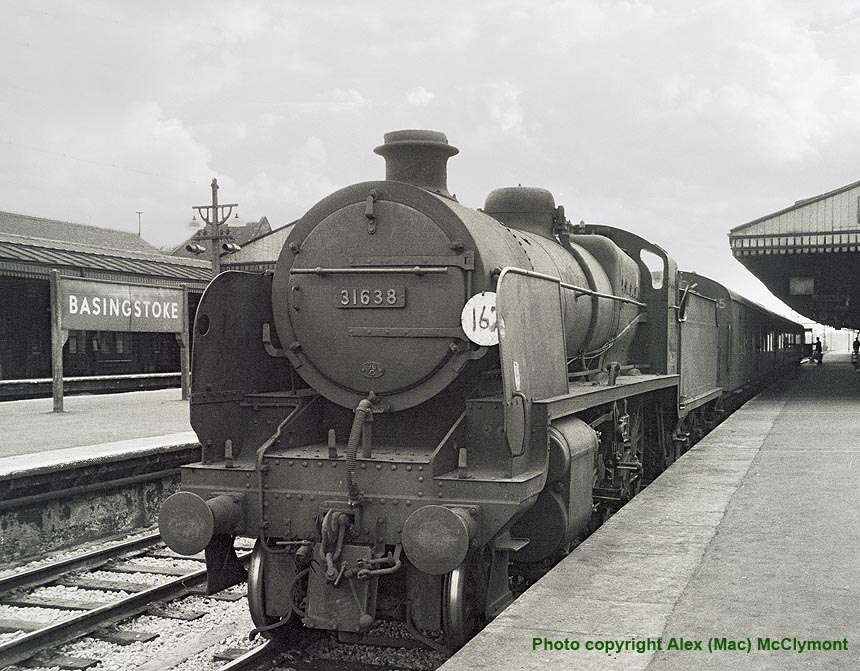
(Above) U Class 31638 is about to haul the 3.13pm stopping service from Basingstoke to Woking. She was a Guildford based locomotive (the 70C shedplate is clearly seen on the smokebox door). The locomotive is now preserved in fine working order and forms part of the Maunsell Locomotive Society fleet based on the Bluebell Line. 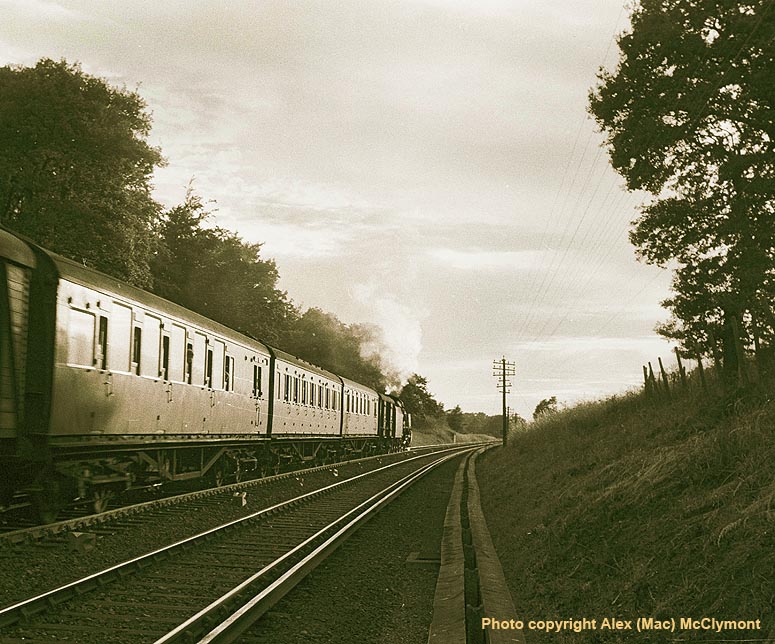
(Above-Below) U Class 31627 climbs Pinks Hill bank towards Reading with a passenger service from Redhill. The U and N Class locomotives were utilised most of the time on these hourly services in the early 1960s and sometimes a 'Schools' class would be used. During the mid-1960s, BR Standard Class locomotives became more commonplace and this eased the burden of disposal work as they had rocker grates and self-cleaning smokeboxes. The last steam hauled services over this route ran on 2nd January 1965, a bitterly cold day when 31627 worked the 09:45 from Reading to Redhill. (Below) 'Castle' Class 7002 'Devizes Castle' waits at Worcester station with a passenger train bound for Paddington. The Black 'D' in a Red disc on the cabside denoted the Power Class e.g. 25,001 lbf (111.2 kN) - 33,000lbf (146.8 kN). 7002 was built in 1946 with a double chimney and her first shed allocation was Swansea Landore and her last shed allocation was at Worcester and was withdrawn in March 1964. Hanging out over the fireman's side is a reinforced rubber hose commonly called the 'PET' pipe. Once the injector had been turned on, hot water could be emmited via this pipe in a jet form and this could be used to clean the footplate floor or douse the coal (especially useful when running tender first). Some Drivers hated their side of the footplate floor becoming wet as they thought it might exacerbate their rheumatism!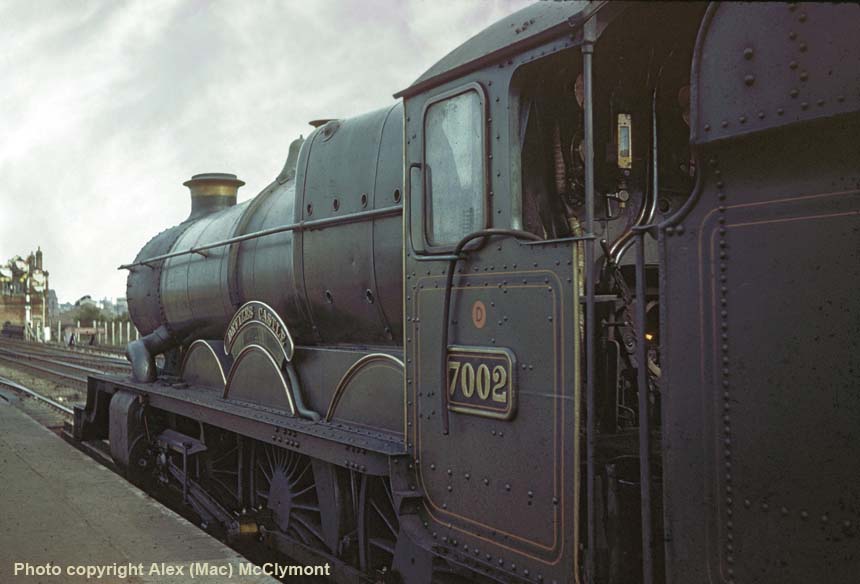
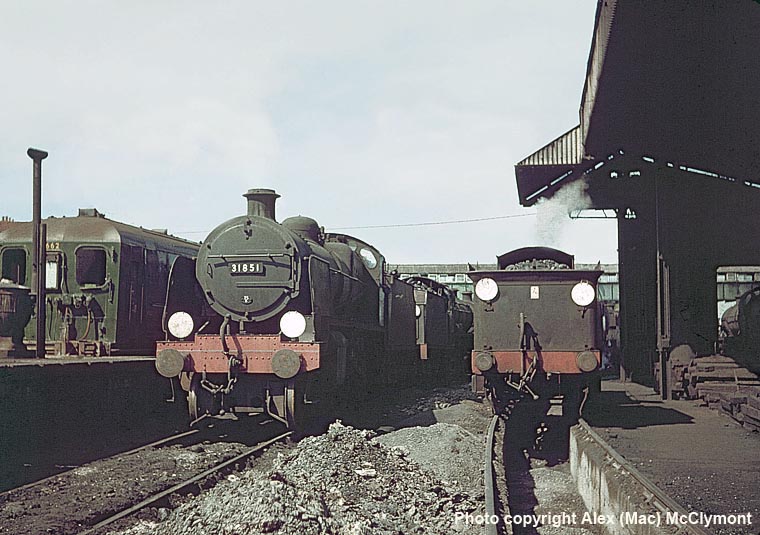
(Above) Redhill based locomotive (75B) N Class 31851 stands in the Back Road at Guildford awaiting her next turn of duty while a Class 700 (black motor) stands on the next road waiting to be coaled. Several other locomotives are in evidence and the pit looks as though it's had several locomotive ashpans raked out into it....a hazardous job where you always needed to know which way the wind was blowing before commencement! A 2HAL EMU (No 2662) is berthed waiting for its next trip (to Ascot probably) in the Up Yard Carriage Road.
(Below) BR Standard 4MT 80095 gets ready to depart from Waterloo with a set of empty coaching stock (ECS) bound for Walton station (via Twickenham, Addlestone Junction and Weybridge) where the ECS would be shunted back into Oatlands Sidings - ECS was quite often berthed there during the busy Summer period. The Shell Building is in the background and other EMU stock in the photograph are of the 1957 EPB (Electro-Pneumatic Brake) variety and the 1936 2BIL EMU (with Westinghouse Brake) which worked the Reading services.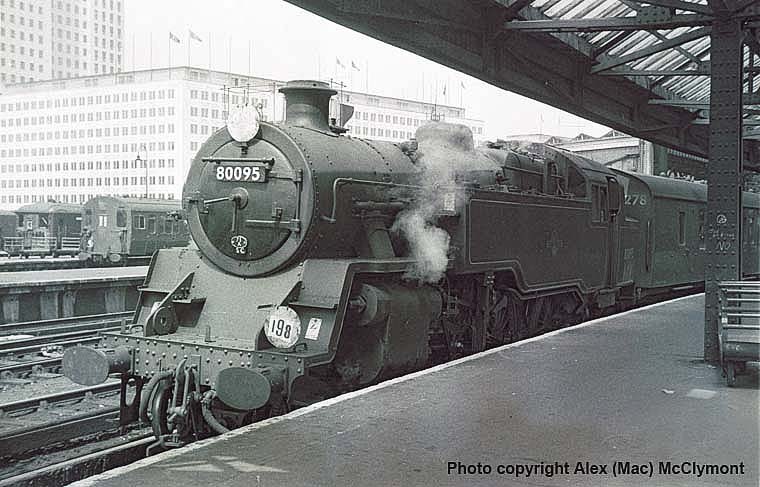
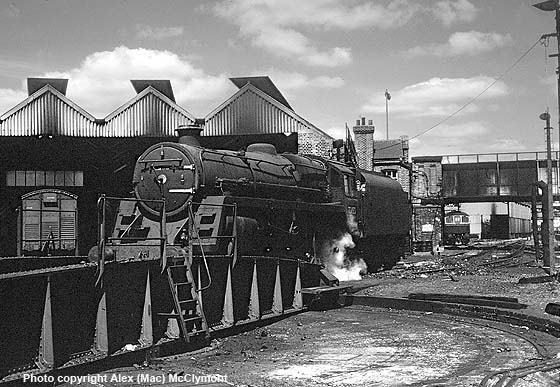
(Above) BR Standard Class 5MT 73155 has to edge onto the turntable so that she can take water for the last time before departing for Salisbury double headed with sister locomotive 73118 on the 9th July 1967. The crew on 73155 were Bill Brain and Geoff Burch and the crew on 73118 was Dave Elson and Pat Kinsella. A type 3 1550hp Crompton remains berthed just beyond Farnham Road Bridge and was booked to run light to Eastleigh Diesel Depot later that afternoon with Driver Peter Nixon and fireman Alan Johns.
EC GRIFFITHS RAILWAY PHOTOGRAPHS
Rae Woodford's Collection 
(Above-Below) With boiler at maximum 200lb pressure and feather flying, U Class 31793 heads towards Shalford and then the long climb towards Chilworth with an Inter-Regional passenger service. (Below) The Crossing keeper looks on as U Class 31798 passes over East Shalford Lane crossing with an Inter-Regional passenger service from Birkenhead heading for the South Coast.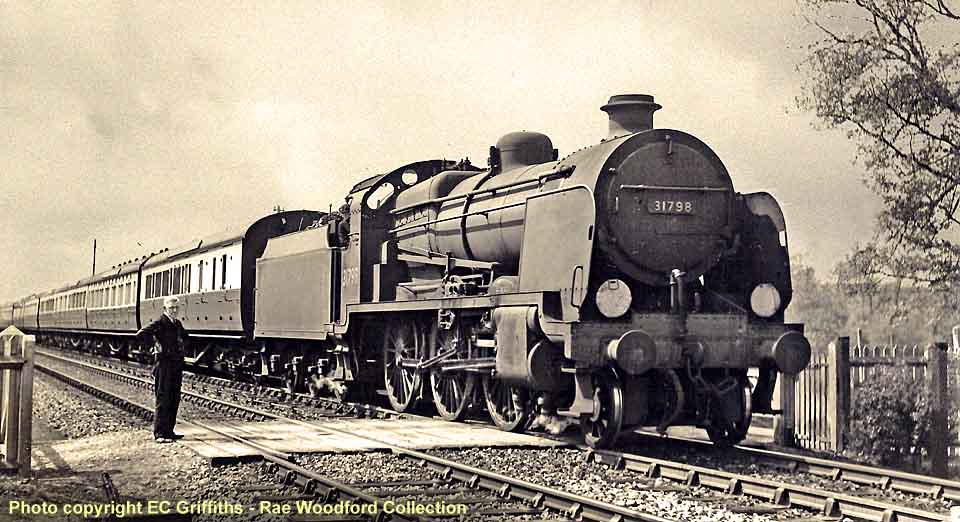
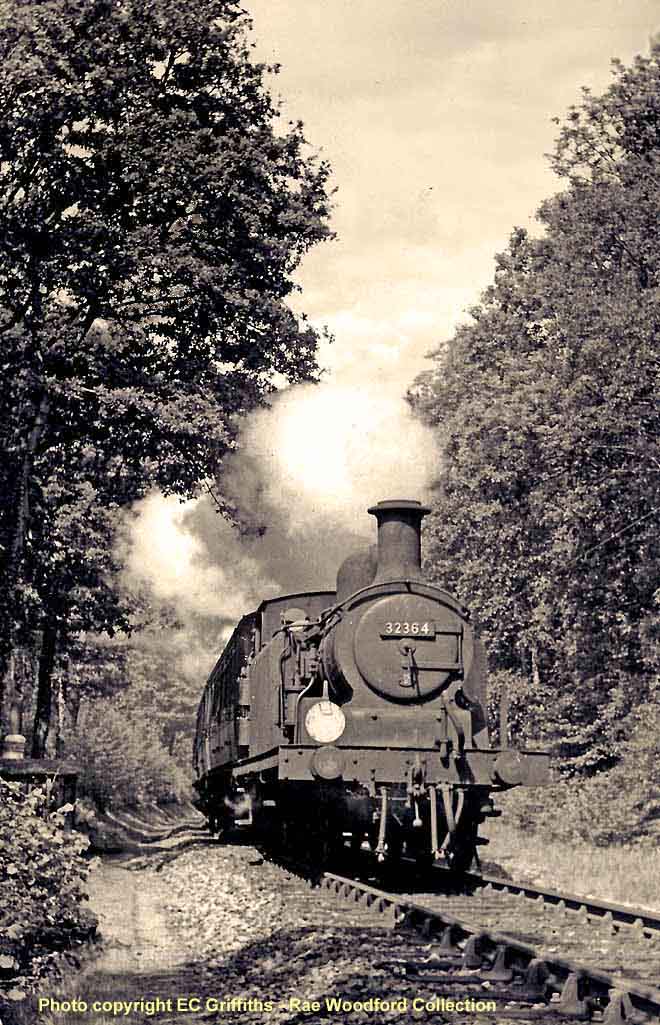
(Above-Below) D3 Class No 32364 with a Push-Pull set at an unknown location. The locomotive's last shed was Horsham (75D) from where it was withdrawn in 1962. (Below) M7 Class No 60 crosses over an ungated road track near Kingsley Halt with a local passenger service on the Bentley - Bordon Branch.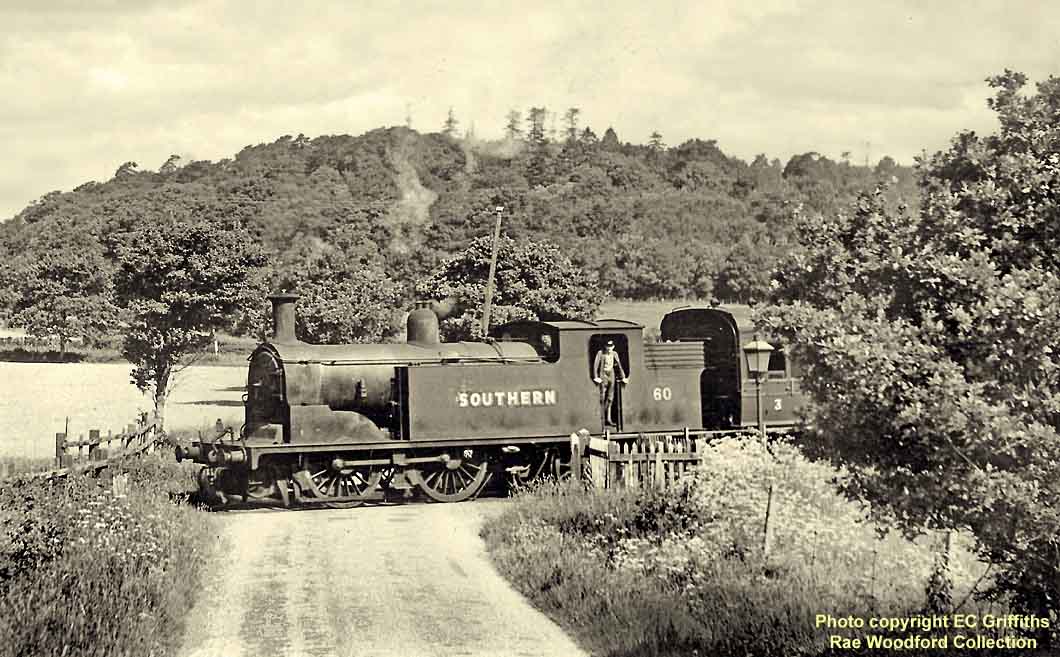
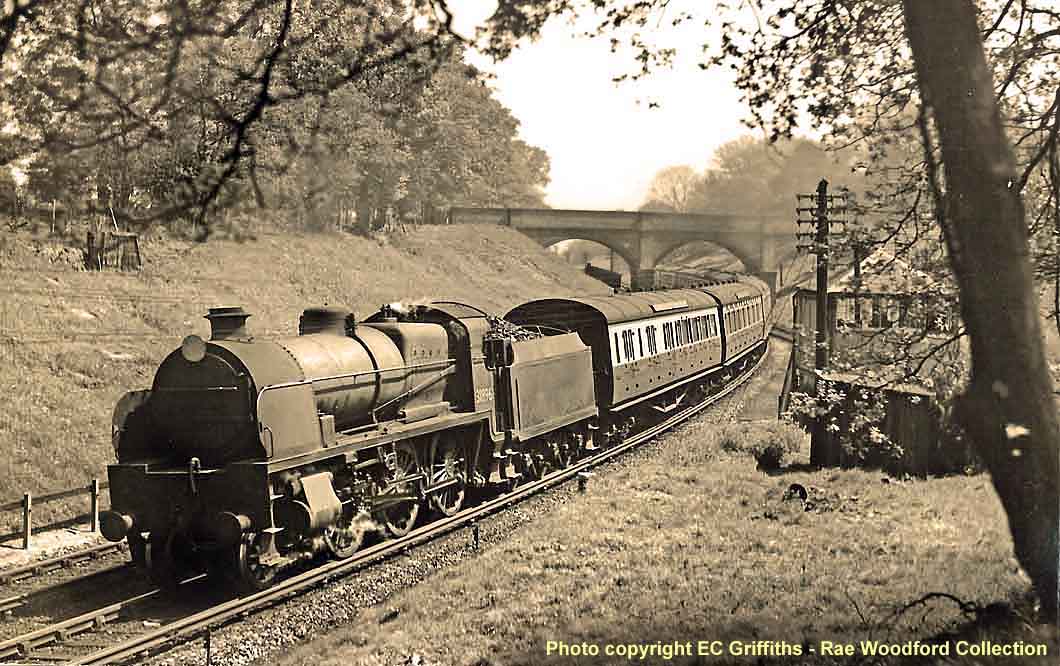
(Above-Below) 75B Redhill based U1 Class 31896 negotiates the 40mph curve at Ash Junction with an Inter-Regional passenger service. (Below) K Class 32348 leaves Farnborough Main station with a stopping passenger service from Waterloo to Basingstoke.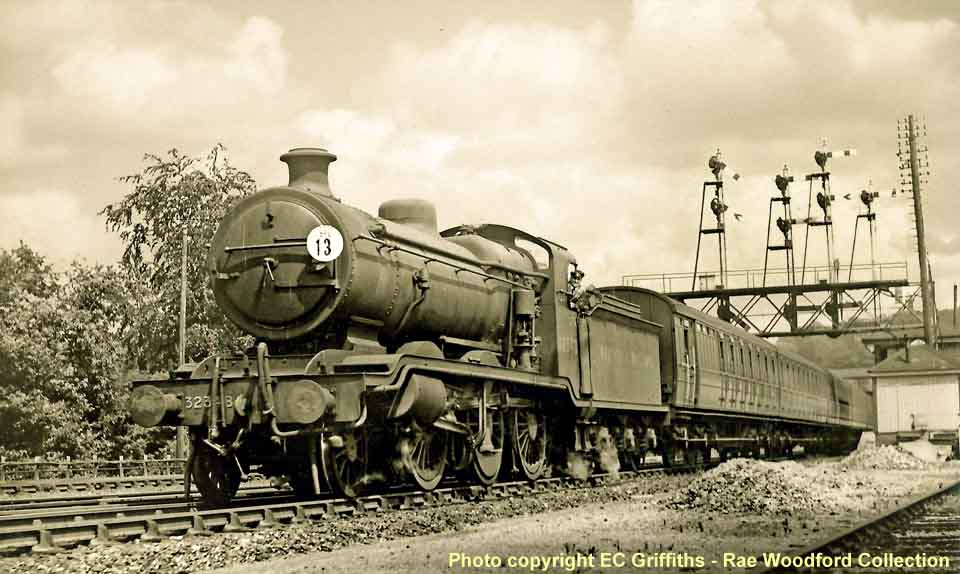

(Above-Below) Original Battle of Britain Class 34052 'Lord Dowding' passes under the Old Potbridge Road Bridge between Hook and Winchfield working a Bournemouth-Waterloo Express.(Below) H2 Class 32421 'South Foreland' eases up onto some coaching stock as the shunter waits to couple up at an unknown location. One of six locomotives designed by DE Marsh and LB Billington, the locomotives were built at Brighton Works between 1911-1912. She was withdrawn from service in 1956.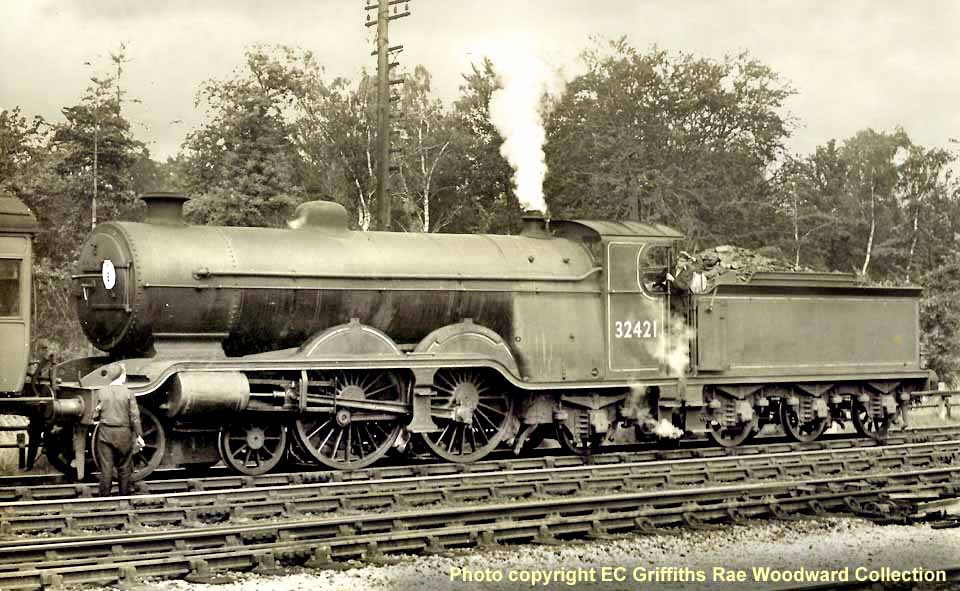
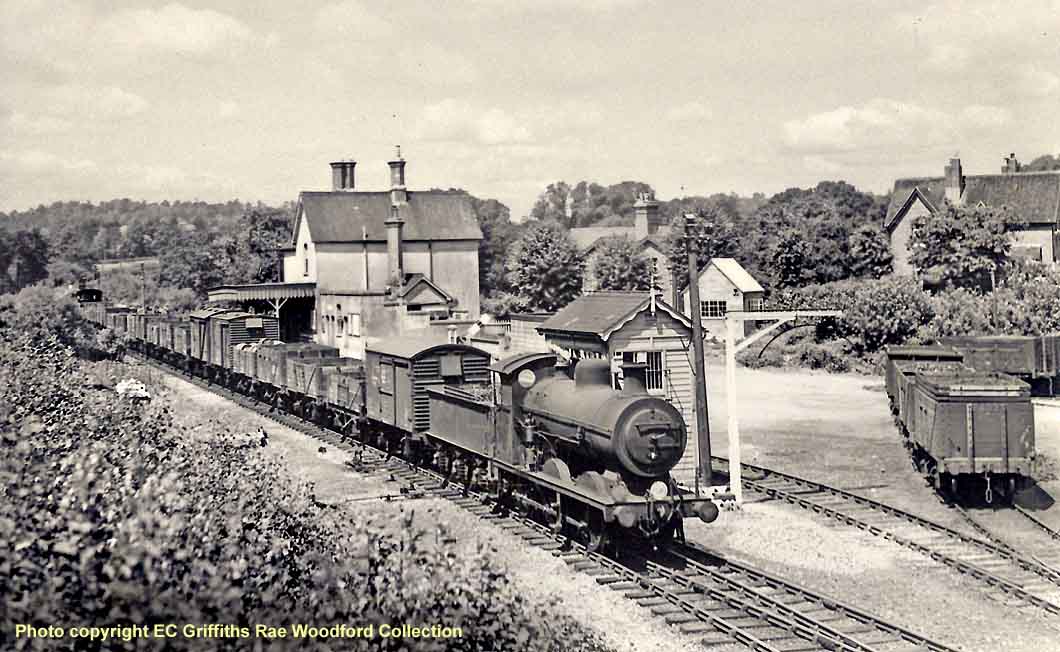
(Above-Below) An unidentified C2X Class locomotive runs through Rudgwick with a local pick-up freight train bound for Horsham. (Below) M7 Class No 54 works a local passenger service over the Meon Valley line at an unknown location. 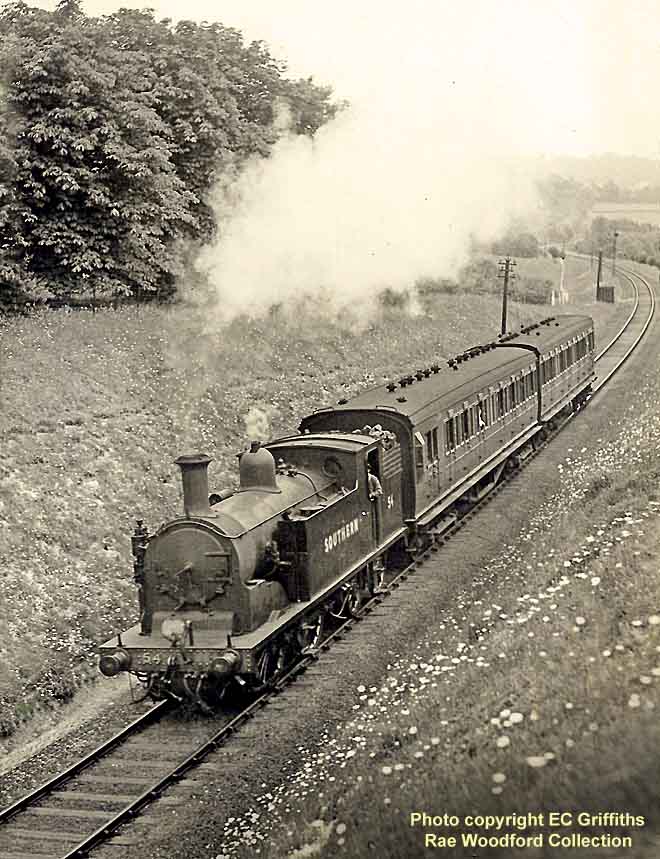
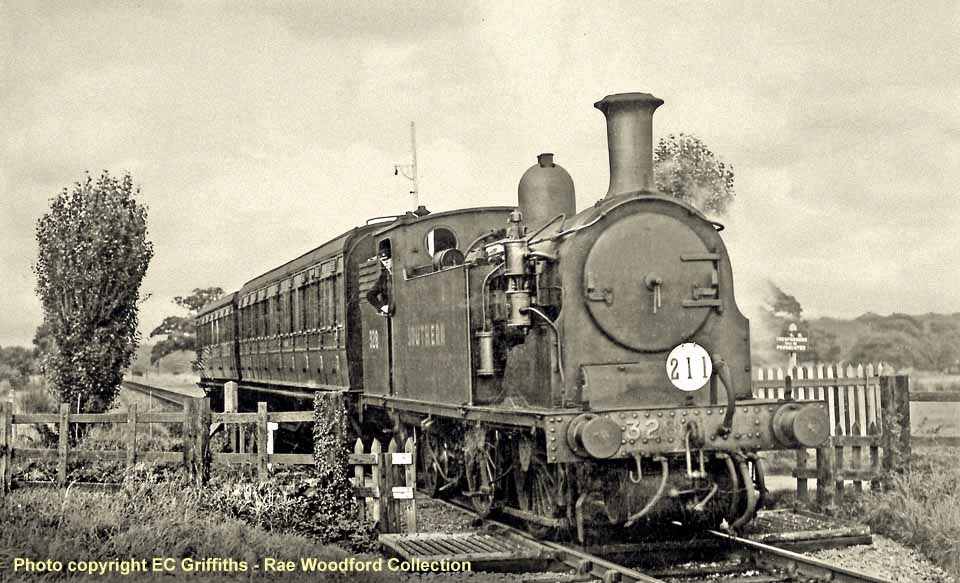
(Above-Below) M7 Class No 328 runs into Kingsley Halt station with a Push-Pull set on the Bentley - Bordon Branch. (Below) K10 Class No 141 approaches Farnham Junction with a stopping passenger service which probably started from Fareham and travelled over the Meon Valley line. Nicknamed 'Small Hoppers' the locomotive was based at Guildford (70C); withdrawal came in 1949.

(Above) An unidentified single-domed C2X 0-6-0 (rebuilt by Marsh from an RJ Billinton C2 Class) passes Rudgwick distant signal with a local freight service. Fomr nationalisation until withdrawal, twelve of this class were at one time or another allocated to Horsham (75D) shed.
(Below) An unidentified former LBSCR Lawson Billinton B4X class locomotive hauling a local passenger service, passes Ash Junction box as the driver exchanges some form of gesture with the gentleman climbing the signal box steps. Rebuilt from a B4 designed by Richard, his father, the rebuilds spanned the grouping and took place between 1922 (2 of them) and 1924 (the remaining 10). Of the twelve B4X rebuilds, eleven survived into BR days but all had gone by the end of 1951. They had the nickname 'grey back' because the first rebuilds were turned out in a grey livery rather than the LBSCR unlined umber. Some of these B4X's were allocated to Redhill after nationalisation and a few even spent some time at Basingstoke. My thanks to Mike Morant for the additional information. 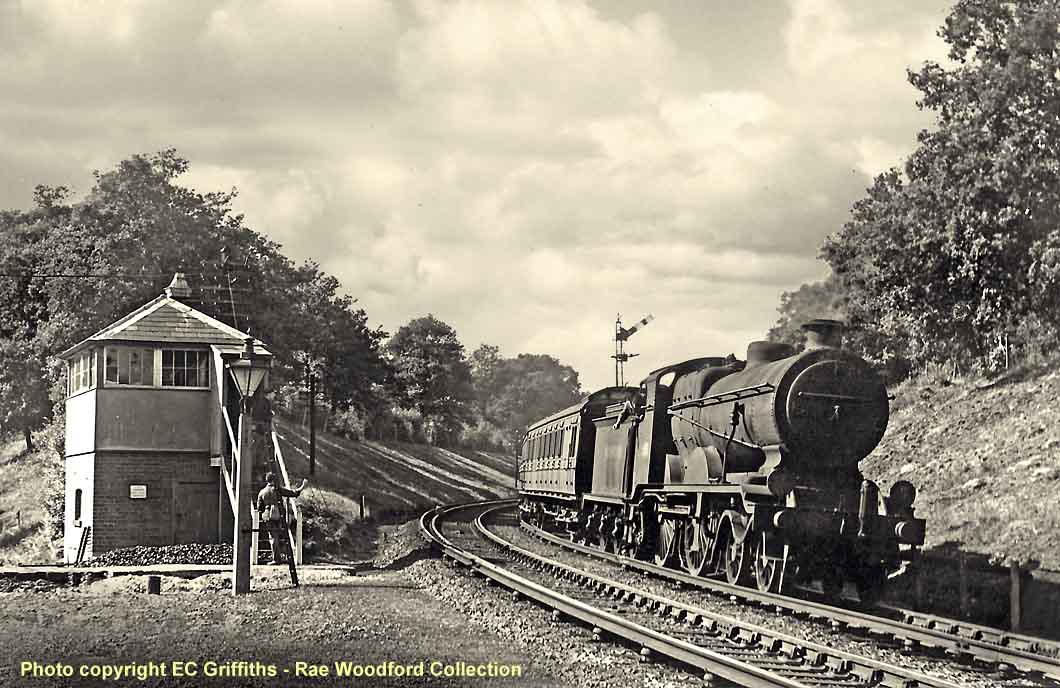
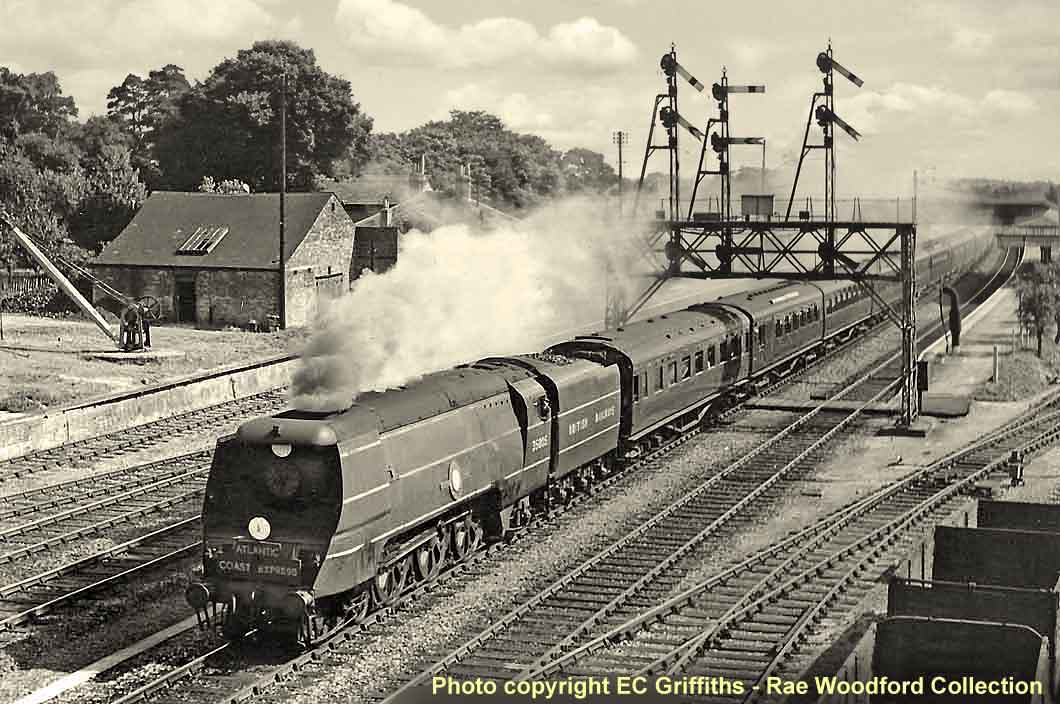
(Above-Below) Original Merchant Navy Class 35005 'Canadian Pacific' hurtles through Winchfield station with a Waterloo-Exeter express. The locomotive will be exchanged for another of the same type at Salisbury before the train continues its journey to Exeter. All of the 30 Merchant Navy class Pacifics were modified (streamline casing removed and fitted with Walschaerts Valve Gear) with No 35018 'British India Line' being the first to be released into traffic from Eastleigh Works in 1956 and the last No 35028 'Clan Line' in 1960. (Below) Austerity Q1 Class No C7 approaches the 30mph curve at Farnham Junction whilst working a passenger service from Alton to Woking. The line branching off to the right led to Tongham and Ash Green before joining the Reading-Guildford line at Ash Junction. 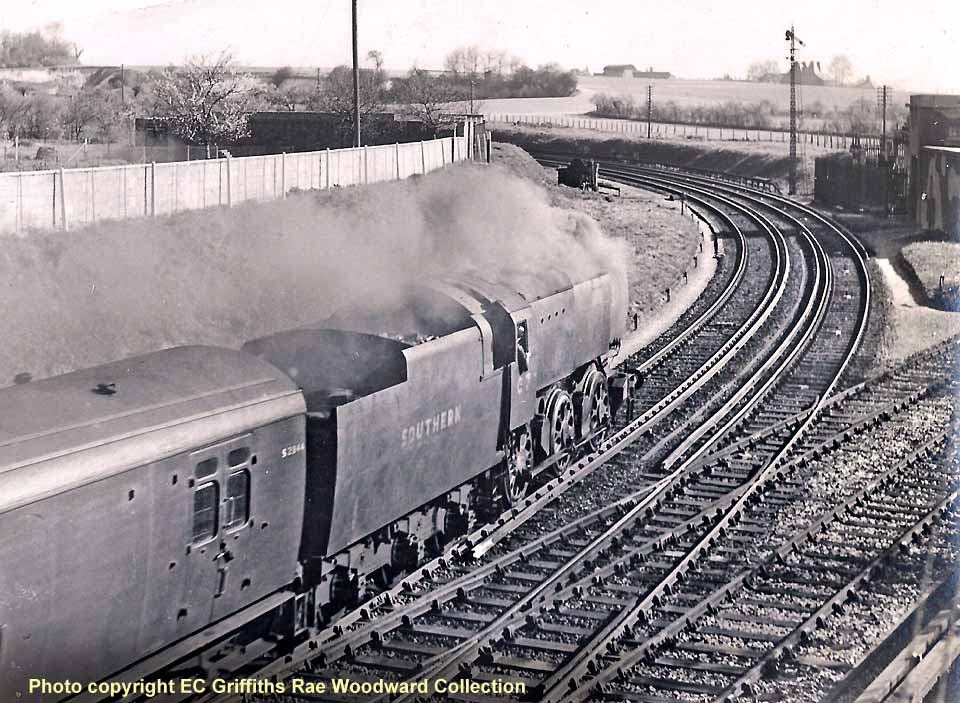
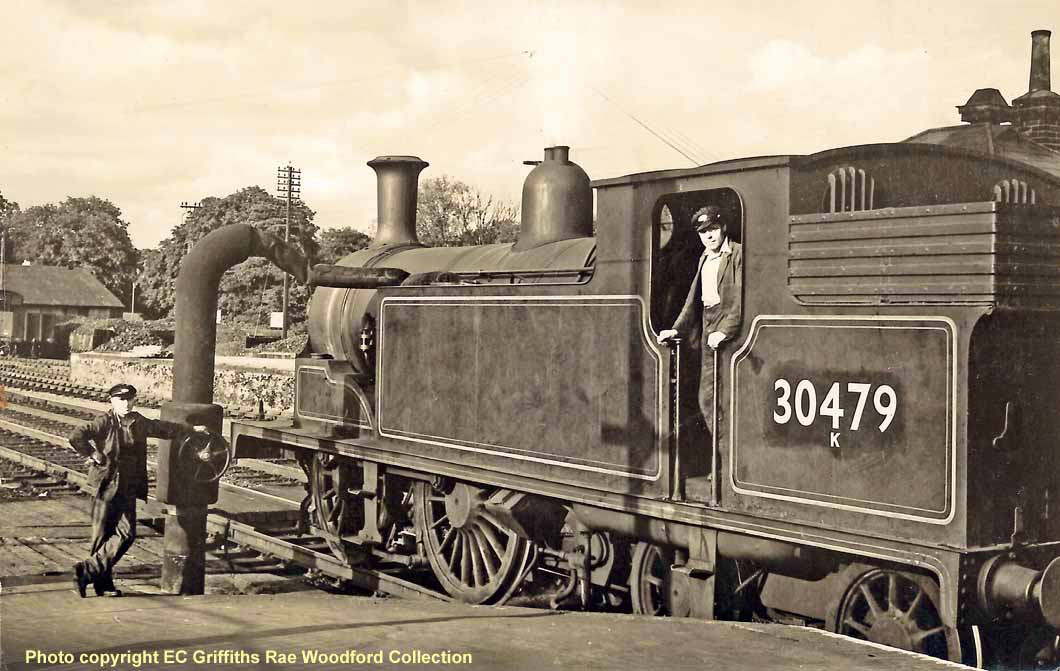
(Above) The footplate crew of Eastleigh based M7 Class 30479 pose for the photograph as they replenish the water tanks at Winchester City station.
ALFRED JAMES TEMPLE COLLECTION 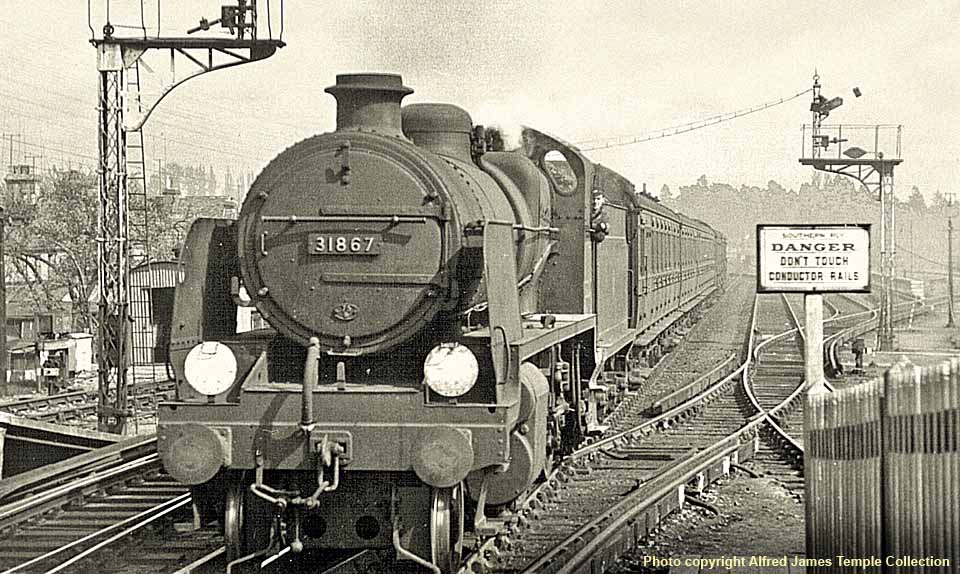
(Above-Below) N Class 31867 runs into Reigate with a stopping passenger service for all stations to Guildford and all stations to Reading. (Below) With regulator wide open, N Class 31867 again, this time storming through Chilworth with a heavy eleven-coach train circa 1955. 
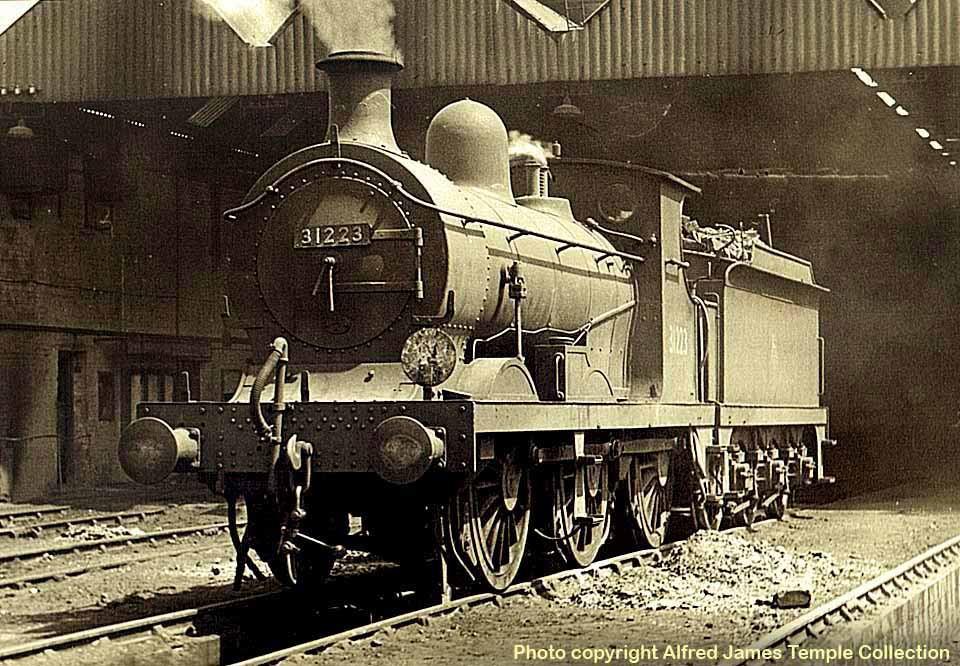
(Above-Below) C Class 31223 awaits its next turn of duty outside Redhill Shed. (Below) The fireman prepares to clean the fire on K Class 32342 at Redhill Loco.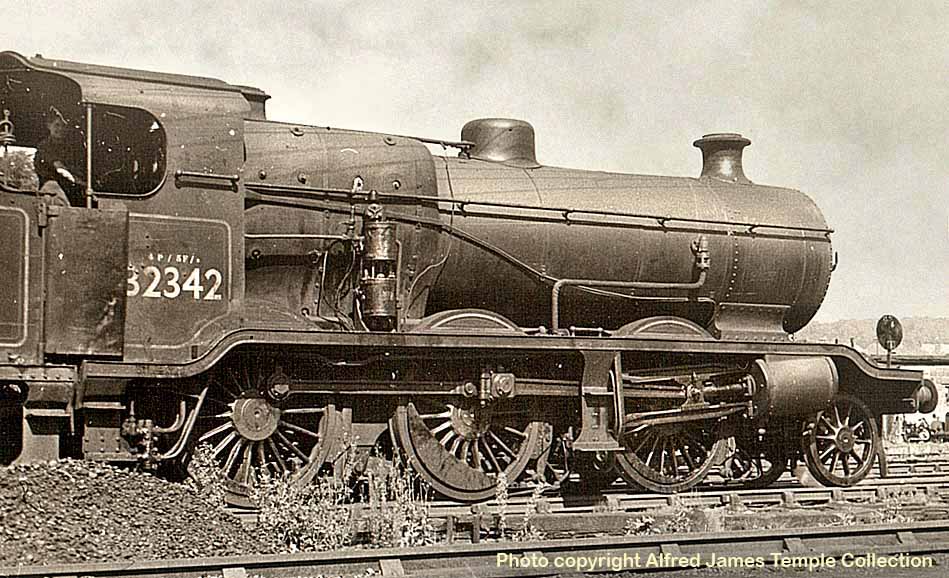
STEAM DAYS AT BETCHWORTH
(Below) Cab view running towards Betchworth station on the SE&C's Reading, Guildford and Reigate line with a stopping service to Redhill. 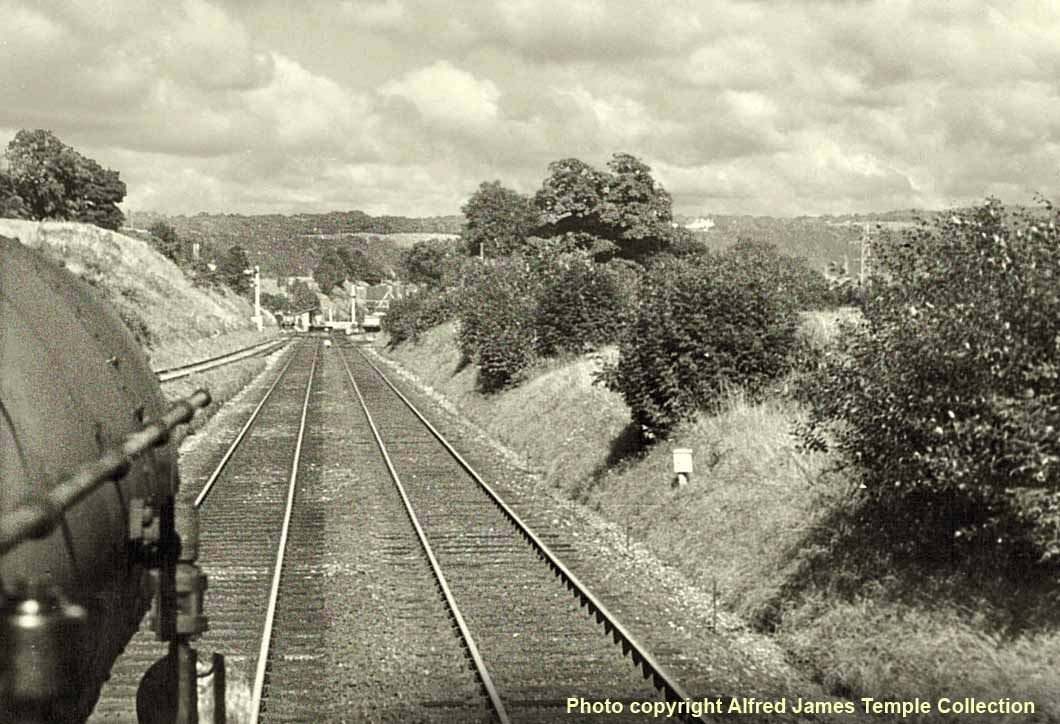
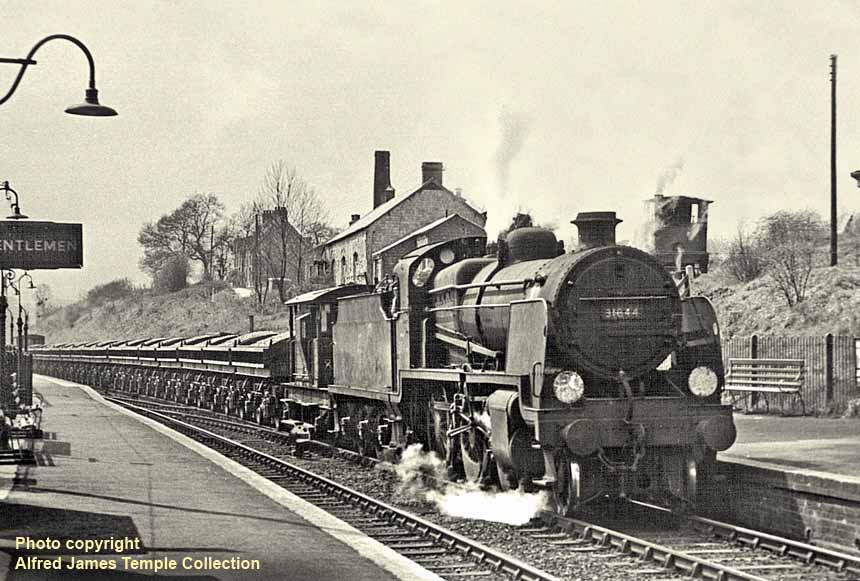
(Above) N Class No 31844 hauls a stone train consisting of loaded side-tipping Mermaid wagons through Betchworth station heading for Redhill Yard. The stone train would have started its journey at Meldon Quarry in Somerset. The tank engine in the background belonged to the Brockham Quarry and Lime Works. The 'Old Dorking' Lime Works, as it was commonly known, obtained its chalk from two quarrying areas in the face of the North Downs. Chalk was dug by hand and loaded into narrow gauge railway wagons for haulage to the kilns. A standard gauge siding connecting with the SE&C's main line was worked by a steam engine built by Filmer and Mason of Guildford in 1874. Click HERE to read more about this interesting Lime Works. 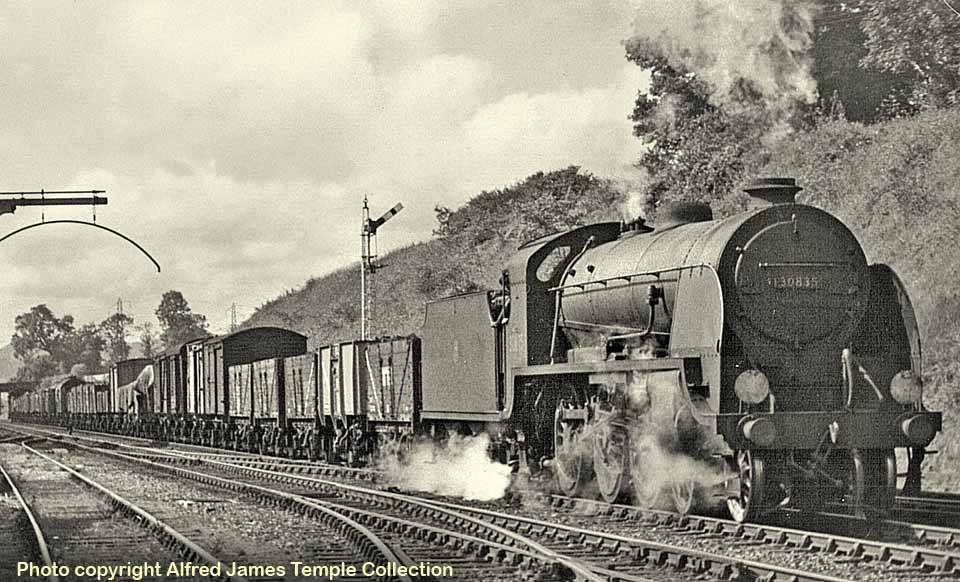
(Above-Below) S15 Class 30835 passes Betchworth's home signal with a heavy freight towards Redhill. Designed by RW Urie, the S15 class 4-6-0 was introduced on the LSWR in 1920-21 for freight work on the Southampton and West of England main lines. Construction of the class continued in 1927 and 1936 when REL Maunsell became CME. In BR days the Urie engines were numbered 30496-30515 in the fleet, and the Maunsell engines 30823-30847. Although designated Class S15, the Maunsell engines differed slightly with a straight footplate over driving wheels and cylinders, whereas the footplate on the Urie engine was further raised over the cylinders. (Below) A legacy of the LSWR the thirty 700 Class (Black Motor) 0-6-0 tender engines were designed for freight work by Dugald Drummond in 1897 for the London and South Western Railway and built by Dubs and Company at the company's Queen's Park works at Polmadie, Glasgow. Here a Redhill - Reading service headed by 700 Class No 30692 runs into Betchworth station. The locomotive is sporting a 70A shedplate meaning that at that time, she was shedded at Nine Elms. 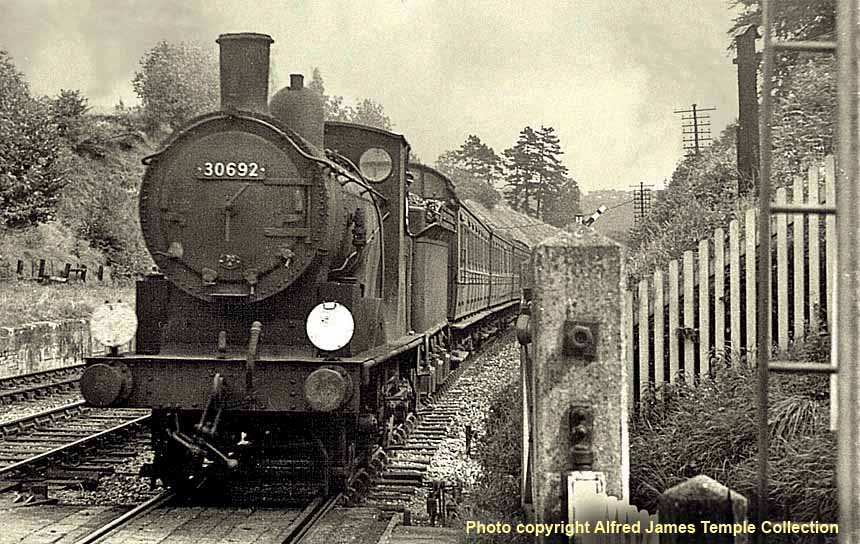
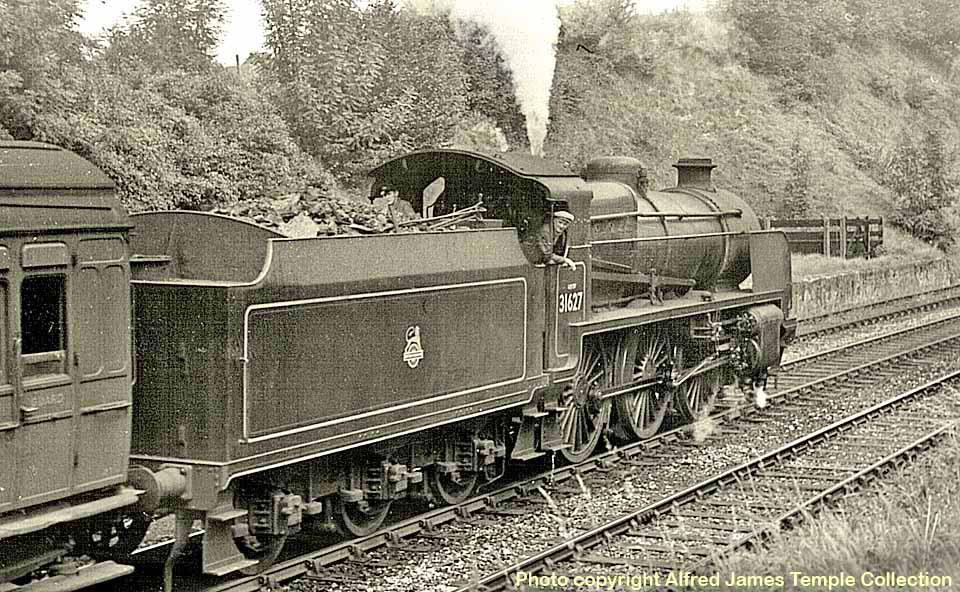
(Above-Below) The Driver of U Class 31627 looks back at his train as he leaves Betchworth station with a stopping passenger service to Redhill. (Below) S15 Class 30837 runs through Betchworth station with a heavy freight from Reading to Redhill. Elsewhere on the Southern Region pages, my work colleague at Guildford, Pat Kinsella, recalls his early days on the footplate, in particular his first firing turn on an S15 30837. He writes - 'My driver, a Reading man, had to help me out quite a bit with the shovelling. The S15s were a very large locomotive with the injector steam valves set high up close to the cab roof. It is part of the fireman's duties to maintain the boiler water level using these injectors but unfortunately a few junior firemen couldn't reach them, consequently some drivers demanded taller stokers!' 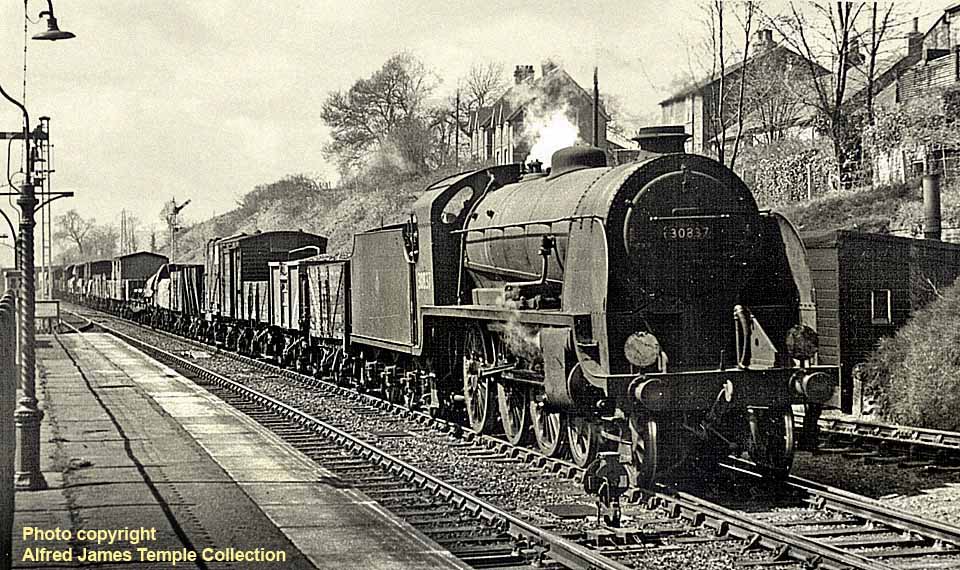

(Above-Below) U Class No 31797 runs through Betchworth with a local freight from Reading to Redhill. Note the electric lights fitted to the front of this locomotive. No 31797 was also temporarily converted to oil burning in 1947 but due to the chronic post-war shortage of oil it was reinstated back to coal burning. (Below) A grand old lady of the Southern Railway, D Drummond's famous London and South Western 'Greyhound' class made its first appearance in 1899. Here No 30718 leaves Betchworth station with a Redhill - Guildford - Reading passenger service circa 1955. By 1961 all 66 members of the class had been retired. 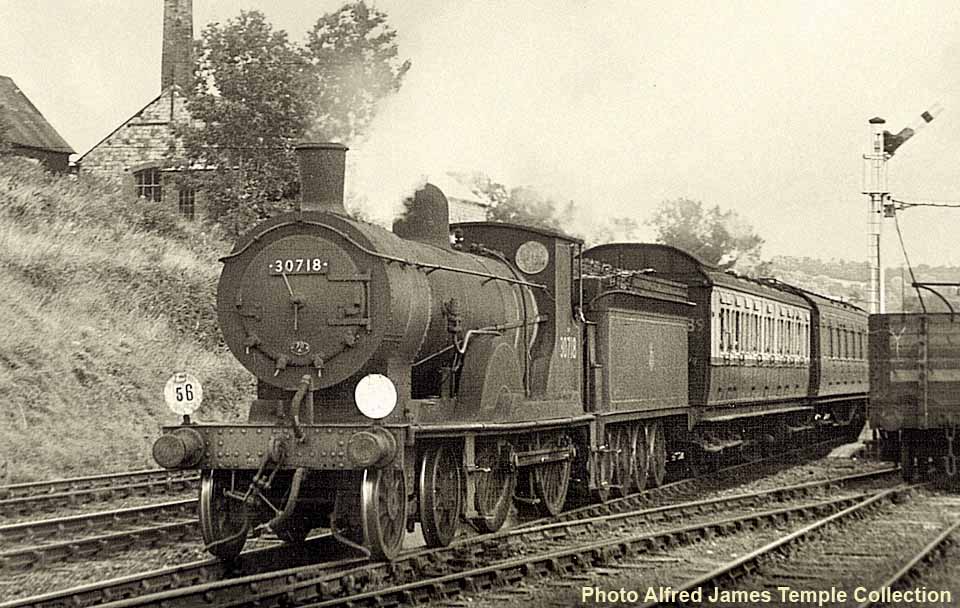
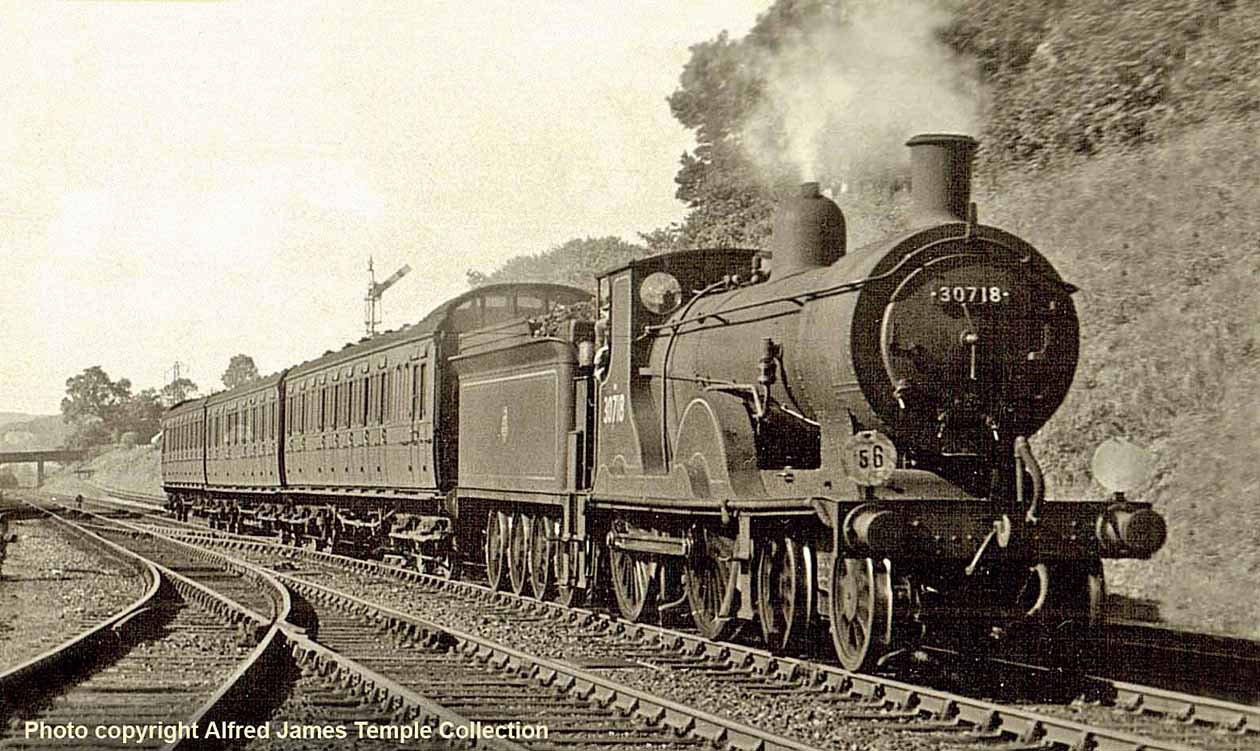
(Above-Below) T9 Class No 30718 passes the outer home signal at Betchworth with a stopping passenger service for Reigate and Redhill. The T9 class locomotives were nicknamed 'Greyhounds' due to their rapid turn of speed; indeed even in old age they were still capable of speed in excess of 80mph. (Below) S15 Class 30836 hauls a heavy freight through Betchworth station bound for Redhill. 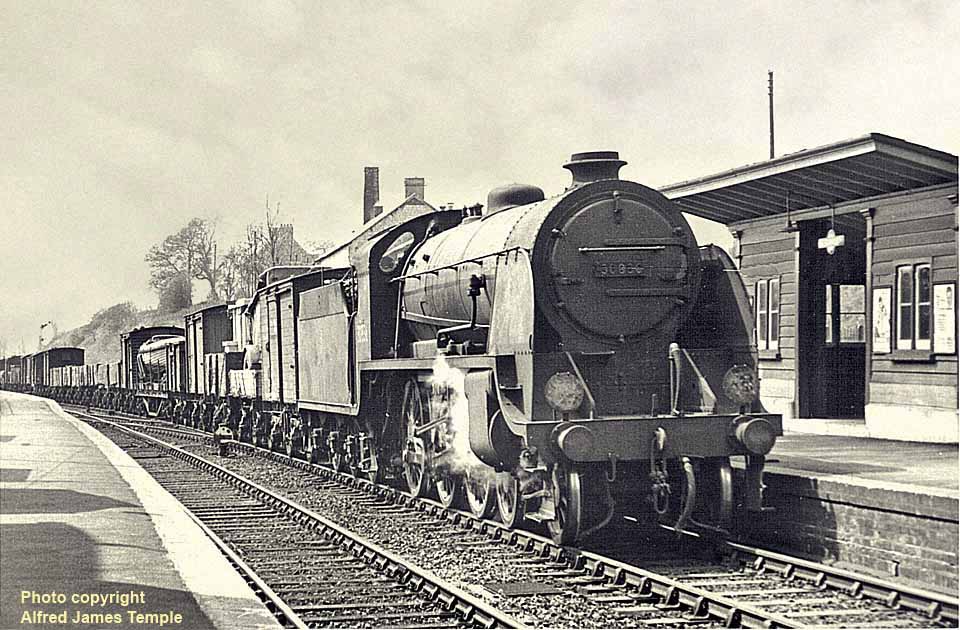
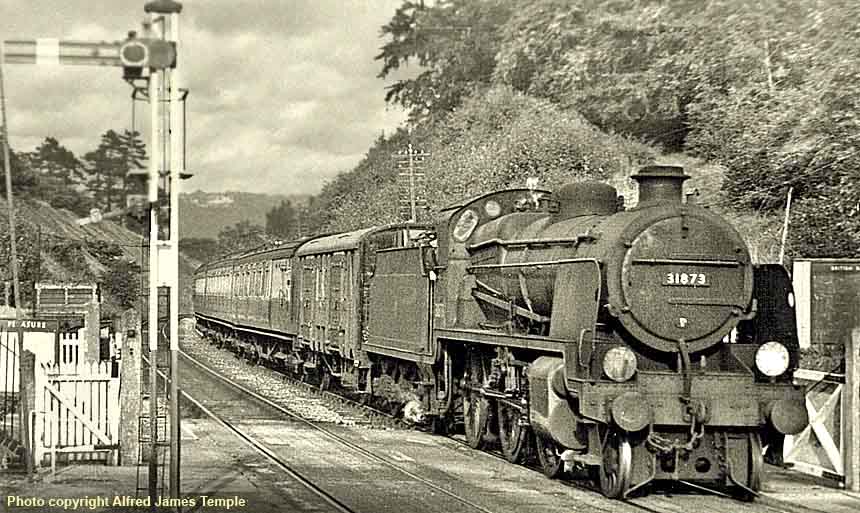
(Above) N Class 31873 runs into Betchworth station with a Redhill - Reading stopping passenger service.
DORKING TOWN STATION
(Below) Geoff- can you help with a bit about Dorking station……A view from the cab as the train rushes down Dorking Bank towards Dorking Town station. A Q1 Class is working a freight to Guildford in the opposite direction. 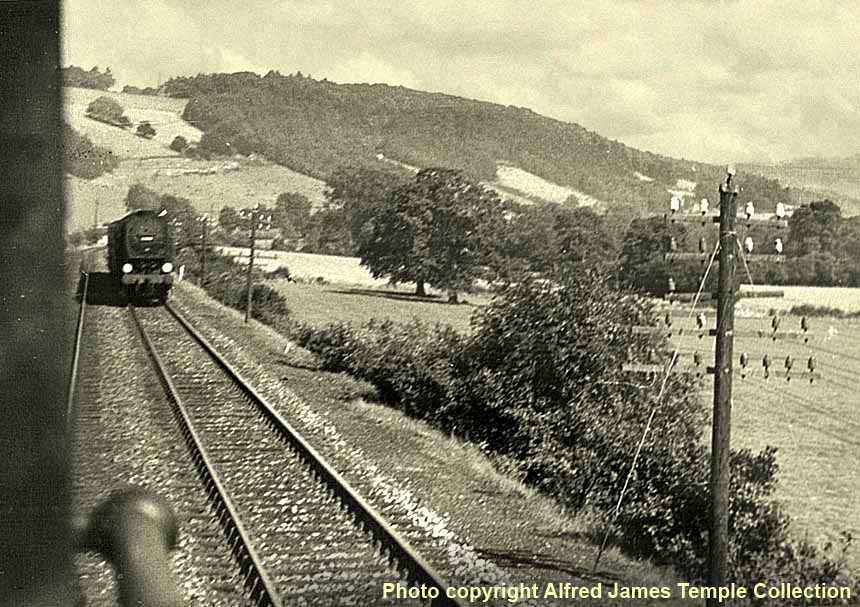
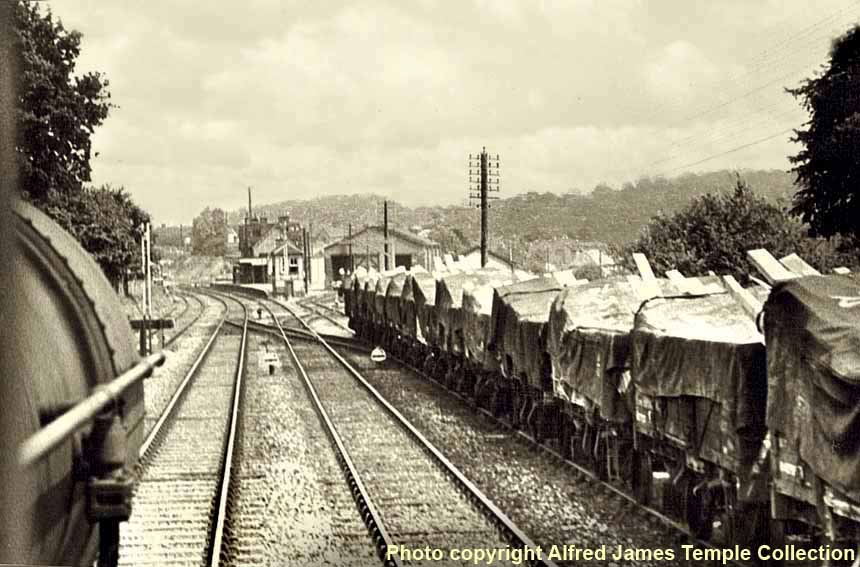
(Above-Below) Another cab shot as the train is about to run into the staggered platform at Dorking Town station with a stopping service from Guildford to Redhill. A large consignment of wooden planks can be seen in Dorking Yard. (Below) The London Brighton and South Coast Railway's Class K were powerful 2-6-0 mixed traffic locomotives designed by L.B Billinton in 1913. Introduced to traffic shortly before the First World War the first ten examples of the class did prodigious work on munitions, supply and troop trains during the conflict with Germany. The locomotives proved their usefulness again during the Second World War, and continued to provide reliable service until the 1960s. The entire class was eventually withdrawn en-bloc at the end of 1962. Here No 32342 performs a shunting move at Dorking Town Yard prior to setting off towards Redhill Yard. 
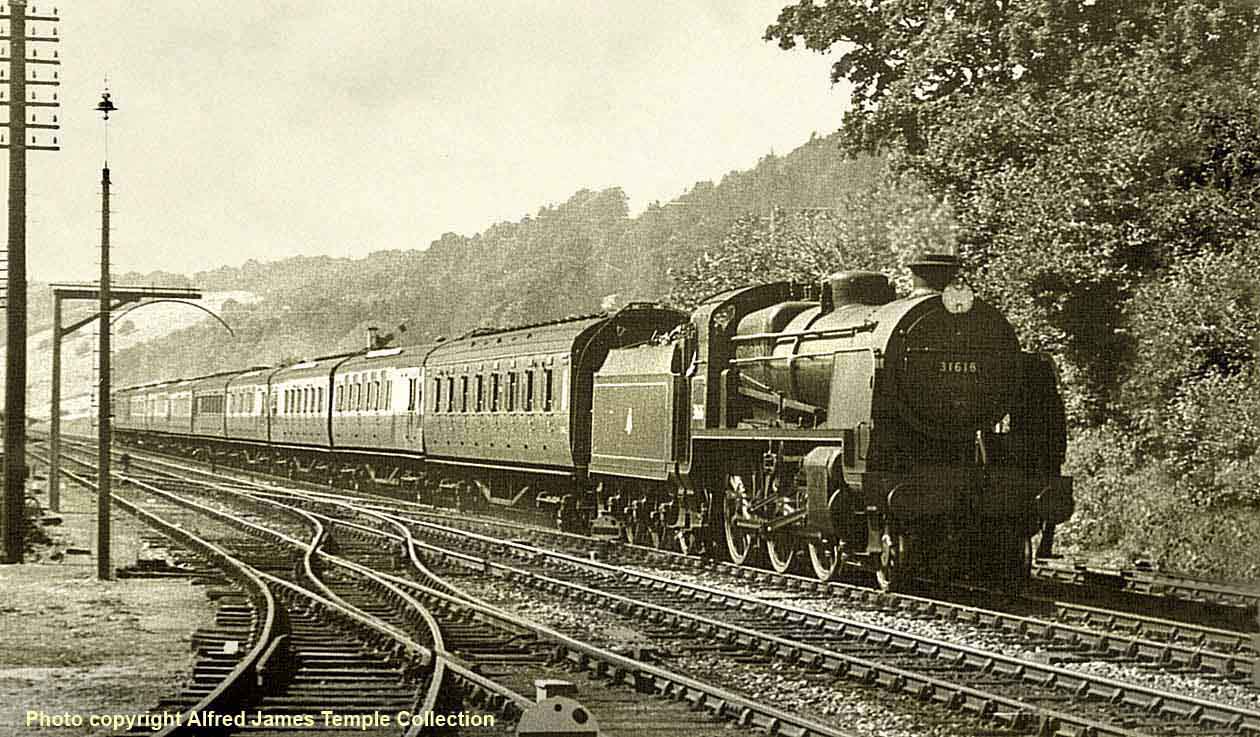
(Above) U Class 31616 runs down Dorking Bank towards Dorking Town with a Continental Express, known colloquially as the 'Conti'. One of these holiday trains, often made up of twelve coaches, ran each way on weekdays between Birkenhead and Margate, Dover and Eastbourne. On Saturdays during the summer months many more operated between the Midlands and the Sussex and Kent coast.
EASTLEIGH WORKS OPEN DAY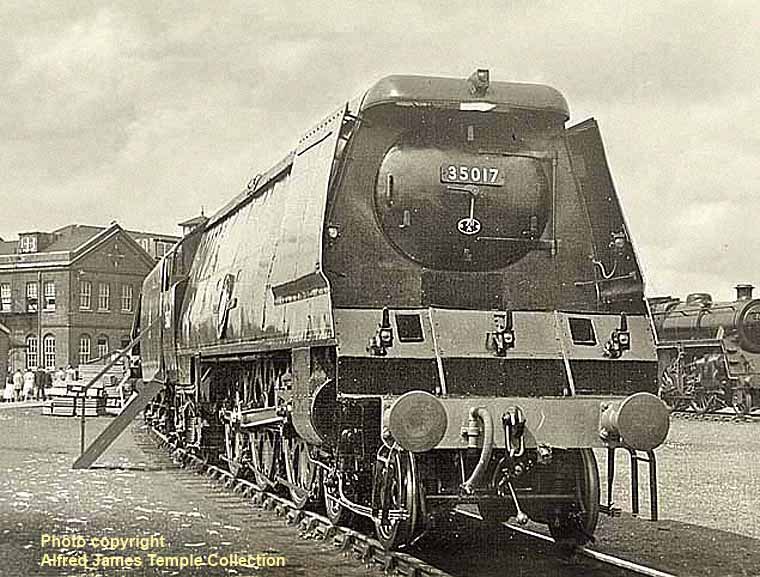
(Above-Below) Fresh out of shops, 'Merchant Navy' Class No 35017 Belgian Marine stars as an exhibit at an Open Day at Eastleigh Works in August 1953. (Below) The expansive yard at Eastleigh Works provided a splendid setting to display the latest locomotives available to the Southern Region, including Class 7P6F 'Britannia' 70004 'William Shakespeare', seen here taking a break from 'Golden Arrow' duties in order to attend the day's proceedings. Built at Crewe Works in March 1951, a decision was taken to upgrade the already quality finish of this Britannia locomotive in readiness for display at the 'Festival of Britain' exhibition at Marylebone Station, arriving there on the 2nd April 1951. A move to Stewarts Lane depot (73A) ensued and the engine became a relative fixture on the Southern Region along with 70014 Iron Duke for 'Golden Arrow' duties until its transfer to Kentish Town (14B) on the London Midland Region in June 1958. 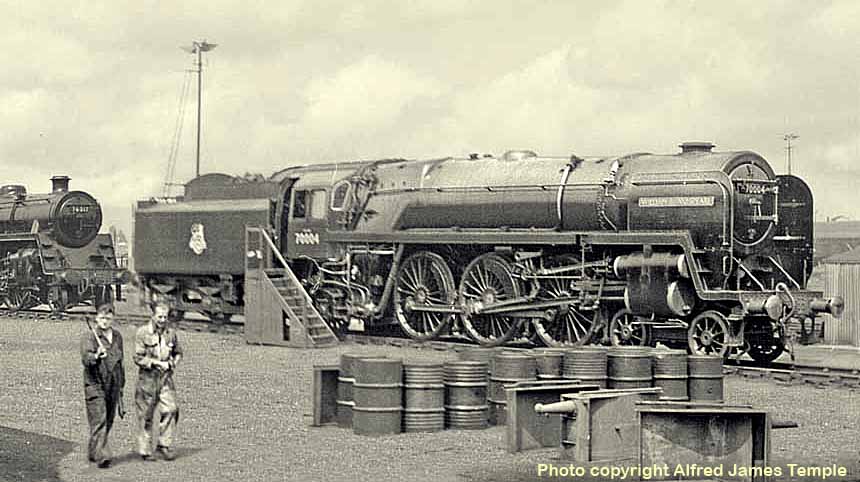
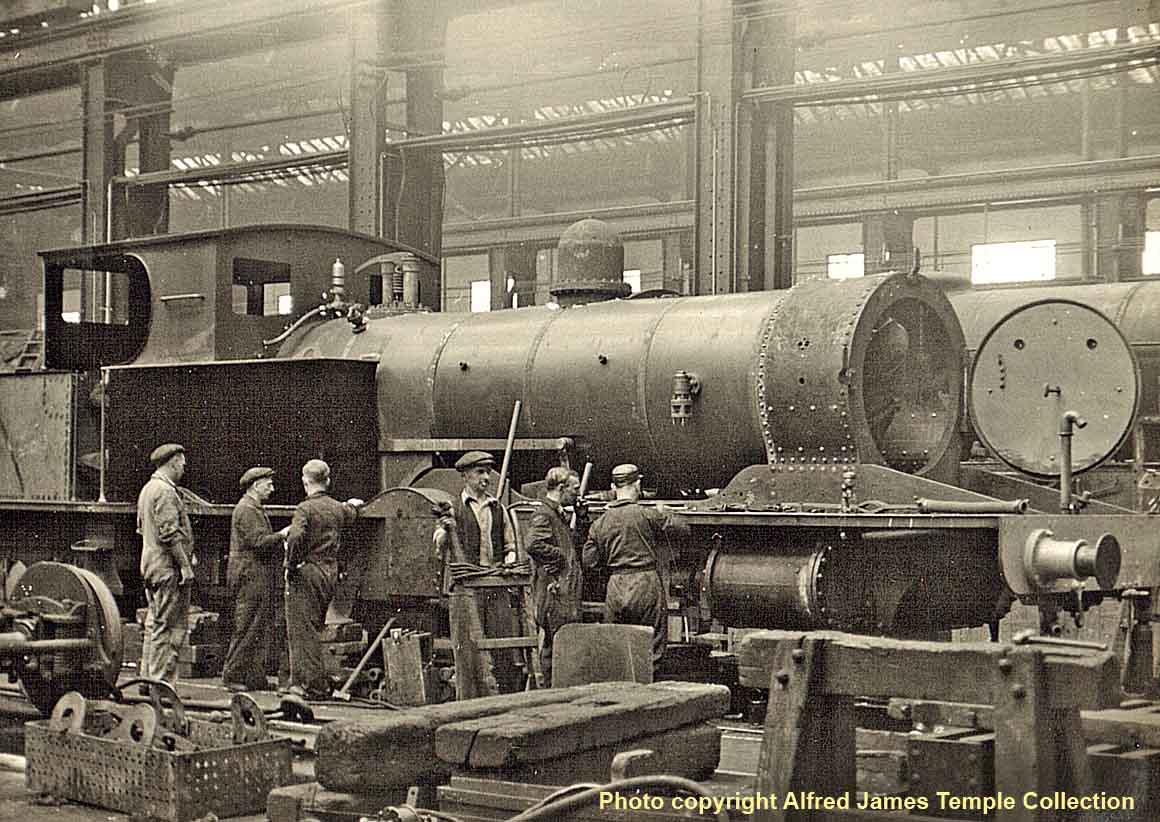
(Above-Below) A couple of veterans added to the mix at Eastleigh's Open Day The Adams Class '0415' 1P 4-4-2Ts were used on suburban work in the London area, but following 3rd-rail electrification a large number were taken out of service and stored at Eastleigh. Three examples were retained by the Southern Railway for working the Lyme Regis branch where the 4-4-2T's flexible wheel base was found ideal for the many curves on the branch. The line closed after being taken over by the Western Region and the three engines were subsequently withdrawn. One example, No 30583, was secured for preservation and restored to its old livery as LSWR. (Below) Twenty Adams LSWR T3 Class 4-4-0s were constructed at Nine Elms between 1892-1893; all passed to the Southern Railway in 1923. Withdrawals started in 1930, and by the end of 1933 only three remained: No 557 went in 1936, 571 in 1943, and the last, 563 was retired in August 1945 and set aside for preservation. 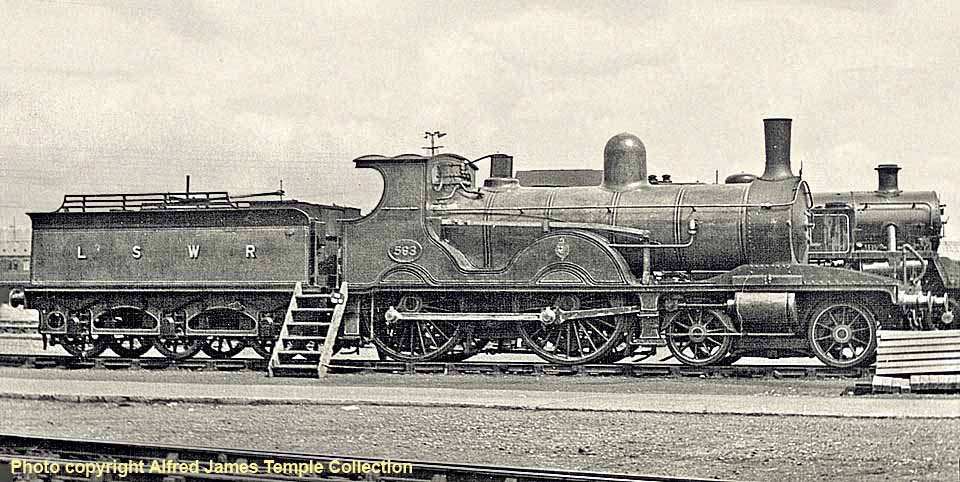
MYSTERY PHOTOS 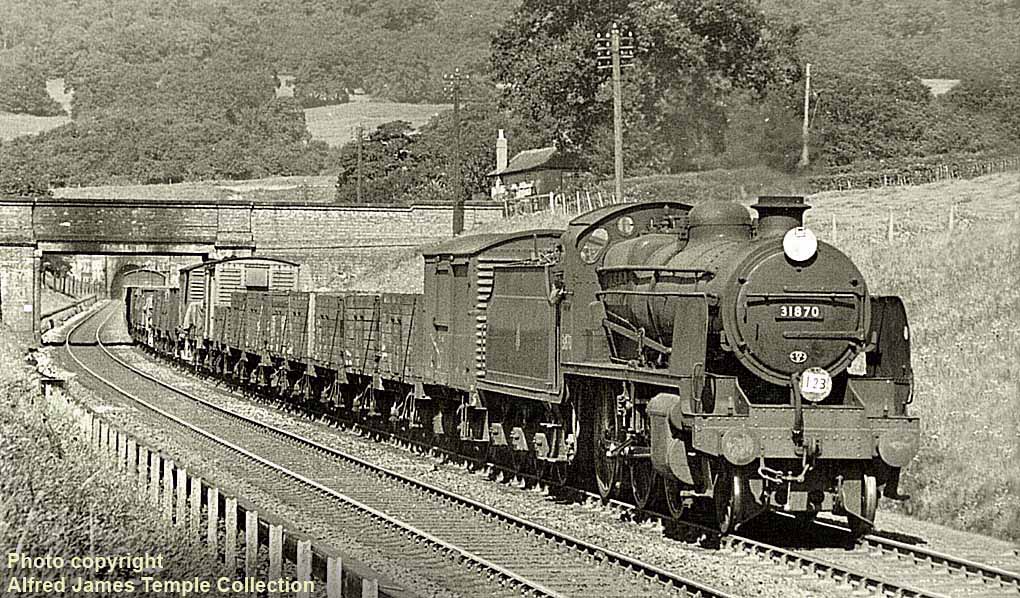
(Above) Since I'm unable to identify the location of this N Class 31870 hauling a freight somewhere on the South Eastern Section (a second shot of 31870 working a different train at the same location is featured below) I contacted members of the ' Old Railway Buffers - Southern Types' Facebook Group.
Don Clarke thinks the photo was taken on the down line just south of Sevenoaks tunnel, whereas Jim Rowe suggests it could be the eastern end of Sevenoaks tunnel, but added it does look a bit built-up for the period; all are coasting so on an easy grade…Graham Inky Penn said Polhill and Kevin Auger agrees; adding that it looks like the sweeping curves from the Polhill Tunnel exit heading towards Sevenoaks. Steve Upton thinks it is the Country end of Polhill Tunnel...whereas Nigel Turner thinks it is the country end of Sevenoaks tunnel, adding that the country end of Polhill has a left-hand curve before you enter…Bob Cartwright concurs with Sevenoaks; he says the bridge carries the road from the village of Sevenoaks Weald, a quarter of a mile or so to the left. He thinks the working will shortly pick up the signals for Weald Intermediate Box, and it is prior to 1957 as no juice rail. The headcode on the 'Packet' is Victoria - Dover, so maybe a boat train….Nigel Turner suggests that the water pipe running from a well in the tunnel to feed Tonbridge loco shed can be seen on the left….Charlie Verrall (see Page 38) says the discs indicate services via different routes to Dover. Most certainly 31870 would have been a Bricklayers Arms loco, and the MN (below) is a Stewarts Lane loco, however the SE Section was not one he visited often, and certainly never to take photographs.
So, all in all, the response was terrific albeit the results varied. Perhaps someone has the definitive answer?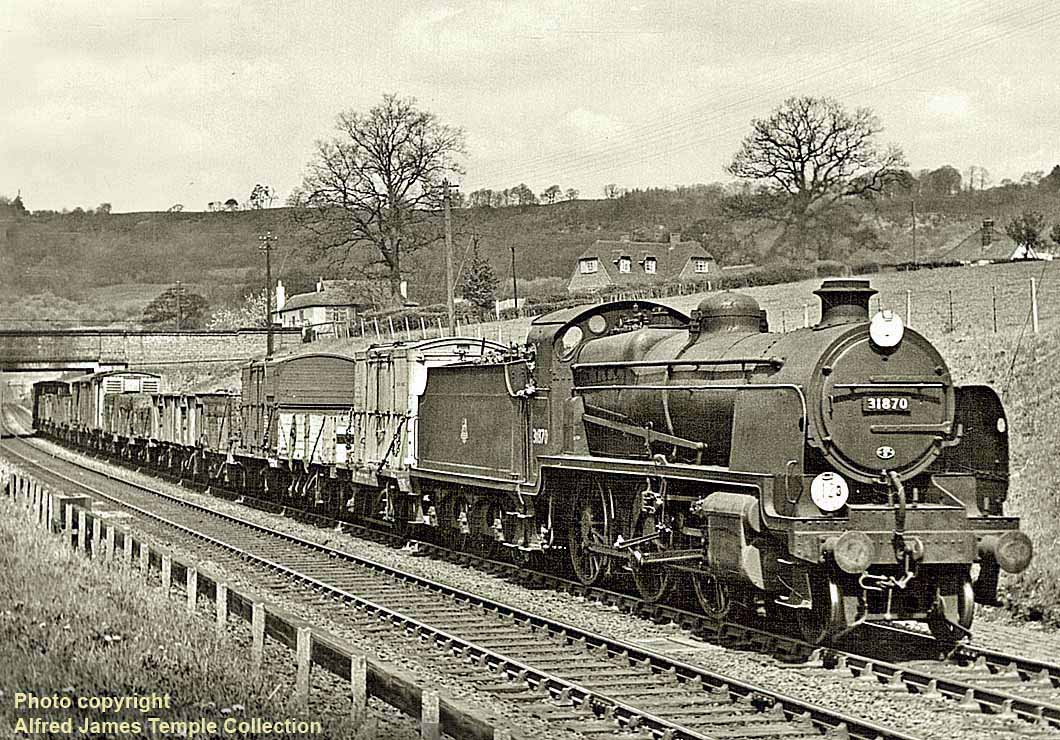

Mystery solved! I have received information from ex-Tonbridge driver, Alan Goodwin, who writes - 'I have just found the mystery location photographs on your page and can confirm that the pictures of 31870 and 35029 (above) were taken at Weald bridge, just south of Sevenoaks tunnel, and the one of the MN 35029 'Ellerman Lines' was taken prior to May 1955 when it was transferred from Dover to Nine Elms.
Best Wishes, Alan…'
I have also received a message from Keith Mitchell, who researched this stretch of line for the Weald History Group; he writes - 'Hi David, I have just discovered your website and I was delighted to see the picture of the N class coasting down the grade from Sevenoaks Tunnel.
I lived at Sevenoaks Weald for 30 years and took a few photographs there (after electrification). I agree with your correspondents that the overbridge in the background is Morleys Road, which leads from Weald village to the A21. The house just visible on the right is beside Morleys Road. The arch in the distance is the southern portal to Sevenoaks Tunnel. As your correspondent states, the train is approaching Weald Intermediate box, which was taken out of service when the line was electrified. A former signalman lived in the cottage that I subsequently bought…this may have explained the amount of SR green and carriage pink paint we found on the walls when decorating!
Sevenoaks Tunnel is is always wet; this is because Greensand sandstone overlies clay. I did some research while living at Weald and the original contractor building the tunnel went bust due to the amount of water. The SER then began the construction work, taking advantage of the flow of water and piped it to its depot at Tonbridge. 
(Above-Below) I have a few of my own photos around the site of Weald Intermediate, including the outside privy that was still standing long after the box had gone. I took this photo (above) on 21 Sept 1980 from near Weald siding. You can make out Morleys Road bridge with the distinctive lighter line (maybe of concrete) below the brickwork running across from each supporting pier. You can also see how the line curves slightly just south of the bridge. On the left is the old privy which was all that remained of Weald Intermediate box at that time. The box was taken out of use in about 1960 when the line was electrified. The privy didn't last much longer after I took the picture. The siding was used for coal trucks to supply the village coal merchant. No doubt the signalmen made sure the box was adequately heated too. I also attach a picture from Morleys Road bridge looking south on 11 June 1981 (below) showing the sub-station.
The photographer of 31870 would have been standing fairly close to where the sub-station was subsequently built. Also visible in the shot from the bridge is the half buried water pipe on the east side of the line. I hope you find this helpful. Regards, Keith Mitchell…'
Footnote: Keith has kindly sent some photos and memories of old spotting days which are featured HERE on the 'Train Spotting - 2' page.
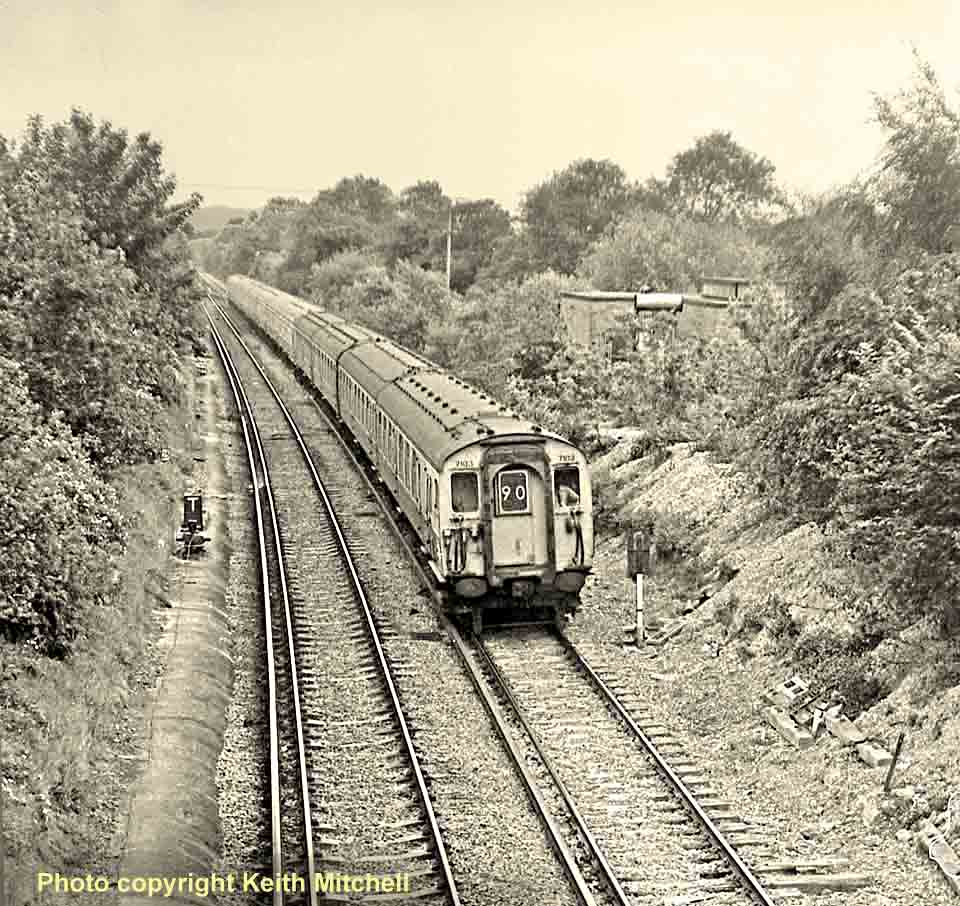
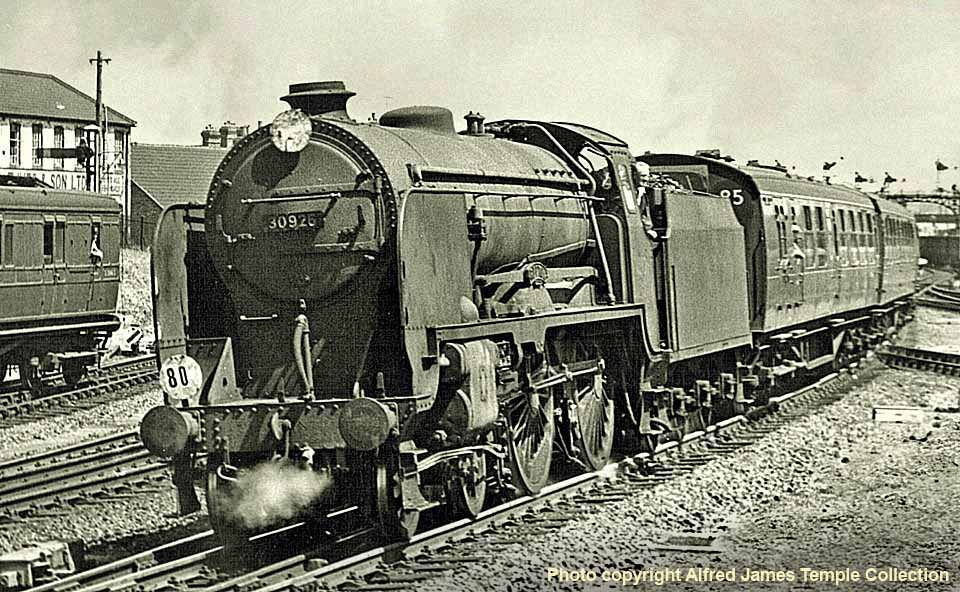
(Above-Below) Two more mystery locations solved! In my original caption for the photo (above) I said - V Class 'Schools' 30926 'Repton' is seen at an unidentified location...but once again ex-Tonbridge driver, Alan Goodwin, writes - '30926 is leaving Tonbridge and rounding the curve towards Sevenoaks, whereas the BR Standard Class 4MT 2-6-4T 80019 (below) looks to me to be leaving Hurst Green Halt (as it was before being rebuilt the other side of the road bridge) and heading towards East Grinstead. You can see the Uckfield line branching off to the right of the picture...'
Thanks Alan...
STEAM DAYS AT SHAWFORD
The small rural station at Shawford on the L&SWR's London to Southampton line between Winchester and Eastleigh, is unusual in having three platforms, one northbound and two southbound. Also a northbound relief line has been retained to avoid delays to express services. In common with most village stations during steam days, Shawford had a thriving goods traffic with a goods yard, offices and station staff. In the early 1990s the goods yard was closed, and following closure of the booking office the station is now unmanned, however the attraction of living in a rural setting combined with a relatively easy commute by train has seen a steady increase in passenger numbers.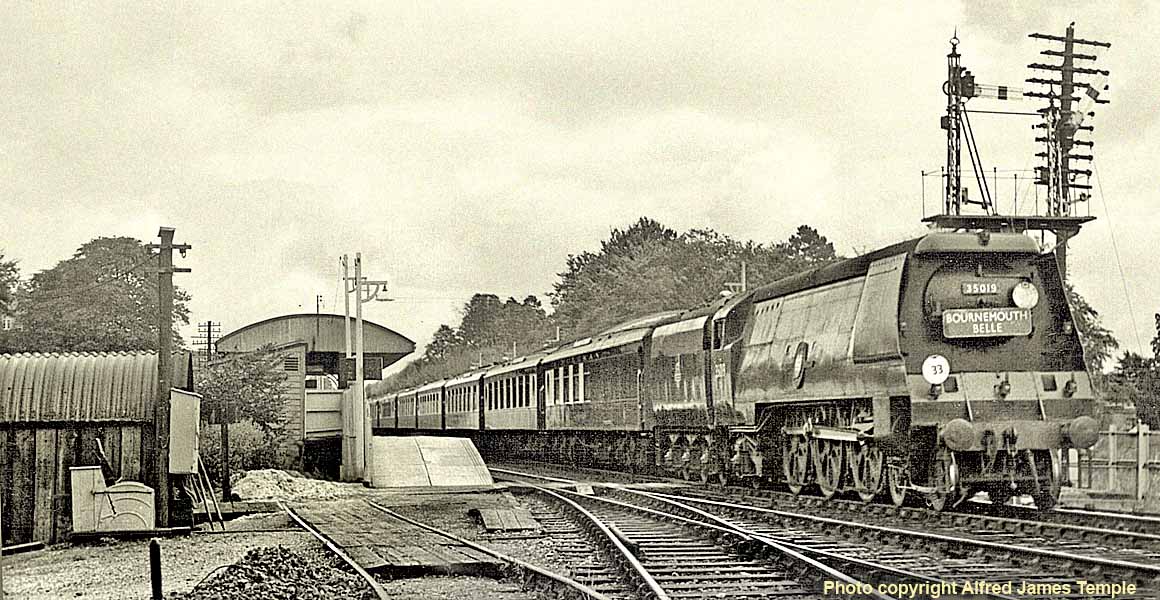
(Above-Below) Merchant Navy Class 35019 'French Line CGT' has authority to pass Shawford's starting signal at danger with the down 'Bournemouth Belle'. This could have been caused by the signal becoming defective. (Below) S15 Class 30509 heads through Shawford with a banana train from Southampton Docks to Feltham Yard. 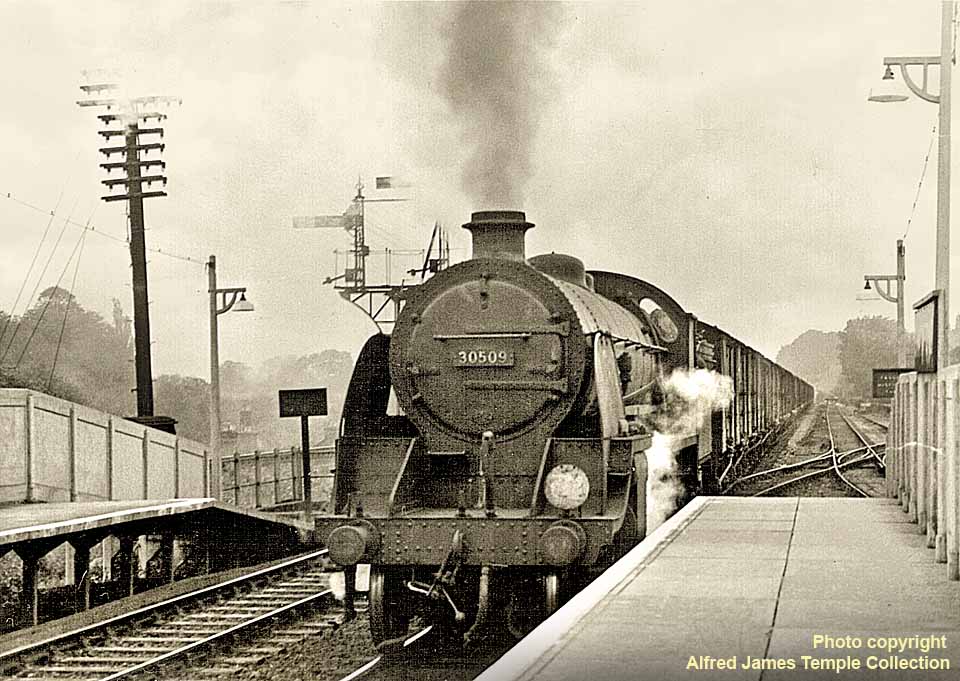
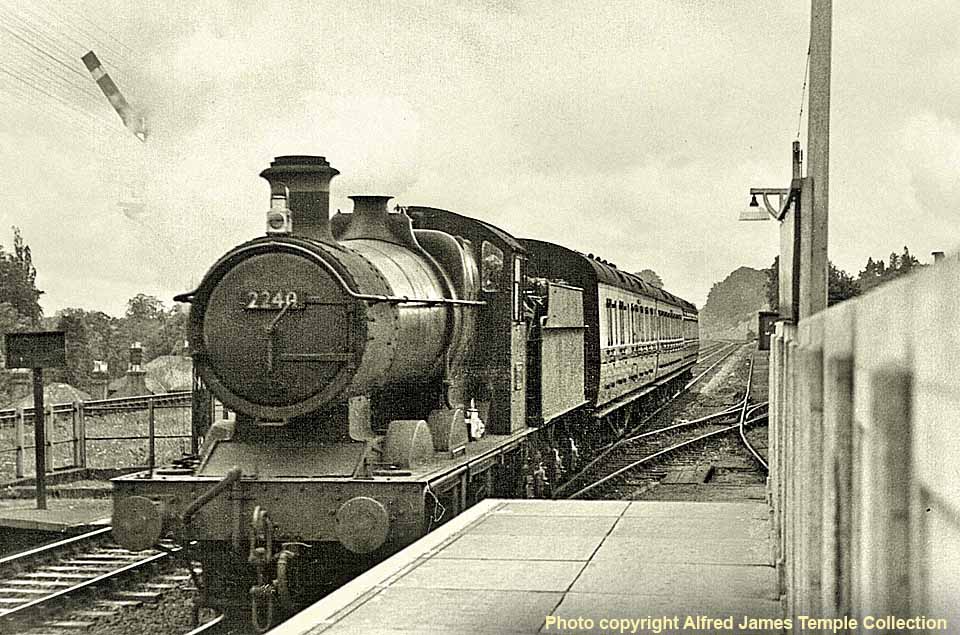
(Above-Below) Ex-GWR 2251 Class No 2240 runs into Shawford station with a passenger service to Newberry via Winchester Chesil (DN&SR) which closed for passenger traffic in 1960. (Below) The headcode of one disc board on the top of the smokebox suggests that BR Standard Class 4MT 76026 is running into Shawford station with a local passenger service from Didcot to SouthamptonTerminus. 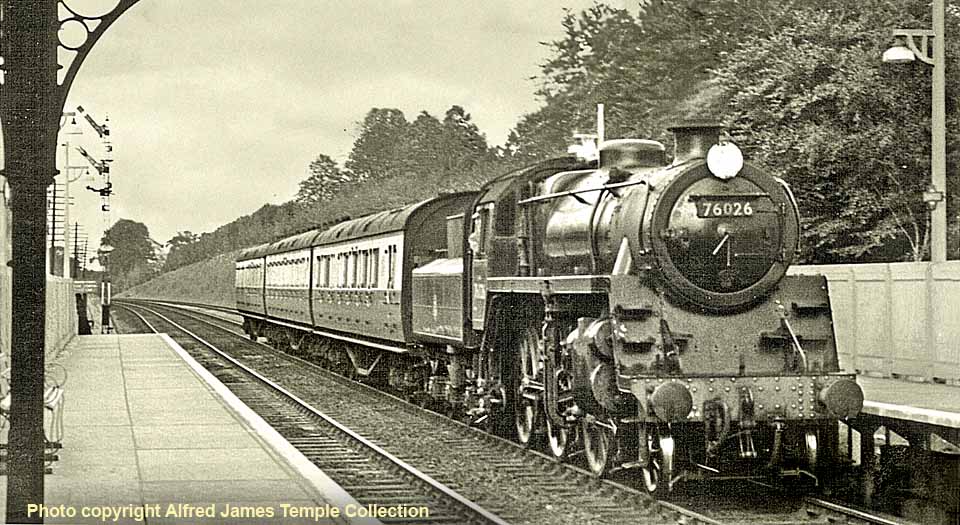
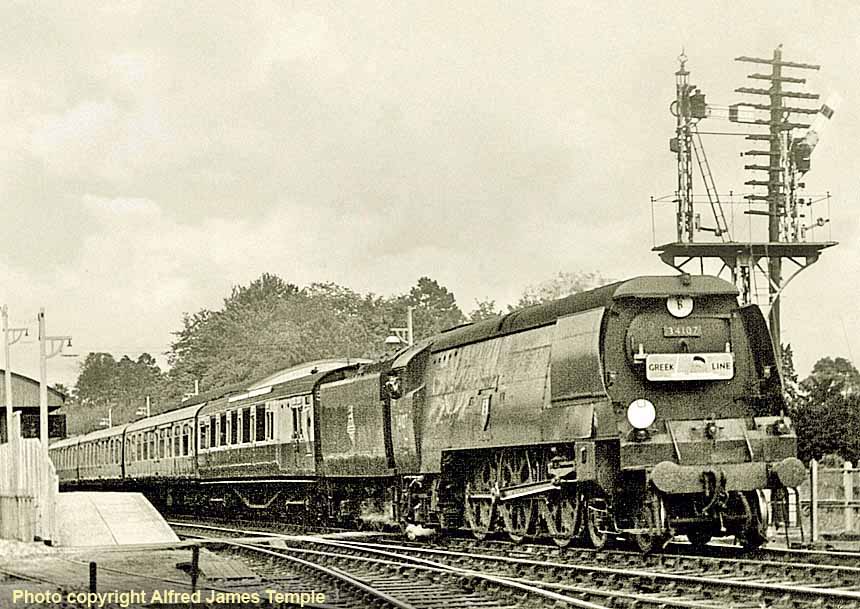
(Above) West Country Class 34107 'Blandford Forum' is authorised to pass Shawford's down starting signal at danger with the down 'Greek Line' from Waterloo to Southampton New Docks. (Below) Last One - No 83.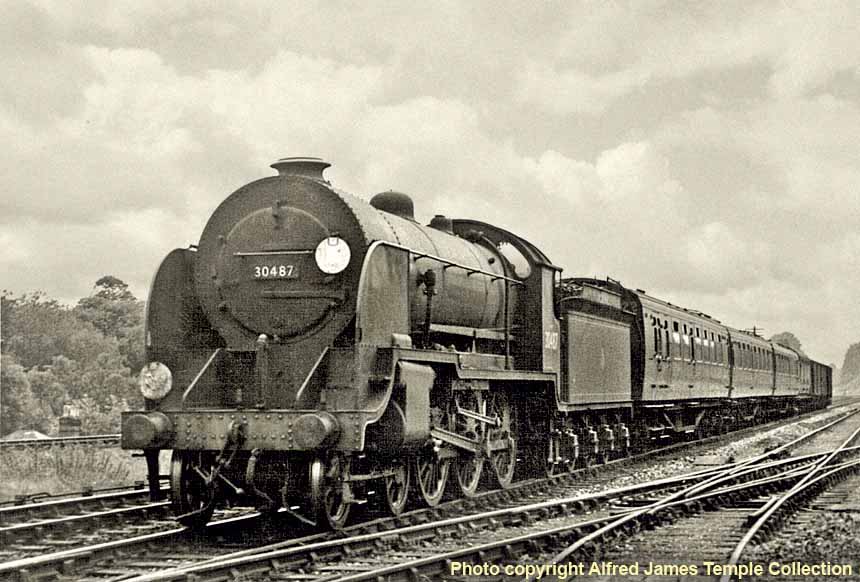
Dave (Sam) Salmon's Southern Region Rail Tours
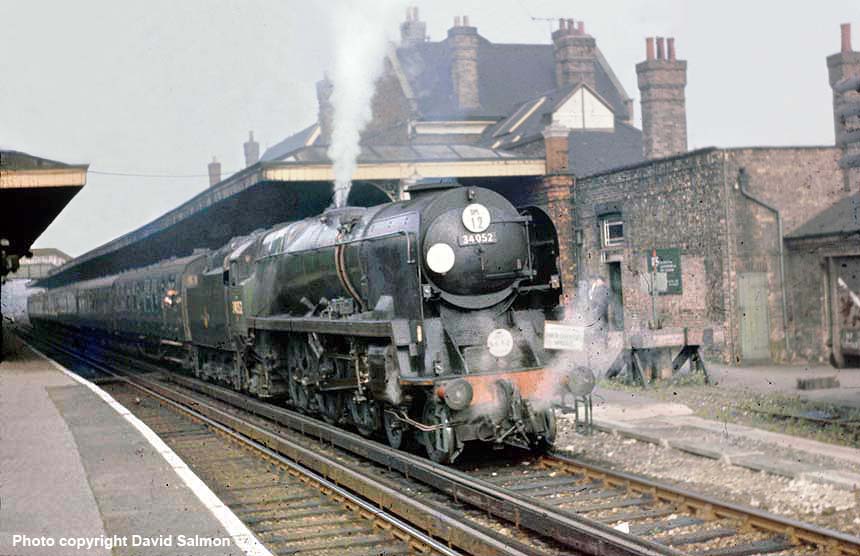
(Above) This photo shows 'Battle of Britain' Class 34052 ' Lord Dowding at Guildford heading an interesting SCTS 'Four Counties Special' Rail Tour to Salisbury via Guildford and Havant on 9th October 1966. Starting at London Bridge, BR Standard Class 4 No 80154 hauled the train via South Bermondsey, Peckam Rye, North Dulwich, Tulse Hill, Streatham. Tooting and Haydons Road to Wimbledon. The 2-6-4T then took the train via Merton Abbey to Tooting Goods, where USA 0-6-0T No 30072 hauled the train back to Wimbledon. 'Battle of Britain' class 34052 continued the journey via Raynes Park, Motspur Park, Epsom, Leatherhead, Effingham Junction and Horsley to Guildford, then on to Haslemere, Petersfield, Havant, Cosham, Fareham, Botley, Eastleigh, Chandlers Ford and Romsey to Salisbury. 'Merchant Navy' class 35023 was attached for the remainder of the tour from Salisbury via Andover Junction, Ludgershall, then back to Andover Junction for the return leg via Worting Jnct, Basingstoke, Mortimer, Southcote Jnct, Reading General Earley, 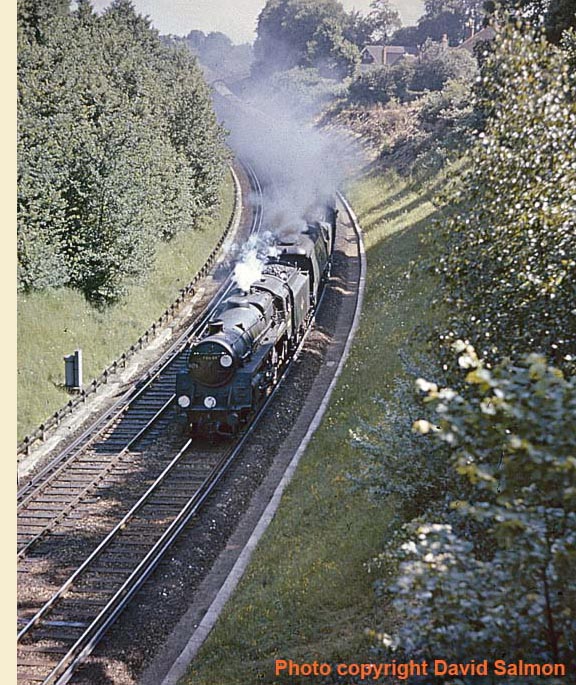 Wokingham, Blackwater, Ash, Guildford, Deepdene Dorking, Redhill, East Croydon, Selhurst, Streatham Common, Balham, Clapham Junction and Battersea Park to London Victoria (Eastern). This information was gleaned from the excellent 'Six Bells Junction' website which contains by far the best record of Rail Tour activity anywhere on the web. The same is said for the caption details Right and Below...
Wokingham, Blackwater, Ash, Guildford, Deepdene Dorking, Redhill, East Croydon, Selhurst, Streatham Common, Balham, Clapham Junction and Battersea Park to London Victoria (Eastern). This information was gleaned from the excellent 'Six Bells Junction' website which contains by far the best record of Rail Tour activity anywhere on the web. The same is said for the caption details Right and Below...
(Right) As a tribute to the final days of steam over the LSWR main line, the RCTS organised the 'Farewell to Southern Steam' Rail Tour on 18th June 1967. Dave Salmon's photo shows the first leg of the tour at London Road near Guildford. The twelve coach train was headed by 73029 and 34023 Blackmore Vale (the BR5 was crewed by Guildford Driver Lew Wooldridge and fireman Ray Bartlett and a pair of Nine Elms men worked on 34023). Starting from London Waterloo the special was routed (via Windsor through lines) to Clapham Junction - East Putney - Surbiton - Effingham Junction - Guldford - Haslemere - to Fareham. At Fareham 'Battle of Britain' class 34089 602 Squadron continued the journey via Netley to Southampton Central, where 34089 was joined by West Country class 34108 Wincanton for the journey from Southampton via Brockenhurst and Bournemouth to Wareham. At Wareham 34089 (with 80143 at the rear) headed to Swanage returning at the rear of 80146 to Wareham. 34089 then continued alone to Weymouth, where Class WCs Nos 34023 and 34108 headed the Rail Tour via Bournemouth Central, Eastleigh and Romsey to Salisbury. At Salisbury Merchant Navy class 35013 Blue Funnel headed the return leg via Basingstoke to London Waterloo. The info regarding this tour came from the excellent 'Six Bells Junction' website - click here - which also adds the note that apart from the Salisbury-Waterloo section the train running was hindered by poor timetabling, resulting in a number of stopping services being sent out in front of the special. 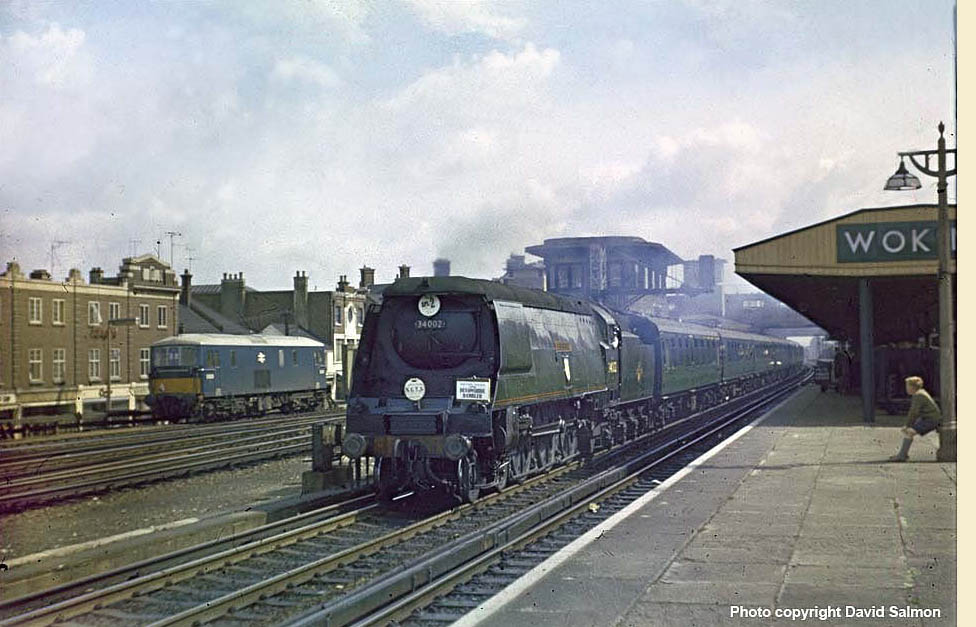 (Left) 'West Country' Class 34002 Salisbury is seen passing Woking Station at the head of the Southern Counties Touring Society (SCTS) 'Devonshire Rambler Railtour' on 26th June 1966. The 'WC' class departed London Waterloo at 9.55am and travelled via Clapham Junction, Earlsfield, Wimbledon, Surbiton, Woking, Basingstoke and Andover Junction to Salisbury, where 'Merchant Navy' class No 35023 Holland-Afrika Line continued the journey via Gillingham, Yeovil Junction, Axminster, Exeter Central, Exeter St Davids, Tiverton Junction, Taunton, Castle Cary and Frome, arriving at Westbury at 15.18. Another 'West Country' class, No 34100 Appledore then hauled the return leg from Westbury to Waterloo via Warminster, Salisbury, Dean, Romsey, Redbridge, Southampton Central, Eastleigh, Winchester City to Basingstoke, where a reversal of the outward route was taken back to London Waterloo, arriving at 18.40. Dave Salmon marked this slide - 'the last Exeter'...the tour itineraries in these captions were gleaned from the excellent 'Six Bells Junction' website.
(Left) 'West Country' Class 34002 Salisbury is seen passing Woking Station at the head of the Southern Counties Touring Society (SCTS) 'Devonshire Rambler Railtour' on 26th June 1966. The 'WC' class departed London Waterloo at 9.55am and travelled via Clapham Junction, Earlsfield, Wimbledon, Surbiton, Woking, Basingstoke and Andover Junction to Salisbury, where 'Merchant Navy' class No 35023 Holland-Afrika Line continued the journey via Gillingham, Yeovil Junction, Axminster, Exeter Central, Exeter St Davids, Tiverton Junction, Taunton, Castle Cary and Frome, arriving at Westbury at 15.18. Another 'West Country' class, No 34100 Appledore then hauled the return leg from Westbury to Waterloo via Warminster, Salisbury, Dean, Romsey, Redbridge, Southampton Central, Eastleigh, Winchester City to Basingstoke, where a reversal of the outward route was taken back to London Waterloo, arriving at 18.40. Dave Salmon marked this slide - 'the last Exeter'...the tour itineraries in these captions were gleaned from the excellent 'Six Bells Junction' website.
(Below) The first of the BR Standard locomotives, Britannia Class 7MT Pacific No 70000 is seen departing from Guildford under Yorkies Bridge at the start of the climb up Pinks Hill on the Cuildford-Reading line. No 70000 was taking part in the Locomotive Club of Great Britain (LCGB) Vectis Rail Tour on the 4th October 1964. The train had started from Waterloo behind Bulleid's Class Q1 No 33026 for the outward journey via Clapham Junction, Twickenham, Staines Central, Ascot, Camberley, Ash Vale, Aldershot and Ash to Guildford, where 70000 took over for the run via Ash, North Camp, Wokingham, Reading General, Basingstoke, Winchester City, Eastleigh, Botley, Fareham and Cosham to Portsmouth Harbour. Scheduled boat sailings were used to ferry tour participants to and from the Isle of Wight for a tour of the Isle of Wight lines behind Stroudley's celebrated Class E1 0-6-0Ts Nos 14 'Fishbourne' and 28 'Ashey'. 70000 headed the return leg from Portsmouth Harbour to Waterloo.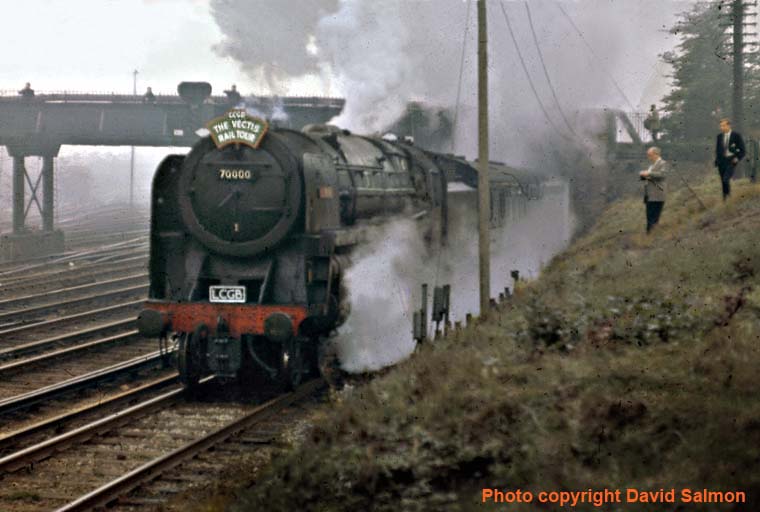
My First Firing Turn 1958
by Pat Kinsella
When I attended the Firing School at Guildford, the classroom work was very comprehensive on the rules  and regulations but it provided very little in the way of instruction on a locomotive. After a fortnight at the school, apart from a couple of hours spent on engine disposal, I still had no tangible footplate experience on the running line, therefore practical skills had to be gained on the hoof so to speak.
and regulations but it provided very little in the way of instruction on a locomotive. After a fortnight at the school, apart from a couple of hours spent on engine disposal, I still had no tangible footplate experience on the running line, therefore practical skills had to be gained on the hoof so to speak.
After passing the exam to act as firemen when required, my colleagues and I returned to our cleaning duties at 70C and regularly speculated on who would be our first Driver and what the duty might be. Rumours abounded about the various Drivers - some good, some bad and others reputed to be terrifying! Of course there was always the chance we might be booked 'on loan' to another depot and God 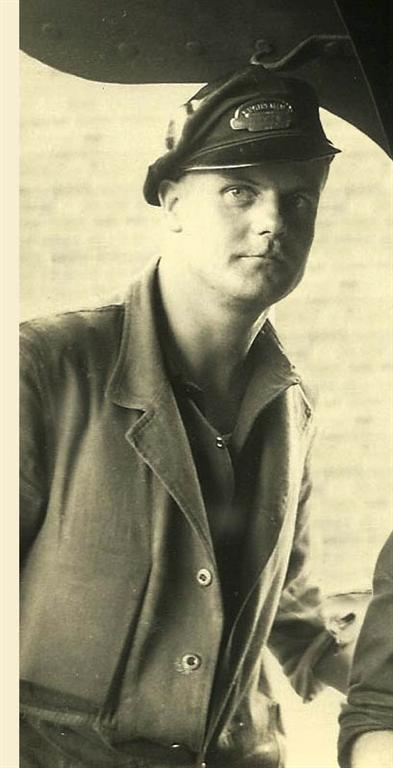 only knew the temperament of a 'foreign' Driver.
only knew the temperament of a 'foreign' Driver.
So it was in this atmosphere of uncertainty that we daily scanned the 'alteration sheet' to see who amongst us had been booked a 'running turn' which were allocated on a seniority basis.
Come the day, it happened to me on a Friday when the Sunday sheet was posted and I was alarmed to find I had been booked a 'special'...
Crikey! A special! What would that entail?
My mate was to be Driver Davey (featured Right) whom I had seen several times in passing whilst working at the shed but never had the novelty of speaking to him; we were booked to travel passenger to Waterloo to relieve on a BR Standard Class 5 locomotive with empties to Clapham Junction then take her to Nine Elms and dispose of her before returning to Guildford on the Monday morning 3.40am paper train.
Reporting at the Guildford office at the appointed time, I met Brian Davey (then in his mid-twenties) whose first question was - 'Have you a tea can?'
Oh yes, I was well prepared in that line! I had a billycan, tea, milk and sugar, and plenty of it!
Brian turned out to be very pleasant and as we travelled to the Capital he put me in the picture as to our duty. At Waterloo, we waited for the arrival of our charge from Southampton docks, and on seeing her elegant entry into that great station amid other locomotives on adjacent platforms was a great thrill. Here was I just sixteen years-old and already part of a great organisation. All went well on our trip to the 'Elms', and after disposing of our loco, we were requested to take an 'N' class light to Guildford. This was much better than travelling home passenger I thought and so whilst Brian went to the stores to get some engine oil, I undertook my duties preparing the loco (it was in a dreadful state) and on his return I enquired what time we were booked to leave. 'Just as soon as you're ready,' he replied.
As soon as I was ready?
Crikey, up to that point I'd always thought everything ran to a timetable, but it was all down to me!
My head started to swell with the importance of it all...and having not the faintest idea of how much coal to put in the firebox I shovelled like hell, while softly humming Tony Bennett's - 'Stranger in Paradise' - which, in my mind's eye, is exactly where I was... 'I'm a stranger in paradise; all lost in a wonderland....' Meanwhile Brian finished his oiling, and on regaining the footplate, realised the situation and stopped me from emptying the tender!
Departing Nine Elms at 2am we were signalled down the main slow line for the entire journey, but even before we reached Clapham Junction I was starting to get alarmed; our charge was riding like a jackass with a nettle under its tail! Leaving that great junction behind, Brian increased speed to an alarming level, which, in reality, was probably no more than fifty, but to me it seemed like a ton! All I could do was grab hold of the handrail and watch our bucking bronco - I'm reluctant to call it a locomotive - oscillating from side to side while the tender made a snapping motion at the cab floor, disgorging coal around our ankles. The wheels on  this thing were not wheels; they were shaped like three-penny bits...it was the sort of ride that a thrill-seeker would have paid dearly for in a fairground. Bouncing up and down off the cab floor I could just about reach the injector steam valve with my right hand whereas the white knuckles of my left hand exposed my terror as I gripped on for dear life to the handrail. I was scared out of my wits, yet as I glanced towards Driver Davey desperately seeking reassurance all he gave me was an occasional smile!
this thing were not wheels; they were shaped like three-penny bits...it was the sort of ride that a thrill-seeker would have paid dearly for in a fairground. Bouncing up and down off the cab floor I could just about reach the injector steam valve with my right hand whereas the white knuckles of my left hand exposed my terror as I gripped on for dear life to the handrail. I was scared out of my wits, yet as I glanced towards Driver Davey desperately seeking reassurance all he gave me was an occasional smile!
Why's he bloody smiling in a crisis like this? He's insane! I'm booked with a madman on my first running turn...bloody office staff must have done this on purpose! Surbiton was passed in a flash, then Walton on Thames semaphores came and went - still clear signals - Weybridge, West Weybridge* then West Byfleet; semaphores all clear, oh my goodness, will this never end? Staring goggle eyed into the distance I could distinguish yellows at Woking...speed was reduced to 20mph through the junction - thank God for that, I thought! But no sooner had we emerged from the 'Twin Bridges' by Woking Junction, steam was again applied to the cylinders with a will that would've put a Virgin Soldier to shame on his first date.
Brian shot me another pathological smile! For God's sake what is the matter with this man? Can't he see I'm bloody terrified? Descending Stoughton bank into Guildford I could just make out the distant blur of the Cathedral and recognised where I was (no tower or Angel in those days mind you). Then reducing speed appropriately we passed under 'Yorkies' bridge and our charge settled down to a dignified canter through the platform and into the tunnel, where the unique tunnel signal displayed clear, ready for the shunt back into the loco.
We had made it! But the relief I felt was mixed with the nagging uncertainty that the career I had chosen might not be the right one for me after all; I had serious doubts that I was equipped to make it as a fully fledged engineman and promised myself that after I had 'squared up' I would go home and write out my resignation then hand it in later in the day. But after sleeping on it, I decided to give it another try and how glad I am that I did.
Brian, I later realised, was only doing what was an everyday occurrence to him but it was my first experience on a loco at speed.
He is still fit and healthy and I occasionally see him, but he doesn't remember the episode; it was just another job to a professional engineman but a wealth of experience for me. (* West Weybridge was renamed Byfleet and New Haw in 1961).
(Above Left & Below) The last two N class locos to be withdrawn from traffic were 31405/08 in June 1966. No 31408 is seen at Worplesdon working light engine to Guildford on 25th April 1965. (Below) Caught by the late afternoon sun at Guildford shed in June 1966, you could easily mistake this for a Dave Shepherd original oil painting on canvas....a grimy-looking 31405 is caught by the camera just days before withdrawal.
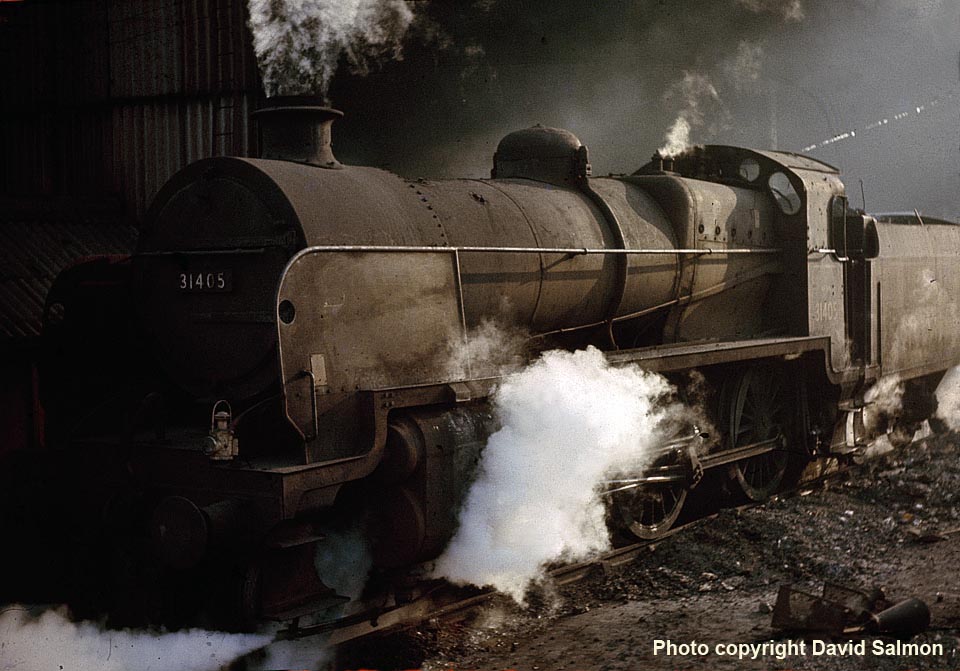
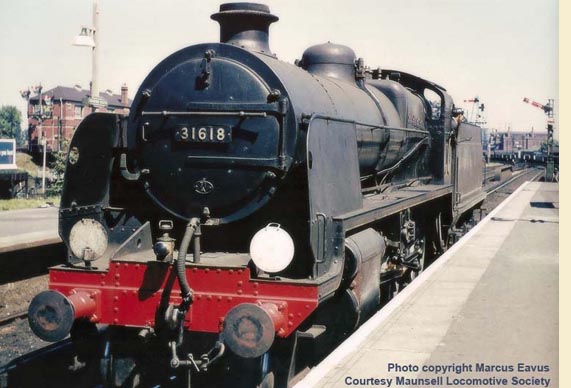 (Left-Below) These photos were sent to me by Mike Frackiewicz (historian of the Maunsell Locomotive Society) and features the Society's now-preserved Class U 31618 at Reading South station in the summer of 1959; this is a rare gem as there aren't many photos of this quality around of Reading South station. Since Reading South was a terminus station, the locomotive has just been released from its train and is about to run light loco to Reading MPD to turn, take water and be prepared for its return working to Redhill. (Below) 31618 apprached Betchworth station with a Redhill-bound service from Reading in May 1963. The Maunsell Locomotive Society is based at the Bluebell Railway in Sussex England where it has five engines designed by Richard Maunsell in various stages of restoration; 3 are fully restored, one is underway and one remains in scrapyard condition. Click here for a link to the Society's website.
(Left-Below) These photos were sent to me by Mike Frackiewicz (historian of the Maunsell Locomotive Society) and features the Society's now-preserved Class U 31618 at Reading South station in the summer of 1959; this is a rare gem as there aren't many photos of this quality around of Reading South station. Since Reading South was a terminus station, the locomotive has just been released from its train and is about to run light loco to Reading MPD to turn, take water and be prepared for its return working to Redhill. (Below) 31618 apprached Betchworth station with a Redhill-bound service from Reading in May 1963. The Maunsell Locomotive Society is based at the Bluebell Railway in Sussex England where it has five engines designed by Richard Maunsell in various stages of restoration; 3 are fully restored, one is underway and one remains in scrapyard condition. Click here for a link to the Society's website.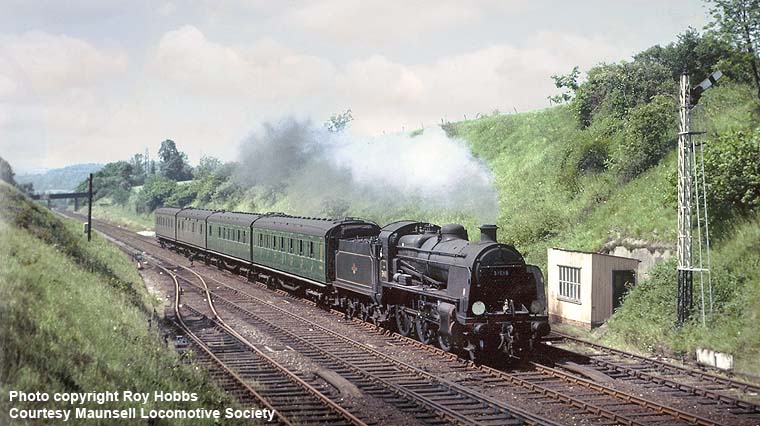
Driver Reg Howard's Last Day
by Roger Hope
I am pleased to include this story from the personal records of Roger Hope, who recounts his experience of firing the 'Bournemouth Belle' on Friday 6th April, 1966; this gem of a tale from steam footplate days is just one of many anecdotes that Roger kept of all of the firing turns he performed at Guildford Loco over the years. Roger started firing in 1964 in what was called 'The Old Man's Gang' along with Driver Jack Blackman. This consisted of working local freight work and shunting in all the local yards; you'll find photos of this turn featured on the previous page...'Ramblings of a Railwayman'. In 1965, Roger moved into number 2 link and regularly worked with Driver Jim Wattleworth although on occasions he was replaced by other Drivers since Jim's experience with Electric Traction meant he was often utilised for this work. I'll let Roger take up the story below...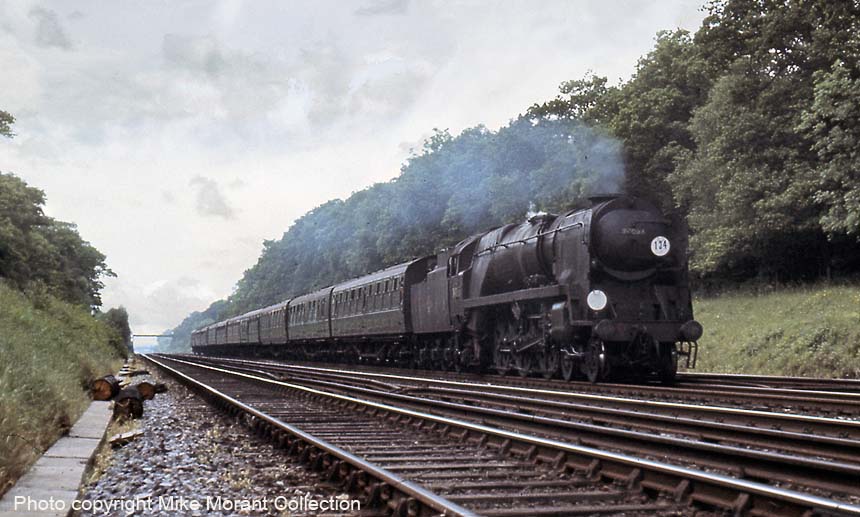
Class 7P5F 'West Country' class 34093 Saunton heads a 'down' train at Hook on 10th June 1966
....On Friday the 8th April 1966, my regular driver Jim Wattleworth was covering an Electric Traction turn and I was booked 10:00 spare. However, having arrived at Guilford Loco, Cyril Tillman, the Running Foreman came into the Driver's room and asked me to go along with Driver Reginald (Reg) Howard, who was retiring that day and this was to be his final turn of duty, but the fireman booked with him (John Gardner) had failed to turn up.
Reg and I walked over onto Guildford station platform and caught the 11:18 train to Waterloo which was formed of a 12 COR (Nelson) stock. As we took our seats he enquired if I'd done much firing on Merchant Navy class locomotives...
'A fair bit,' I said.
'Good!' he replied - 'Because we're down with the 12:30 'Bournemouth Belle' via the Portsmouth direct line to Southampton via Havant and Fareham.' For the record, Guildford men had been booked the duty because of diversions due to Engineering Work on the Main Line.
On reaching Waterloo, Reg and I walked up platform 13 to where the train was standing to a Nine Elms crew, but instead of the usual Merchant Navy Class 8P coupled to the train we had Class 7P5F WC 34093 'Saunton'. As we climbed up on the footplate, Reg asked - 'Why have we got a West Country class instead of a Merchant Navy?'
The reply was - 'That's all they had at Nine Elms as it was Good Friday'.
Cobblers! Both Reg and I knew they had deliberately given us an underpowered engine as they didn't like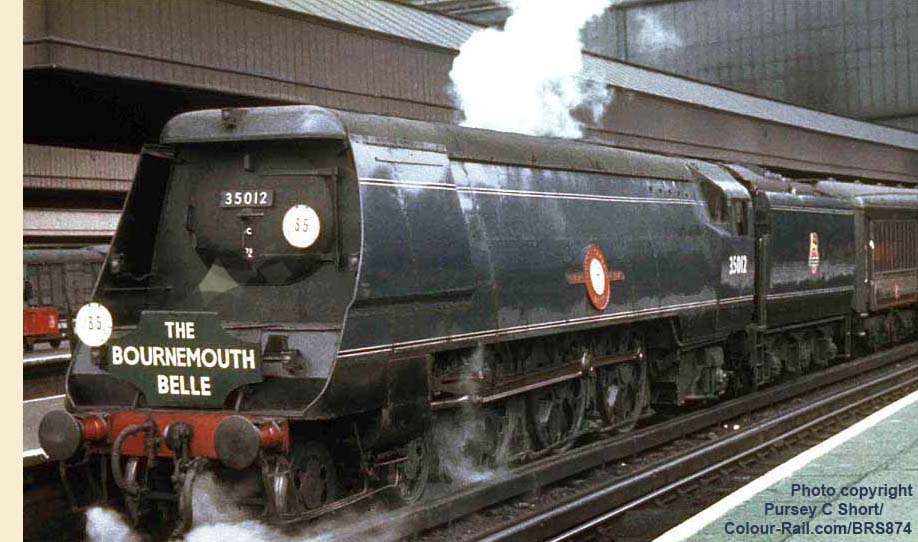 Guildford men working the 'Belle', which, at this time was a Bournemouth duty.
Guildford men working the 'Belle', which, at this time was a Bournemouth duty.
So with little more than fifteen minutes to go before starting time I checked the water level in the boiler which was about half full and the pressure gauge was about 160psi. I looked in the firebox and the fire was black so I put the blower on full and roused the fire with the dart. By starting time I had managed to fill the boiler to three quarters full and the pressure gauge was on 220psi.
(Inset Above-Inset Below) Sporting the early British Railways standard blue livery, Merchant Navy class Pacific No 35012 United States Line awaits departure from Waterloo for the Hampshire coast with the 'down' Bournemouth Belle Pullman train in June 1951. (Below) Fast-forward to February 1957, and the SR's Pacifics' original air-smoothed casing has gone; the 30-strong Merchant Navy class was rebuilt at Eastleigh between 1956 and 1959. The work included the removal of the troublesome chain-driven valve gear (encased in an oil bath) to be replaced by the conventional outside Walschaerts valve gear. (Below-Left) No 35014 Nederland Line heads the 'down' train out of Southampton. Both images can be found on the page featuring the Colour-Rail collection (next page). Reg told me to look back for the tip from the Guard as we had a green signal with an MT (Main Through) indication. On receiving the station staff's tip to go, Reg opened the regulator and the engine responded by slipping violently on the greasy rails. He eased the regulator and with the Standard tank pushing us at the rear we managed to leave Waterloo. I opened the firehole door and stuck a few shovelfuls round the firebox and as we passed Vauxhall the steam pressure gauge dropped back slightly to 200psi. However, as Reg closed the regulator to coast round Clapham Junction, the safety valves lifted so I put on both injectors to replenish the boiler. As we rounded Clapham Junction, Reg opened the regulator again and I turned off the injectors and started shovelling again. Then as we passed Wimbledon, the pressure gauge read 220psi and as we went through Weybridge we were travelling at 80mph.
Reg told me to look back for the tip from the Guard as we had a green signal with an MT (Main Through) indication. On receiving the station staff's tip to go, Reg opened the regulator and the engine responded by slipping violently on the greasy rails. He eased the regulator and with the Standard tank pushing us at the rear we managed to leave Waterloo. I opened the firehole door and stuck a few shovelfuls round the firebox and as we passed Vauxhall the steam pressure gauge dropped back slightly to 200psi. However, as Reg closed the regulator to coast round Clapham Junction, the safety valves lifted so I put on both injectors to replenish the boiler. As we rounded Clapham Junction, Reg opened the regulator again and I turned off the injectors and started shovelling again. Then as we passed Wimbledon, the pressure gauge read 220psi and as we went through Weybridge we were travelling at 80mph.
Reg closed the regulator at West Byfleet, whereupon the safety valves lifted again - one injector on and three-quarters of a boiler full of water. Running through Woking, Reg observed that we had a green signal with diversion lights for the Portsmouth Direct. By now the locomotive was steaming well and as we ran into Guildford, the pressure gauge was on the mark at 240psi and the boiler was full. I blew the whistle as we passed the loco and received a wave from the shed staff before entering the chalk tunnel. As soon as we came out of the sand tunnel, I started firing like mad as it's a very heavy road to Haslemere. We went round Farncombe to Godalming where there is a speed restriction of 60mph and Reg opened the regulator fully. The fire was white hot and as I kept shovelling, the pressure was holding with one injector on all the time.
As we passed Witley Reg said - 'Here we go boy!' and began the stiff climb of the bank to Haslemere. On reaching the road bridge at the top of the bank we had slowed to about 30mph, whereupon Reg eased the regulator for the downhill run to Liphook. As we did so, the safety valves lifted again and I regained a boiler full of water. As we passed Petersfield station, it was then uphill to Buriton tunnel and then downhill again to Havant and as we ran through Rowland's Castle station, Reg actually had a smile on his face!
We passed through Havant on the Through Road (now removed) and as we passed through Hilsea halt, Reg said to me - 'Keep a look out for the signal at Farlington Junction that will take us on to Cosham...' Once we were passed the junction, I started firing again and as we passed Fareham, the safety valves lifted again - we were having a really good trip.
We progressed on towards Woolston curve and then slowed again for Northam where we rejoined the main line. The next thing we were going round the sharp curves into the tunnel at Southampton and running into Southampton station, where Reg stopped the engine to replenish water at the end of the platform, with the Bournemouth crew waiting to relieve us. I climbed onto the tender to put the pipe in and the Bournemouth fireman turned the water on. Whilst the tender was filling, I also pushed coal the forward. It didn't take long for the tender to fill and when the water column valve had been turned off I lifted the pipe from the tender and returned it back to its normal position.
We grabbed our bags, and after bidding farewell to the Bournemouth crew, Reg said to me - 'Well done son, good trip!' Then we headed to the mess room on the platform, had our meal break and then relieved an Up train to London with a Class 4MT Standard...but that's another story.
Eventually, we returned to Guildford Loco and a lot of men shook Reg's hand and said their goodbyes including myself. I never saw Reg again. However, I still keep in contact with Jim Wattleworth who has now retired and living on the Isle of Wight. I hope that someday I might see a photograph in a Railway magazine or Railway book of 'The Bournemouth Belle' on Good Friday 8th April 1966....'
Well you never know your luck! The worldwide web is a wonderful resource. I'm sure there is someone out there who can fulfil Roger's wishes...it would be much appreciated. My email address is at the bottom of the page...
(Below) S15 Class 30837 comes to a stand at Bentley after completing the first leg of the S15 Commemorative Rail Tour (Waterloo - Bentley) on 16th January 1966. On the left, U Class 31639 waits in the Up platform to work the second leg from Bentley to Bordon and return. Route restrictions on S15 Class locomotives over the Bordon branch necessitated the change of locomotives. Due to demand for tickets, this was a duplicate of the tour which ran on 9th January 1966. This is the snowy scene at Bentley with 30837 attached to the eight coaches and 31639 waiting to take the tour to Bordon.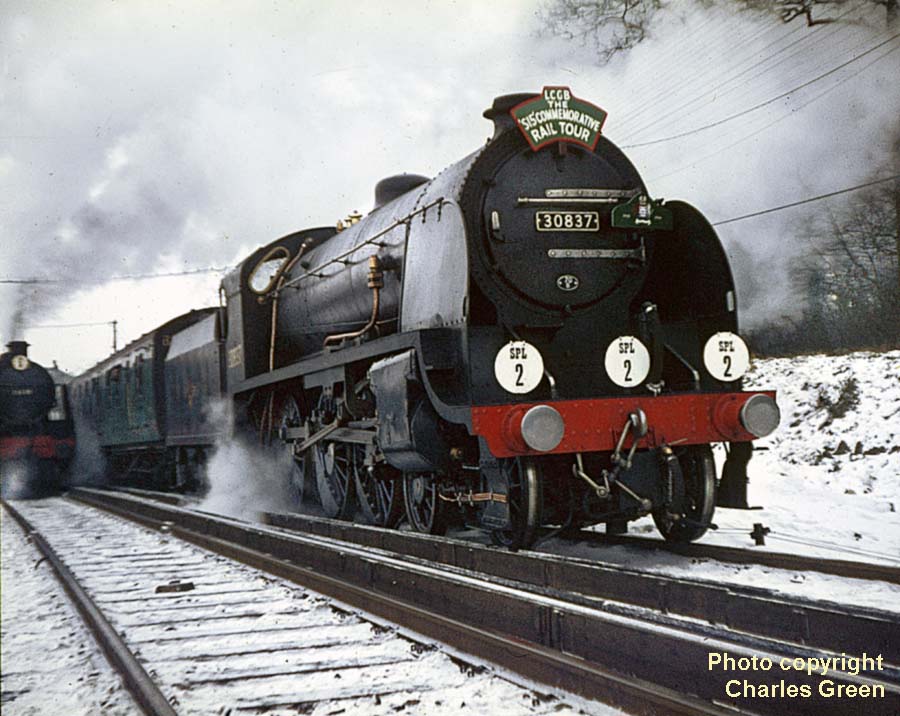
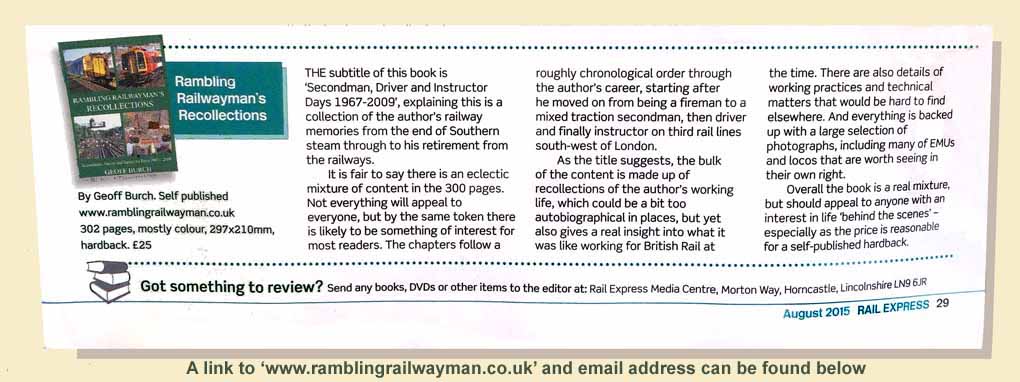
Geoff Burch's contact details can be found HERE.
Polite notice: All text and photographs are protected by copyright and reproduction is prohibited without the prior consent of the © owners. If you wish to discuss using the contents of this page the email address is below. Please note - this is not a 'clickable' mail-to link via Outlook Express. You will have to email manually.
dheycollection@ntlworld.com




